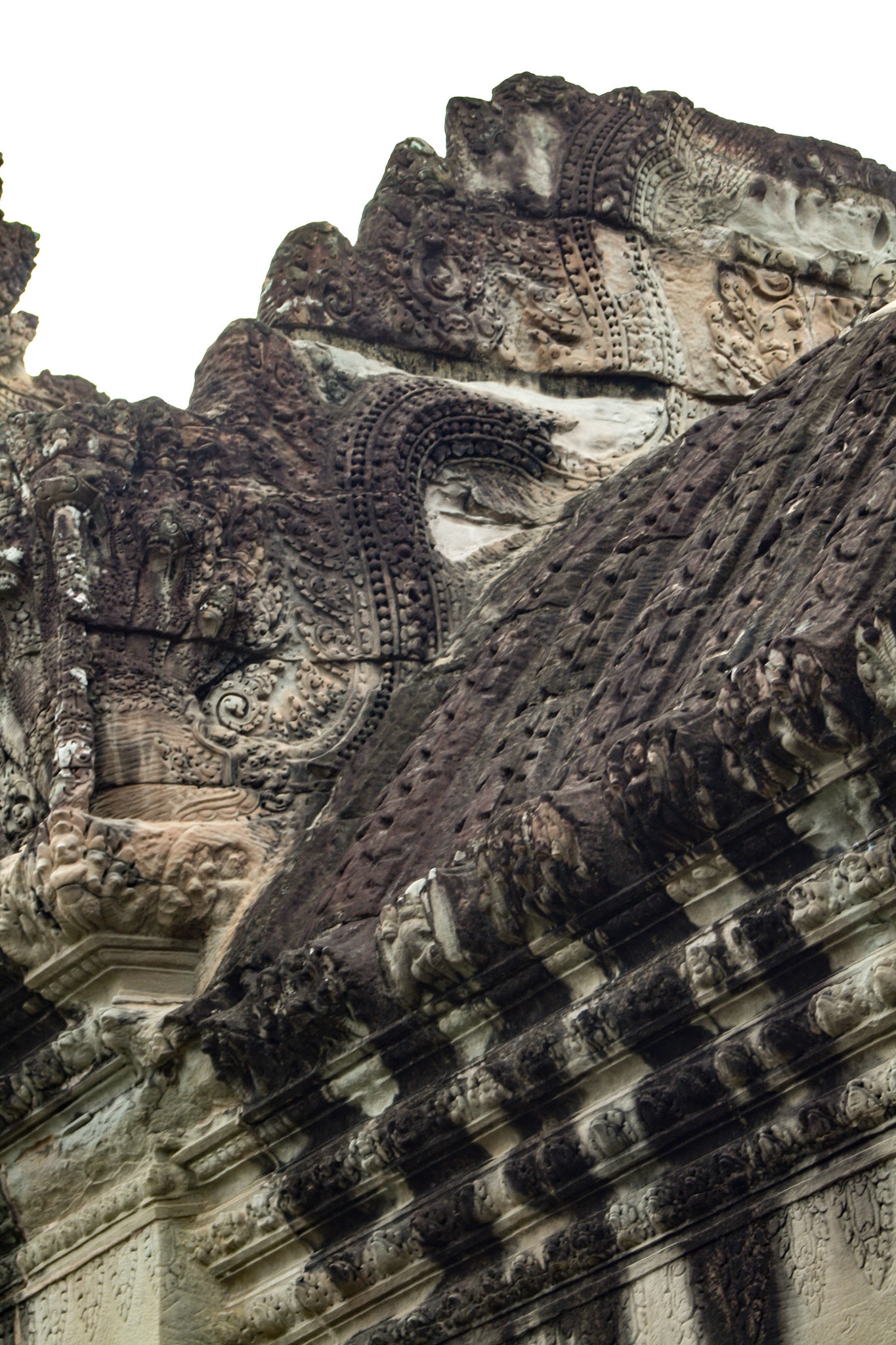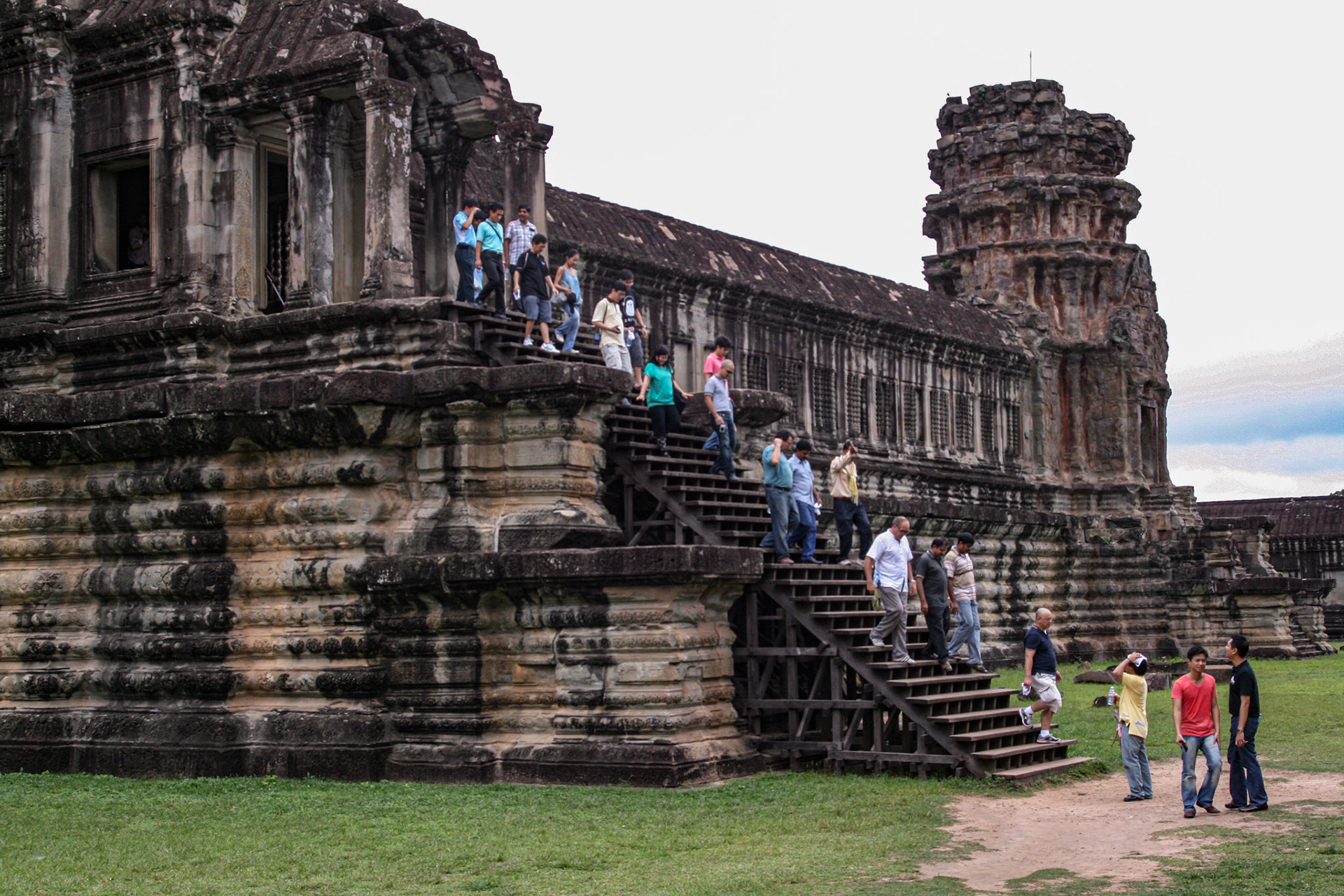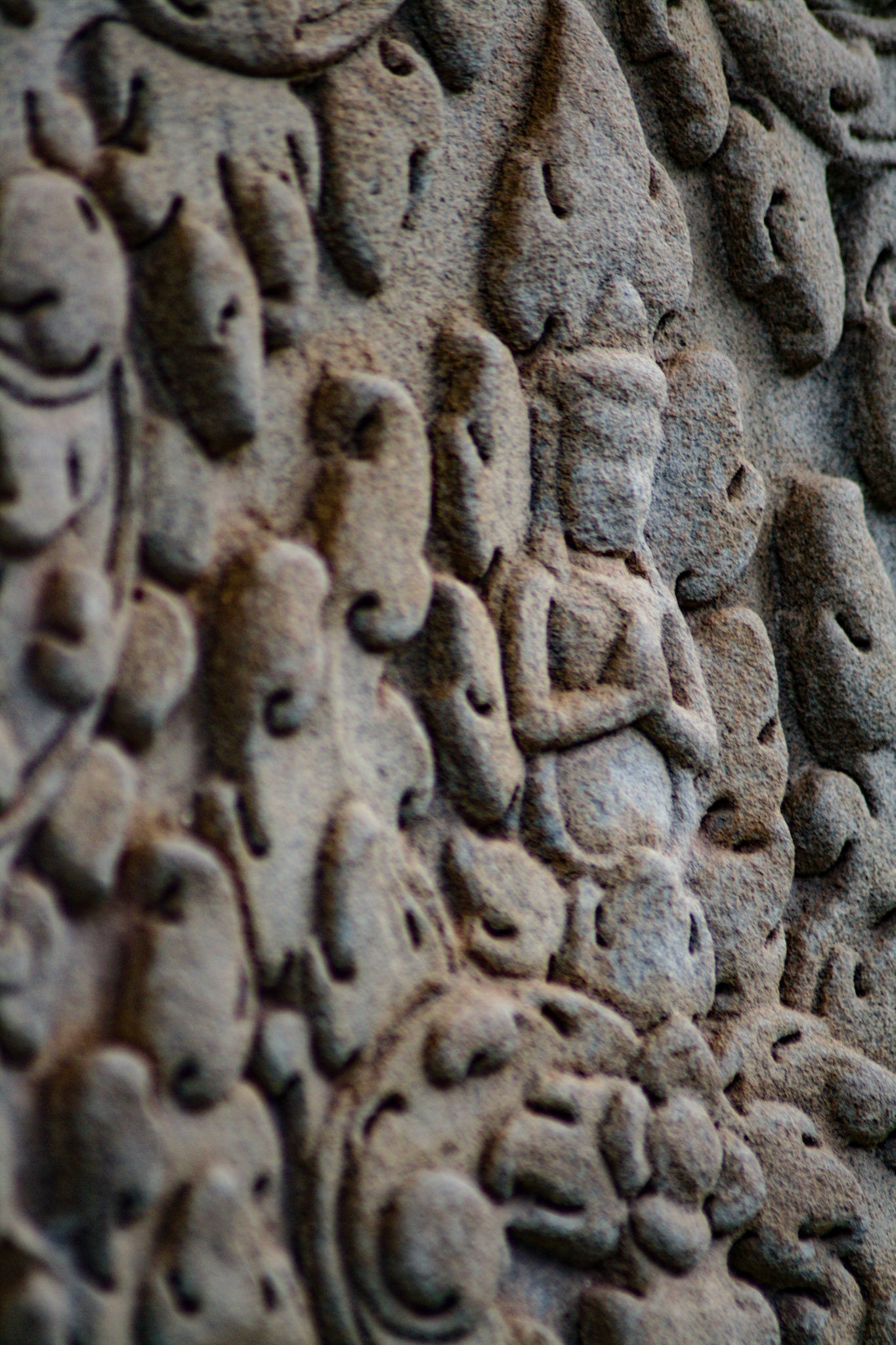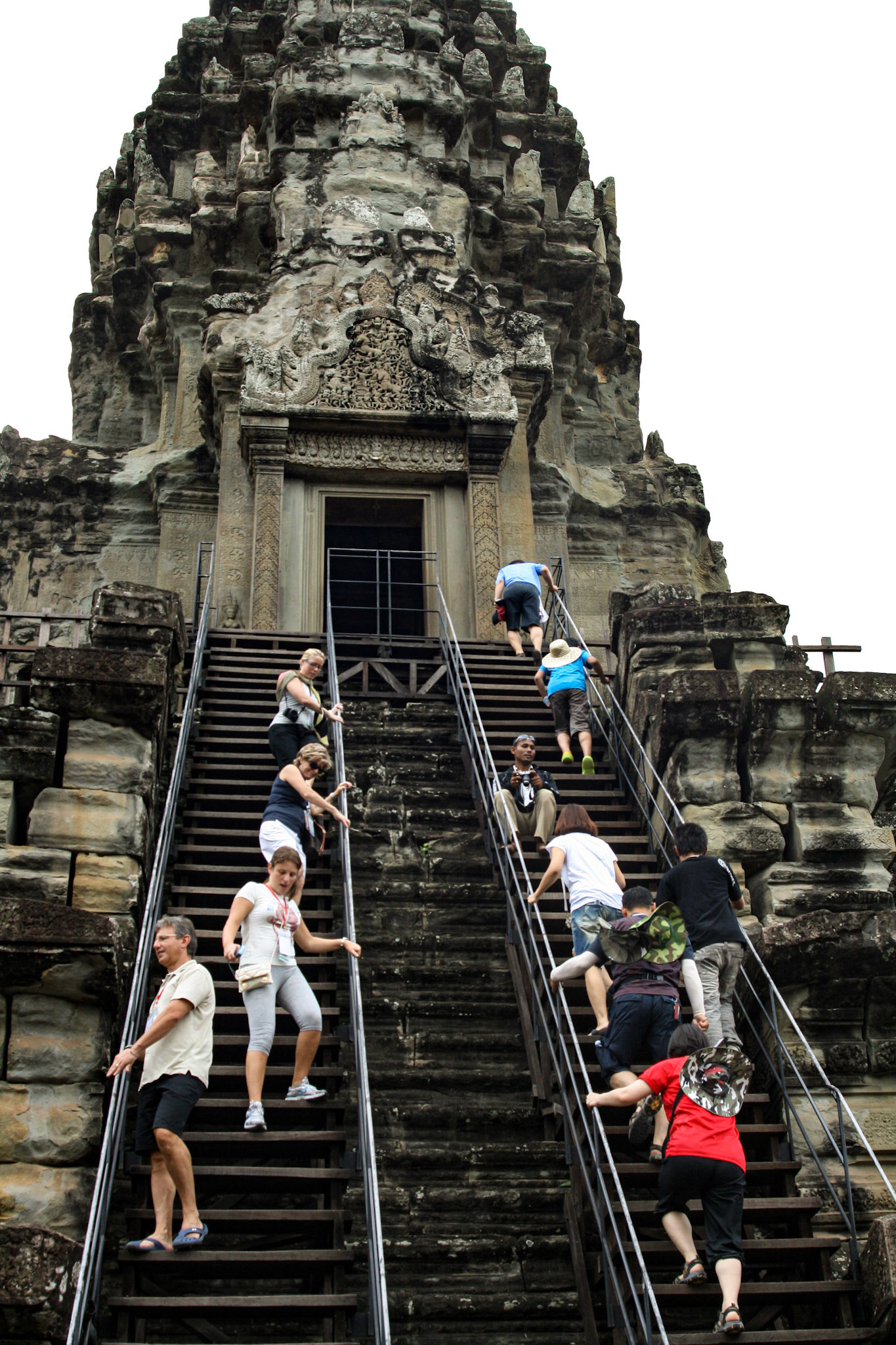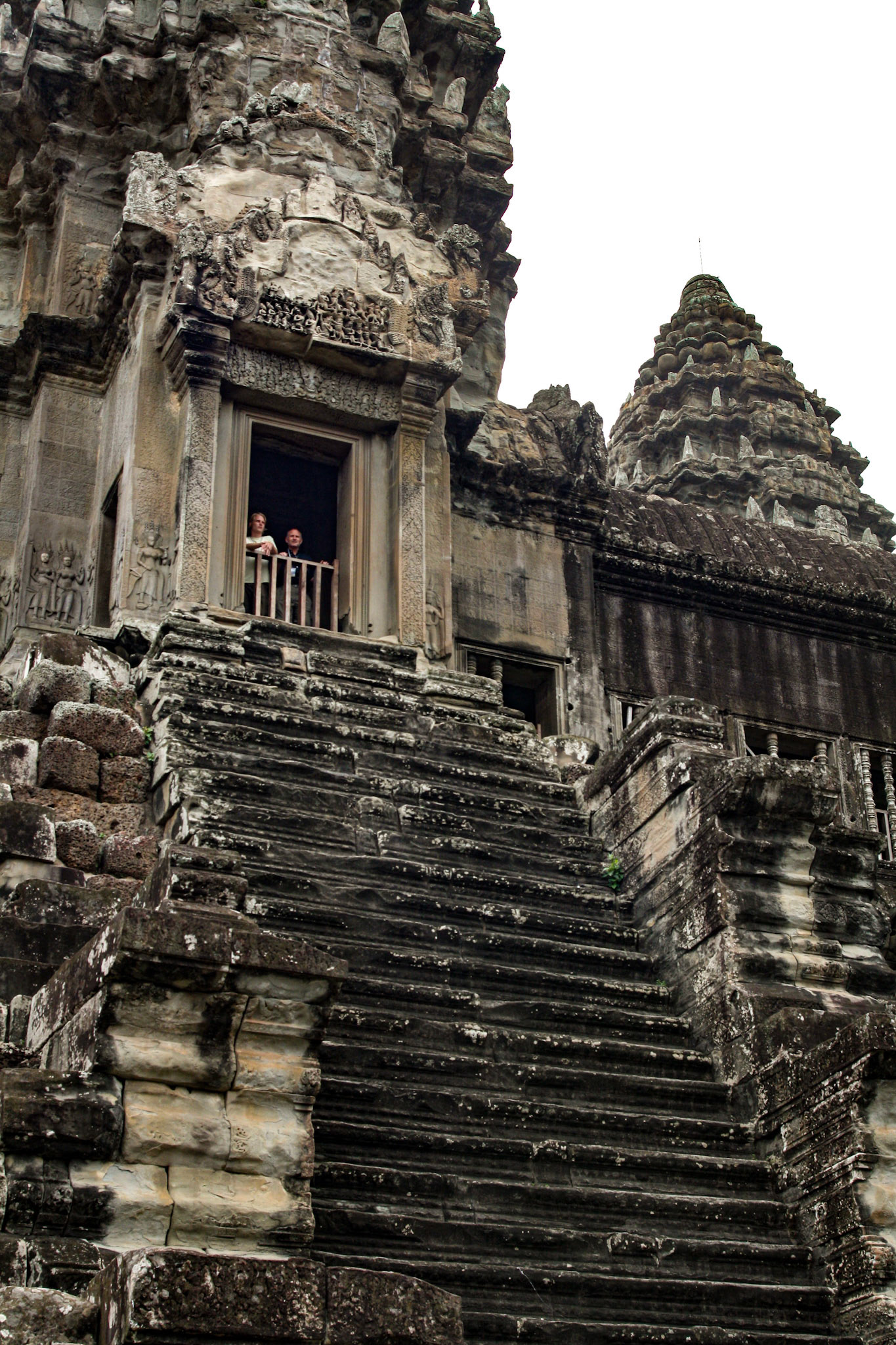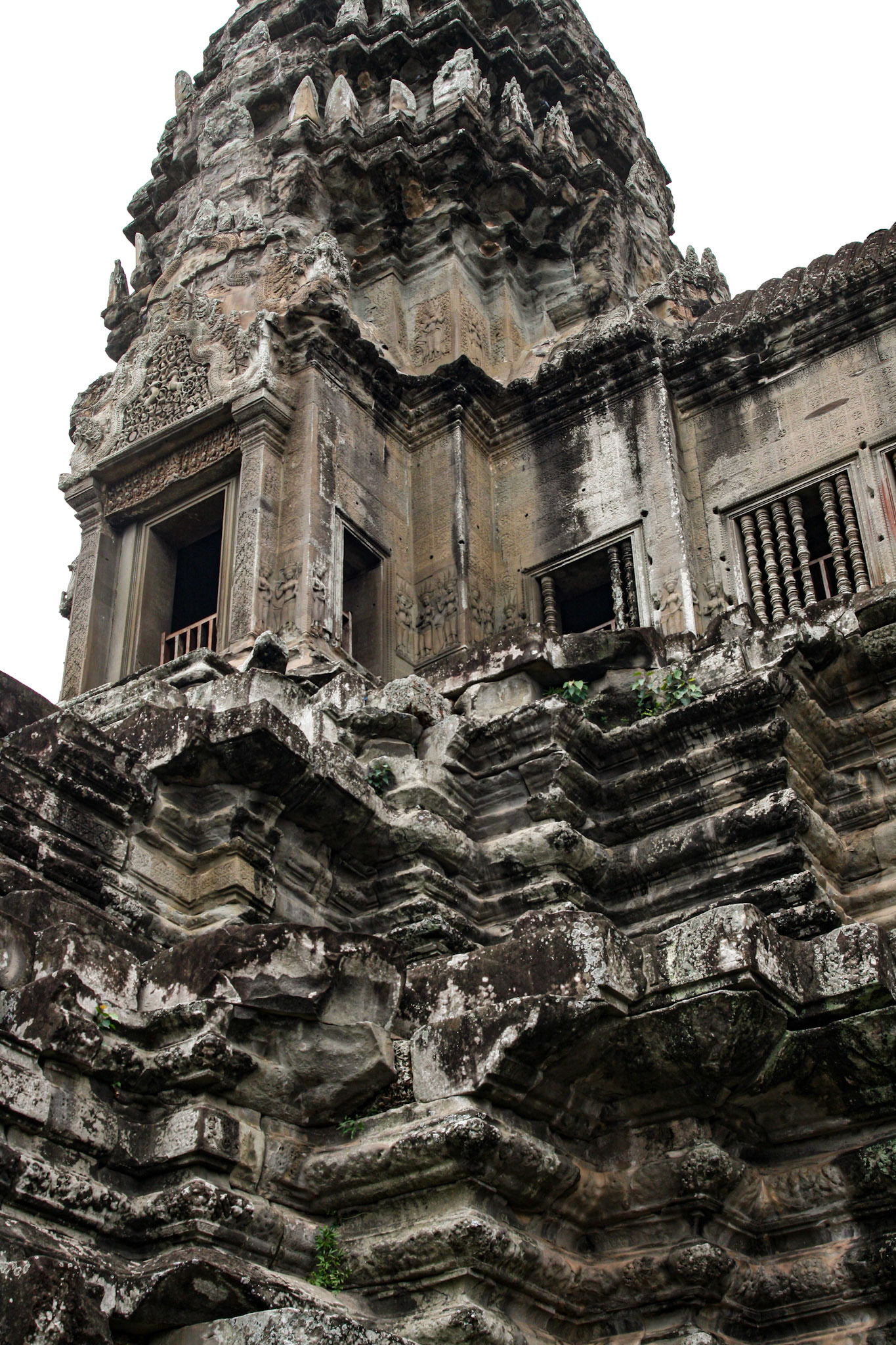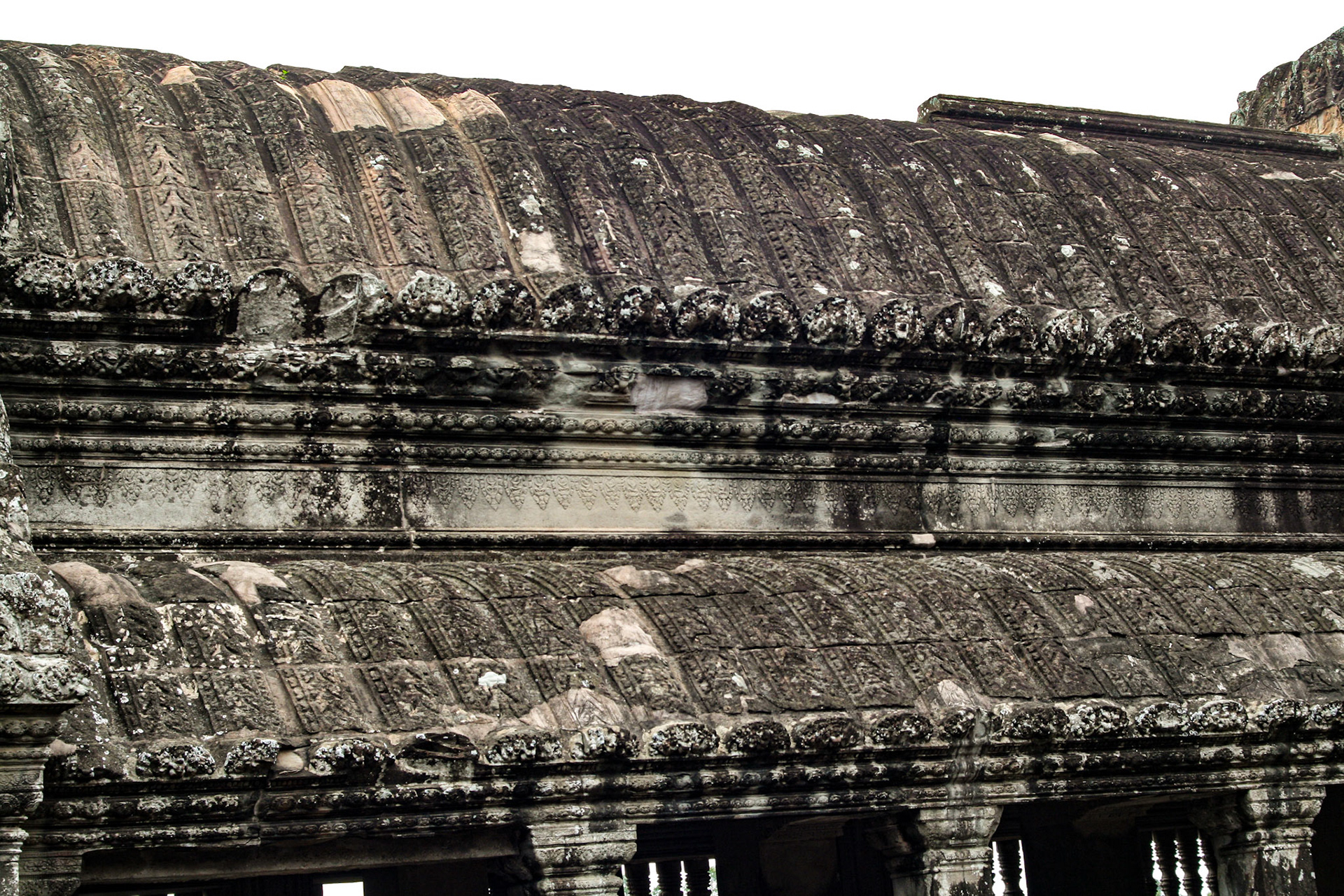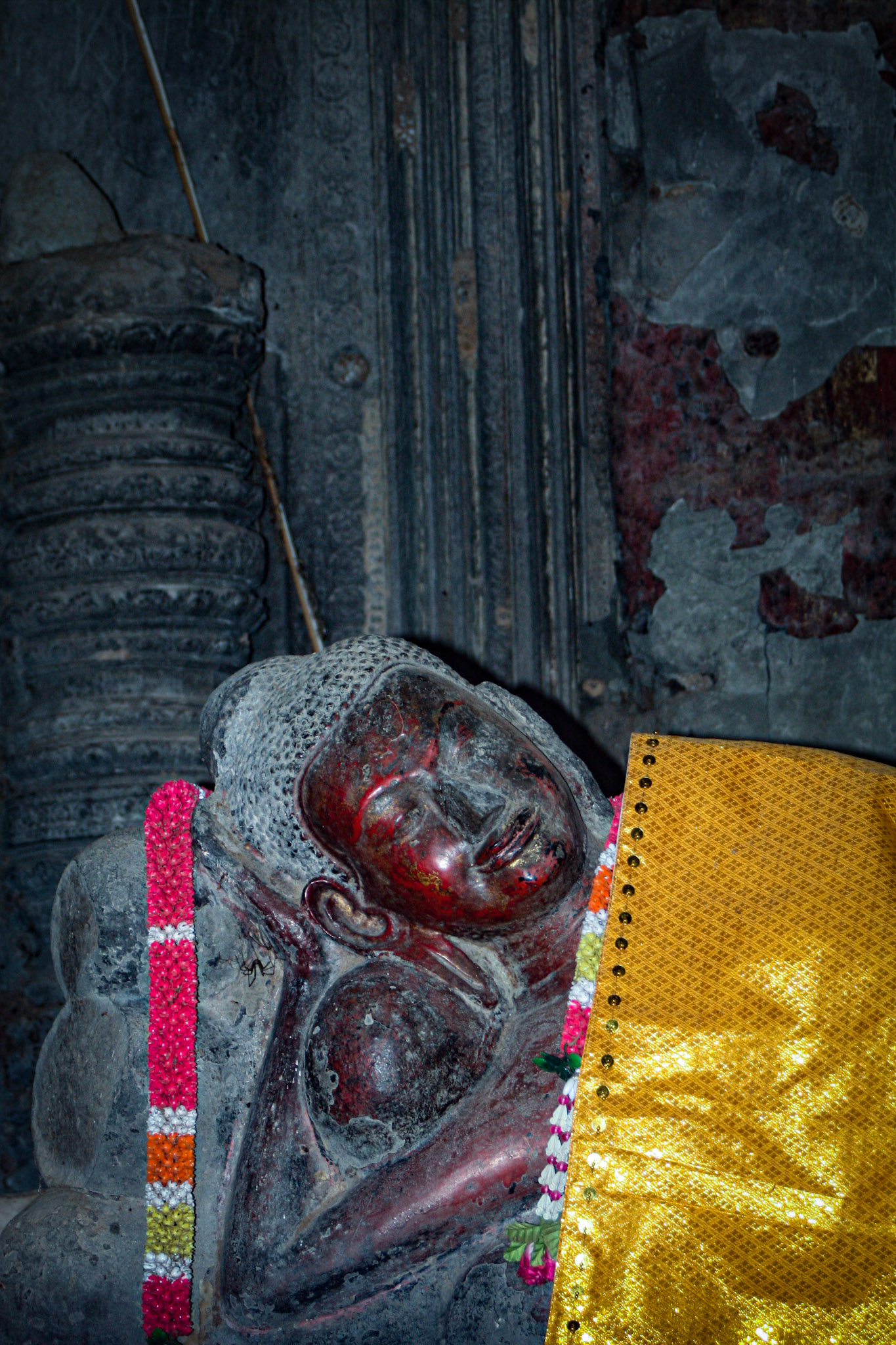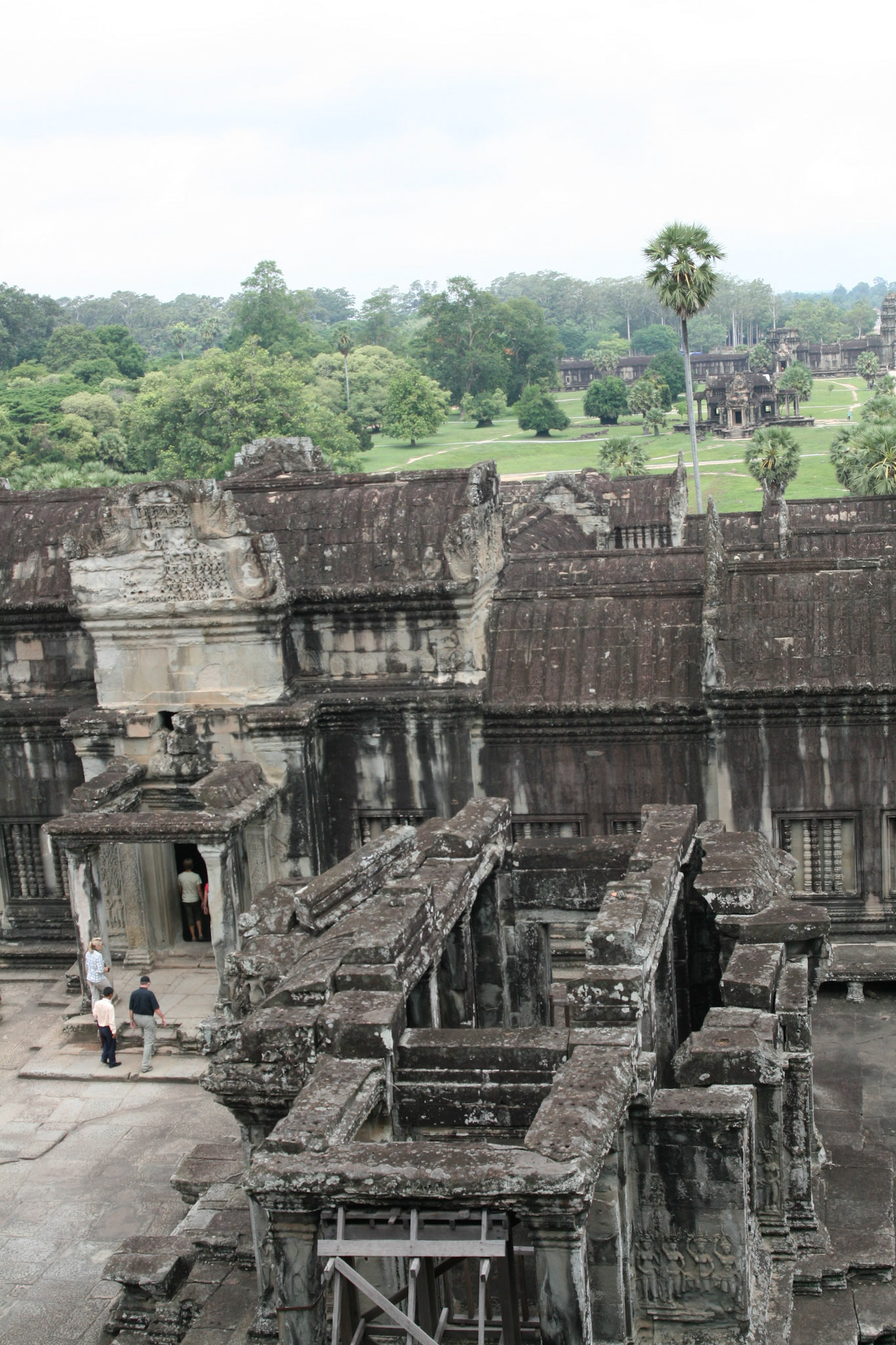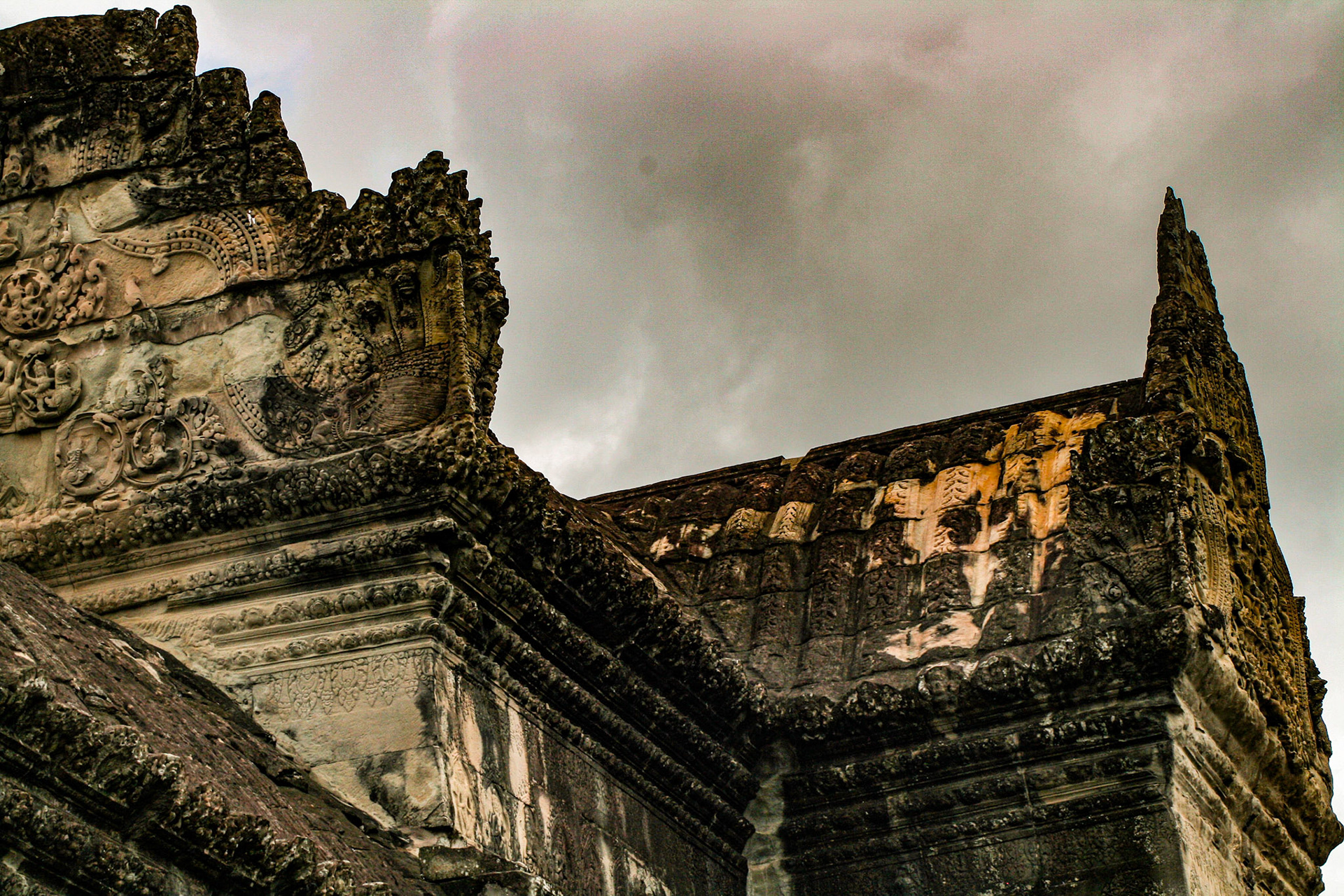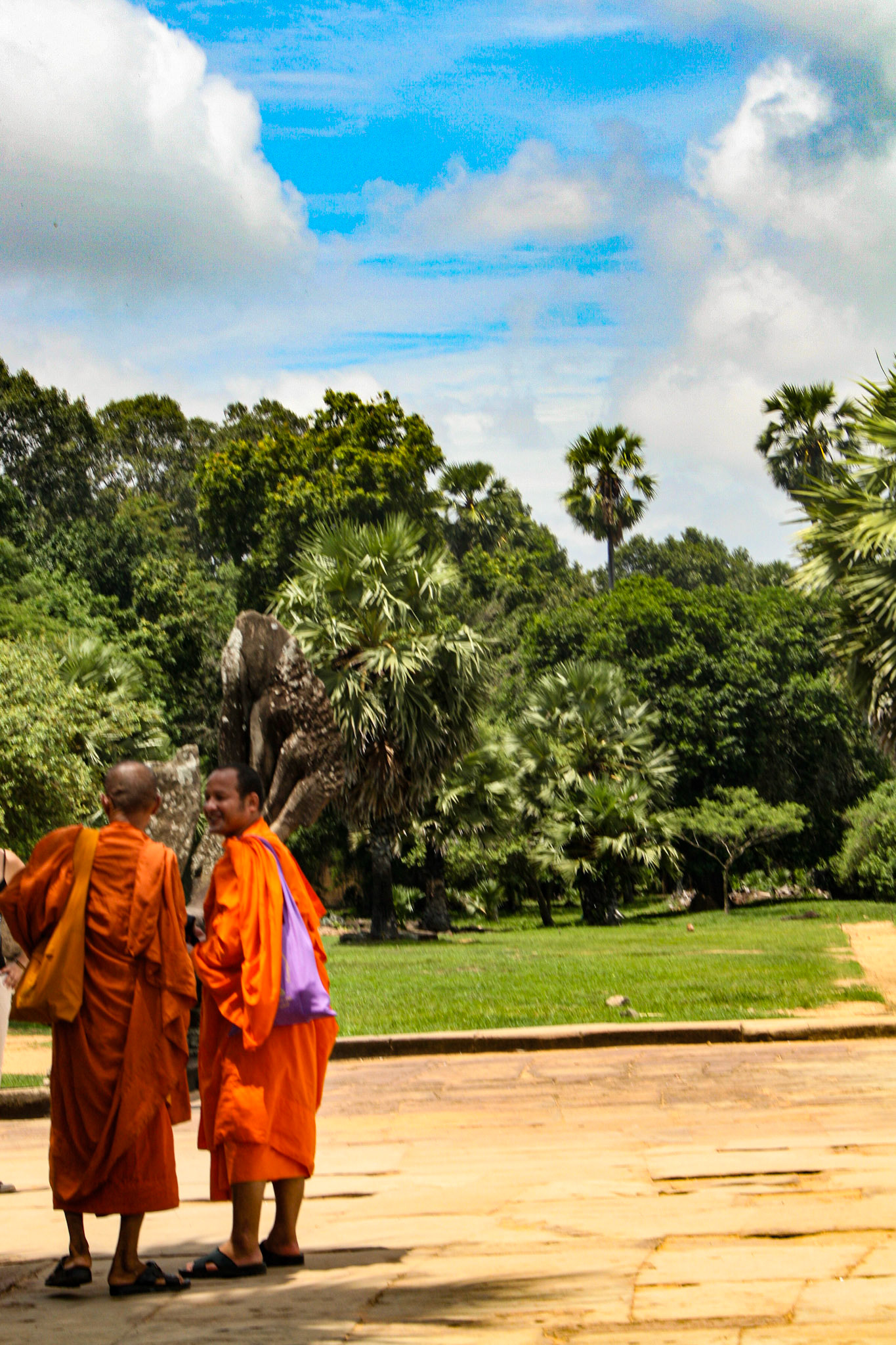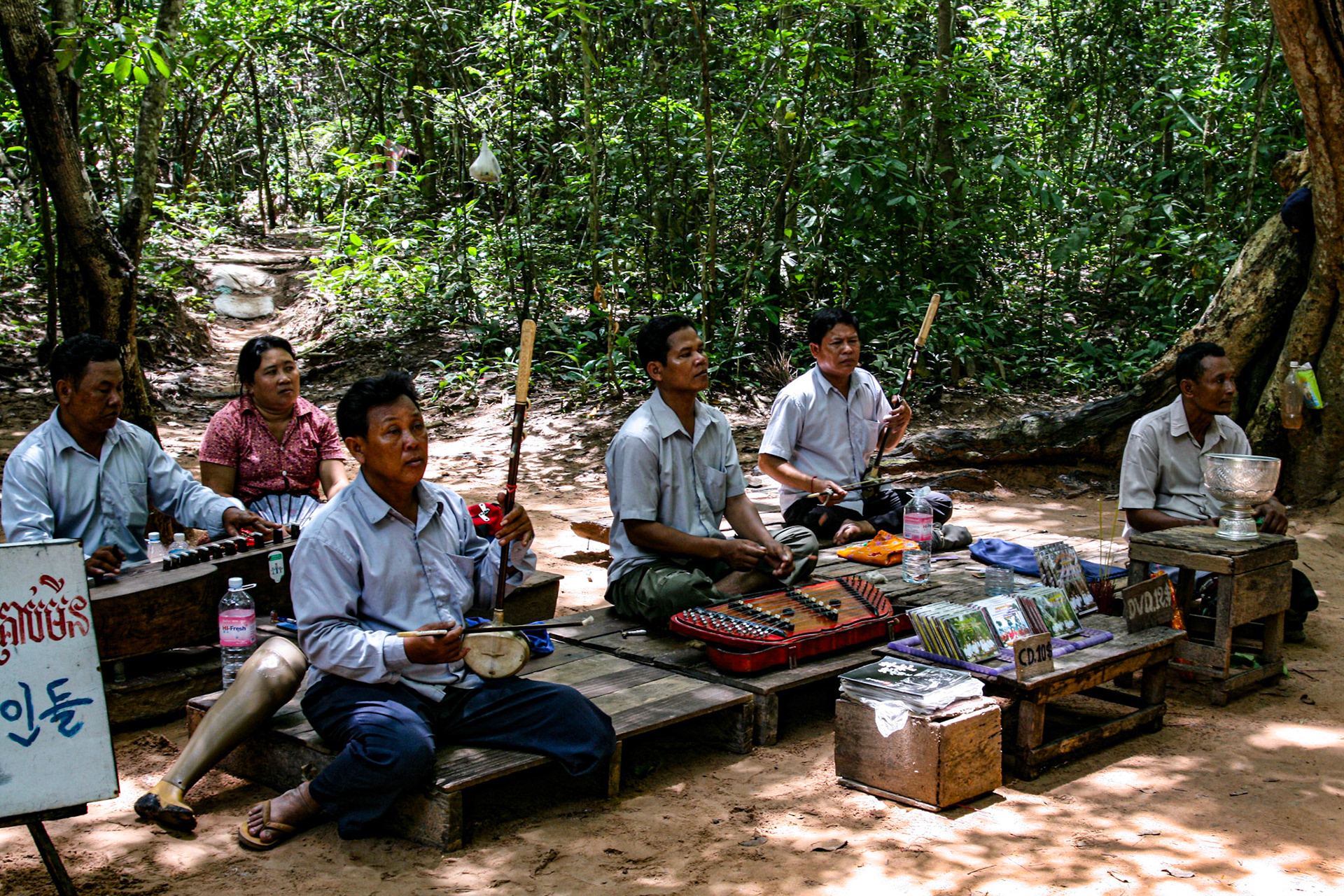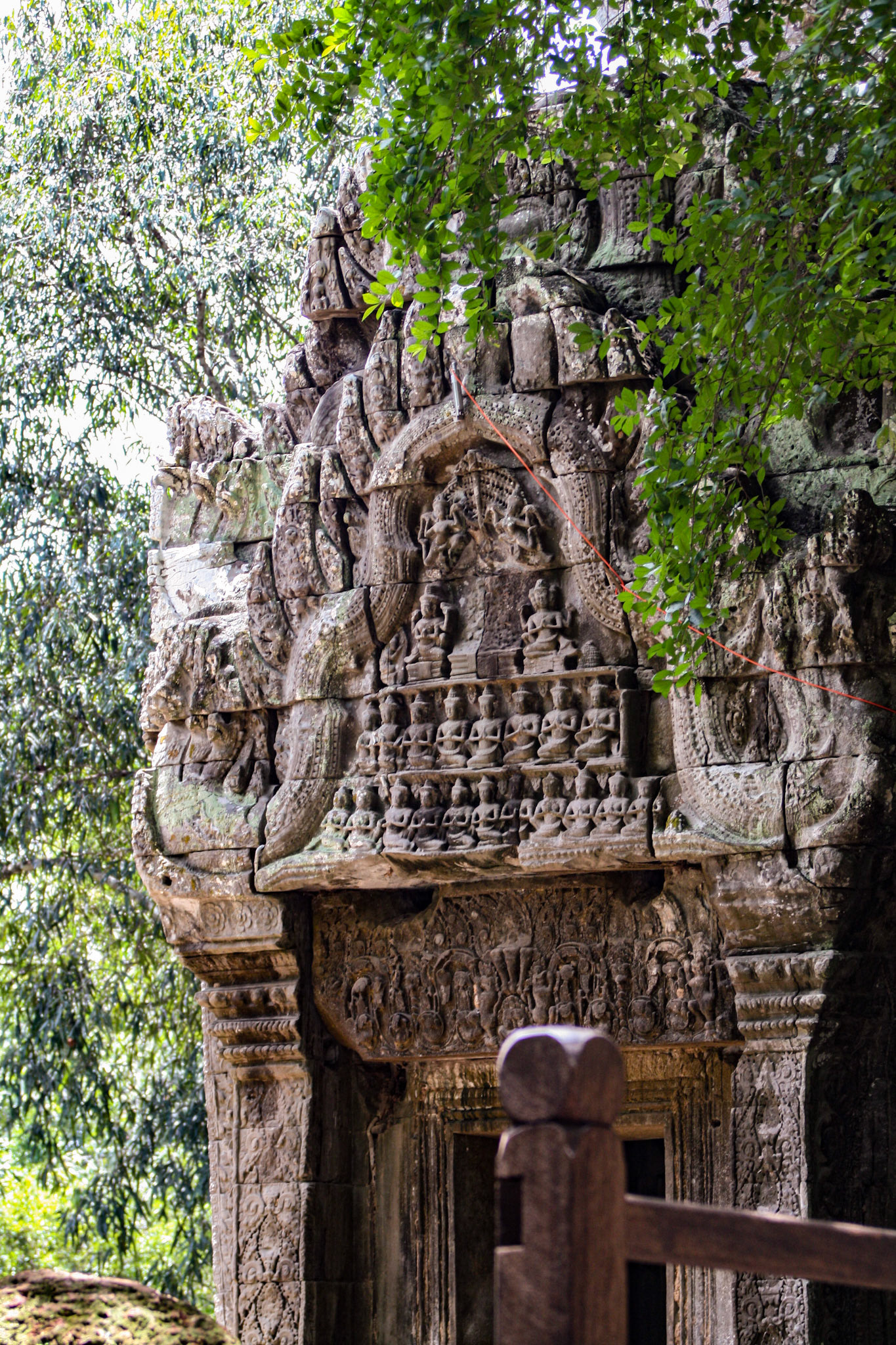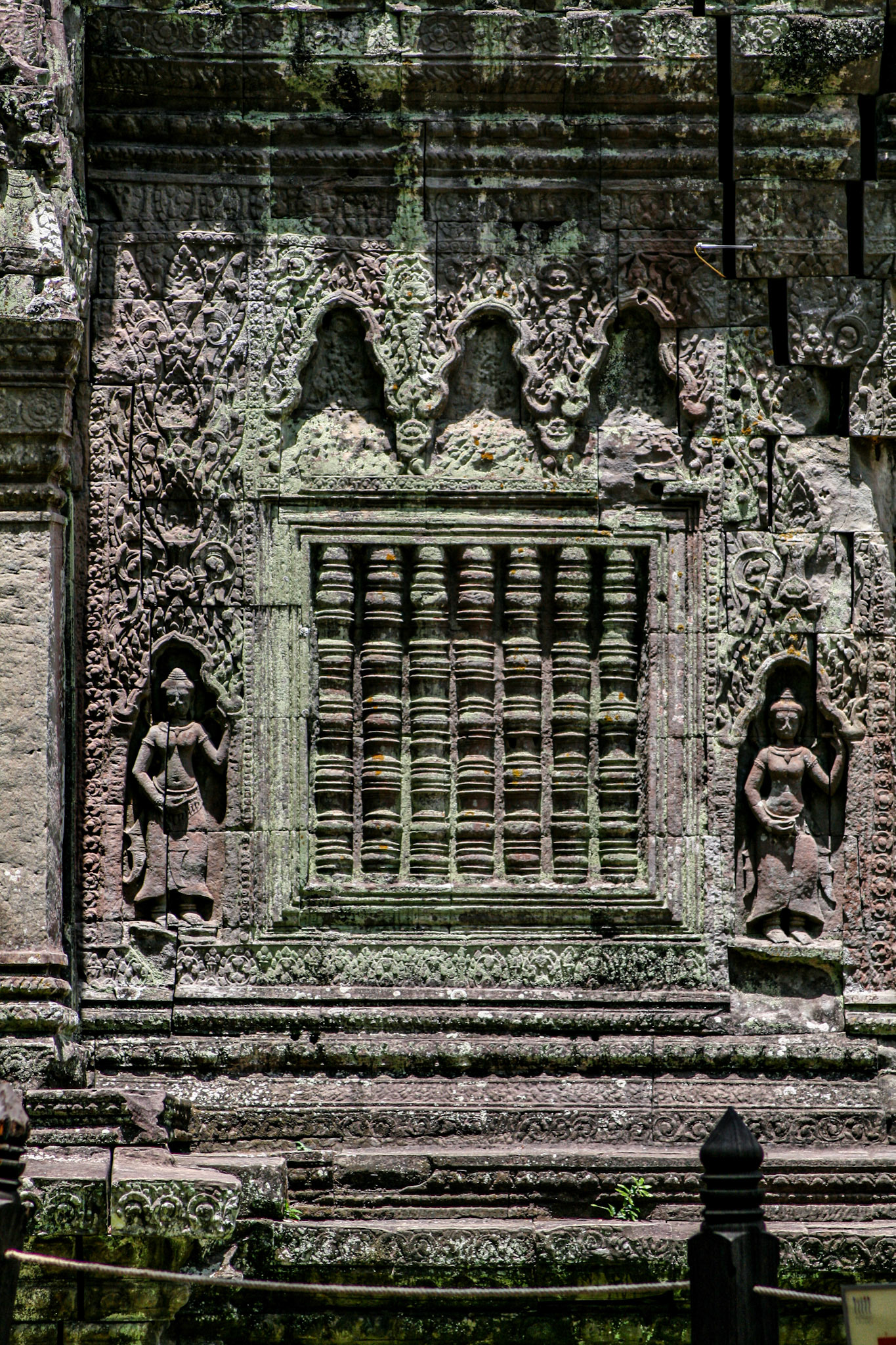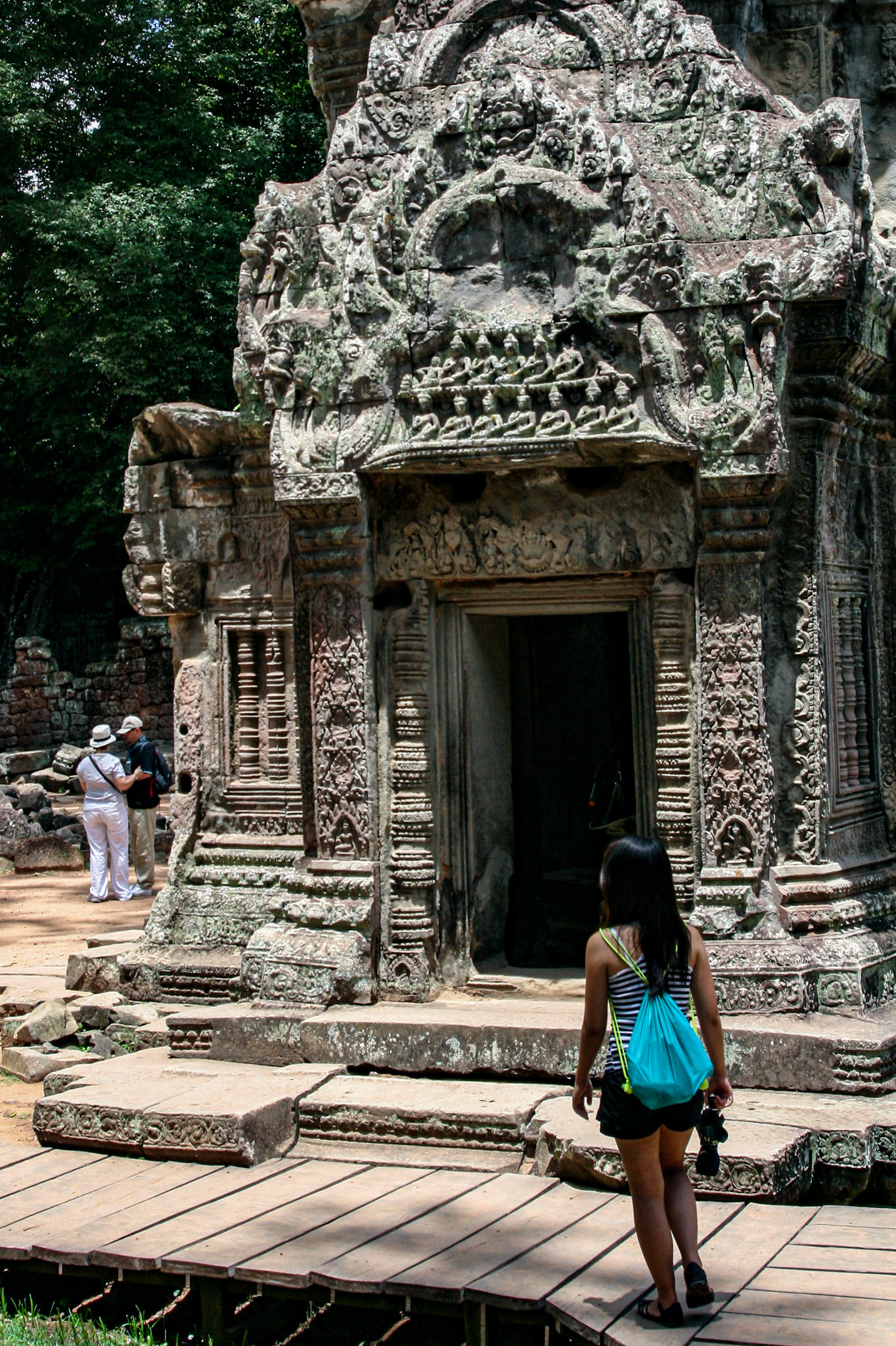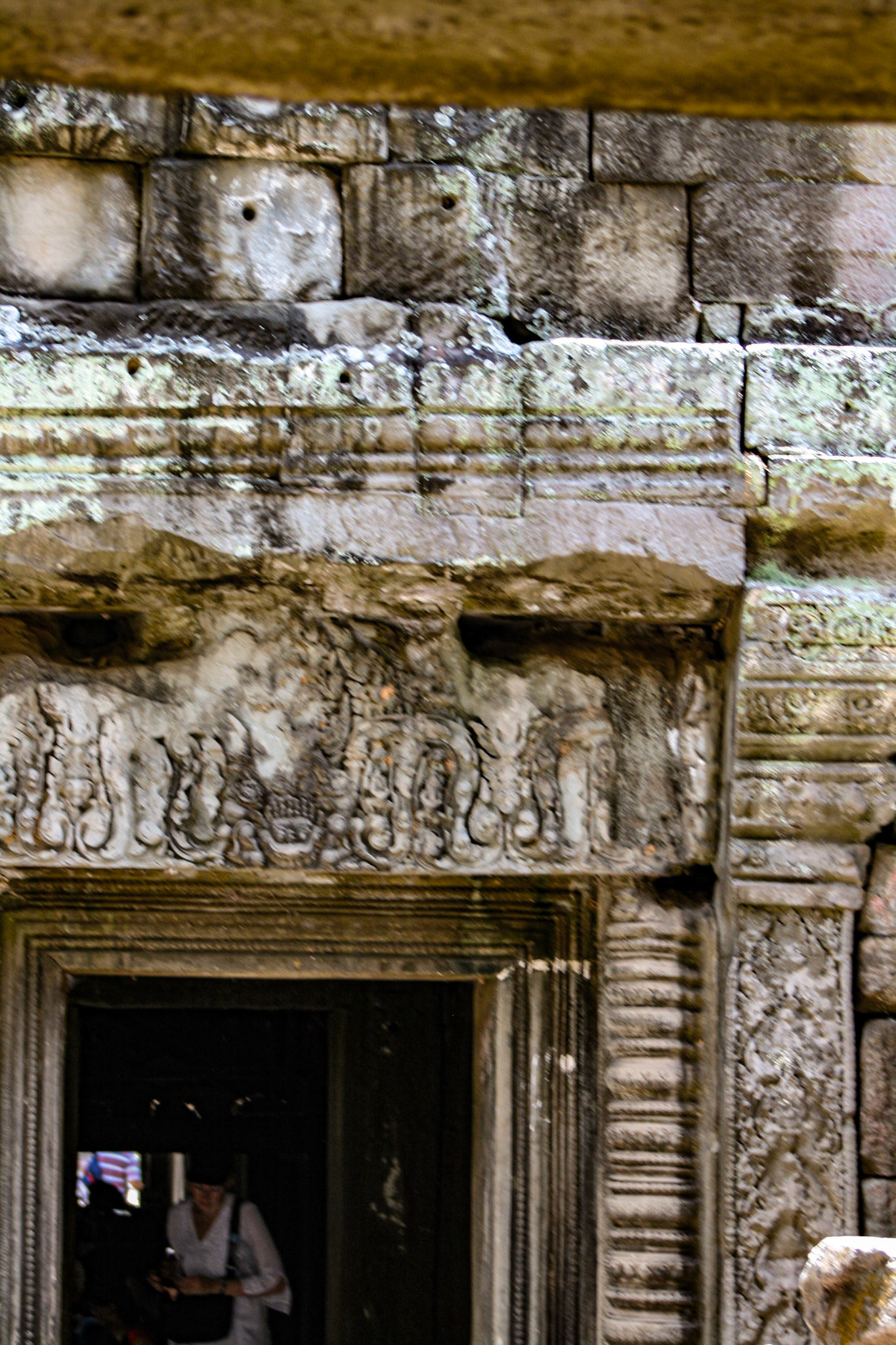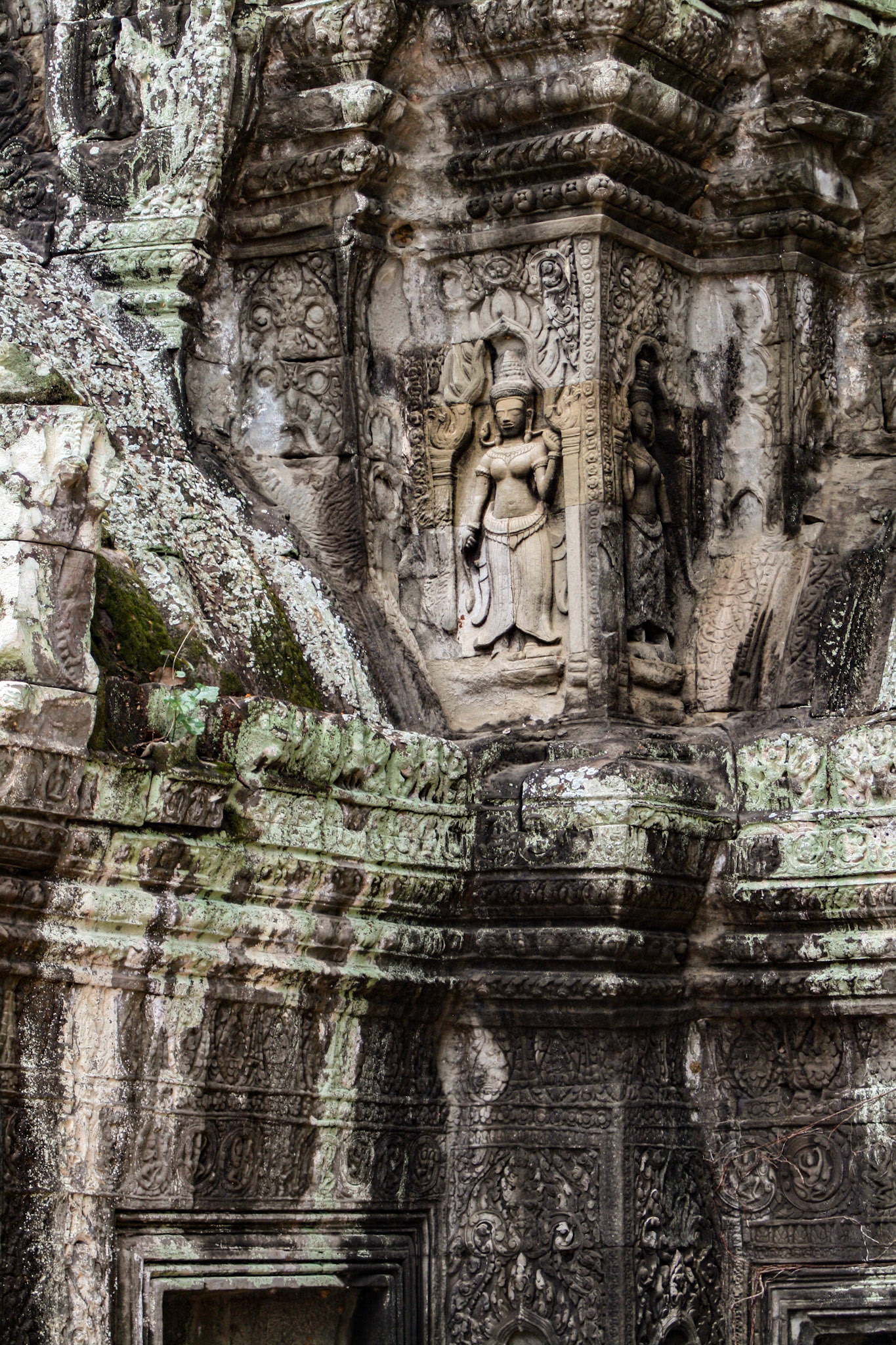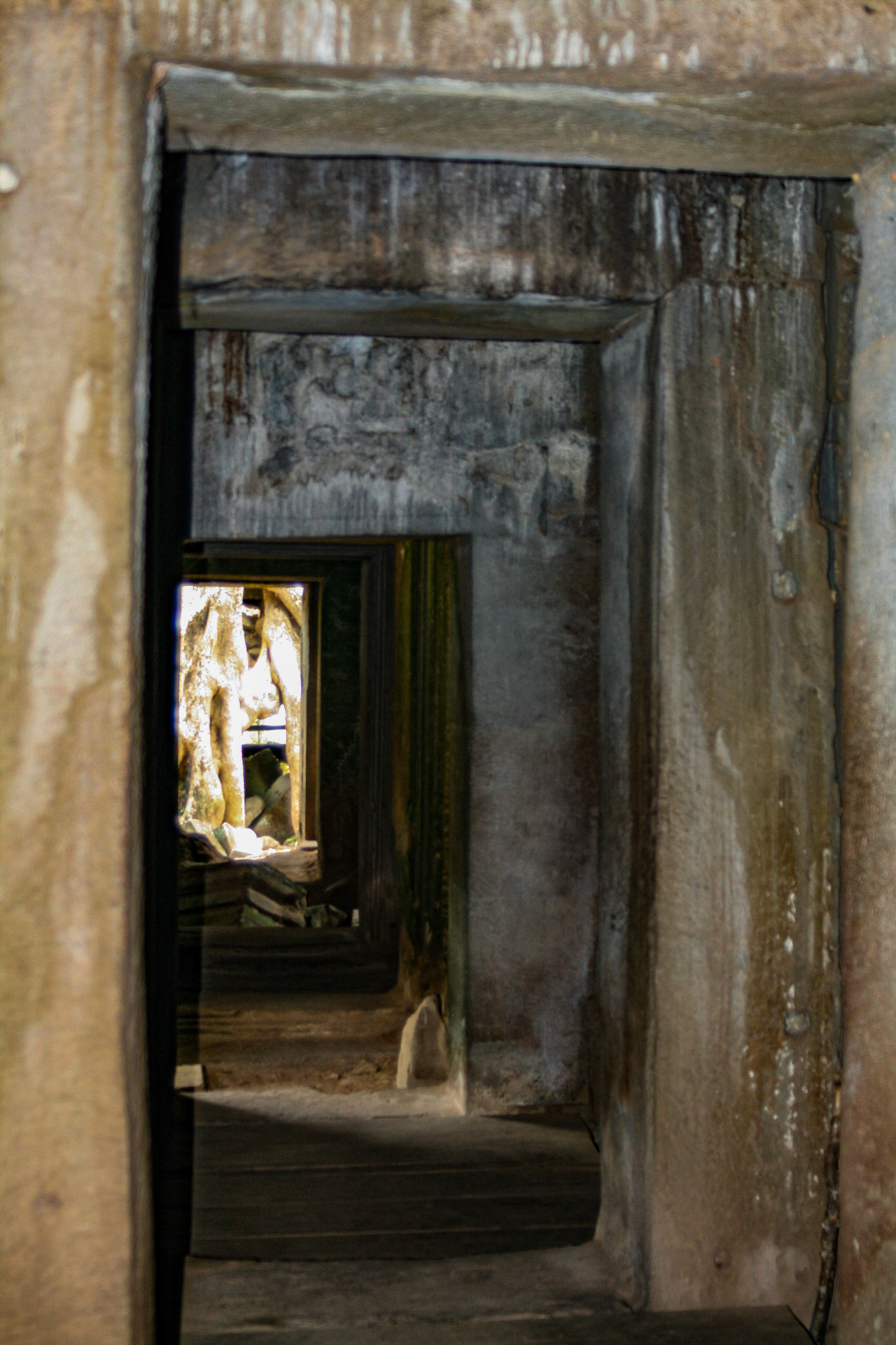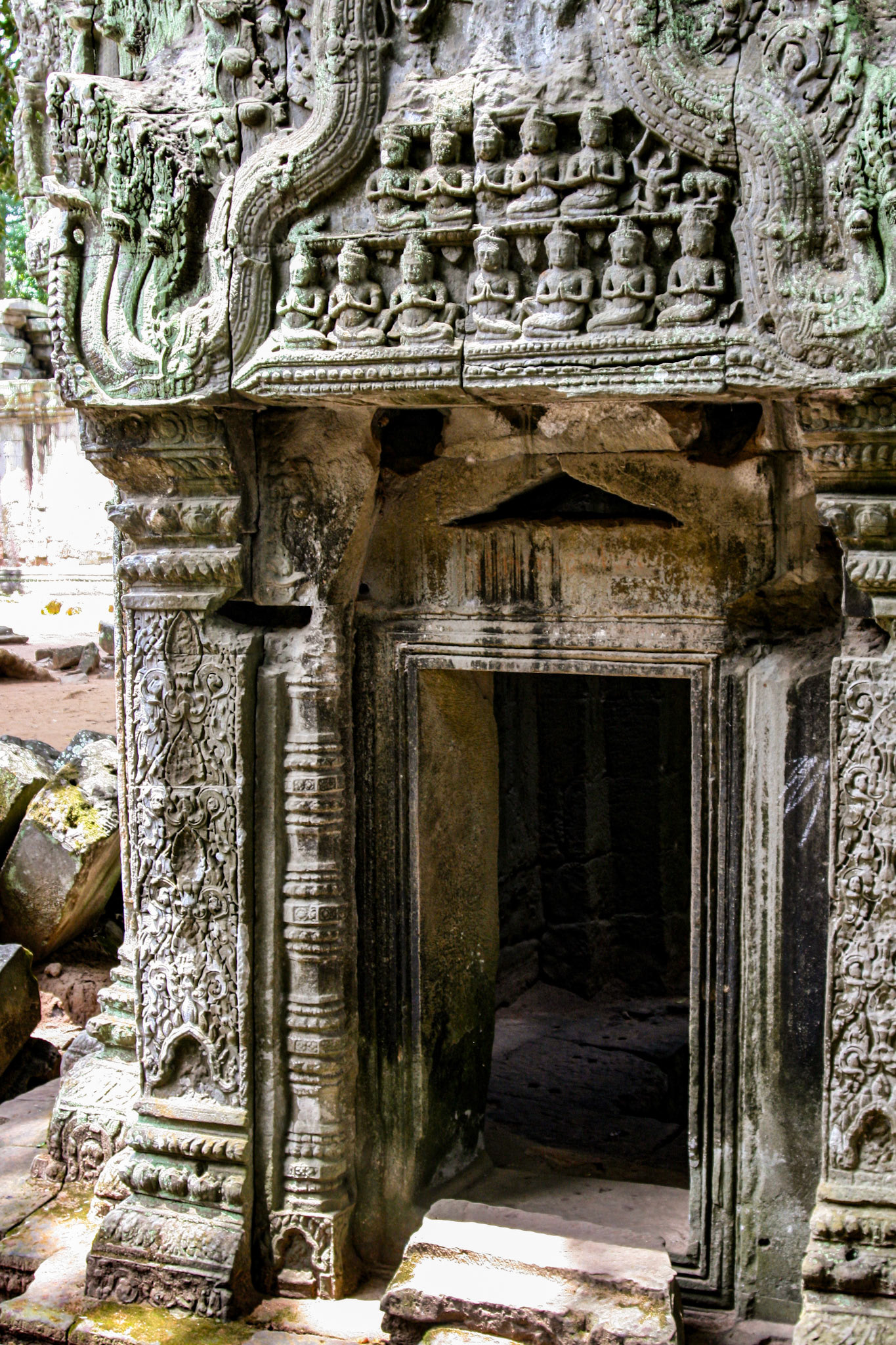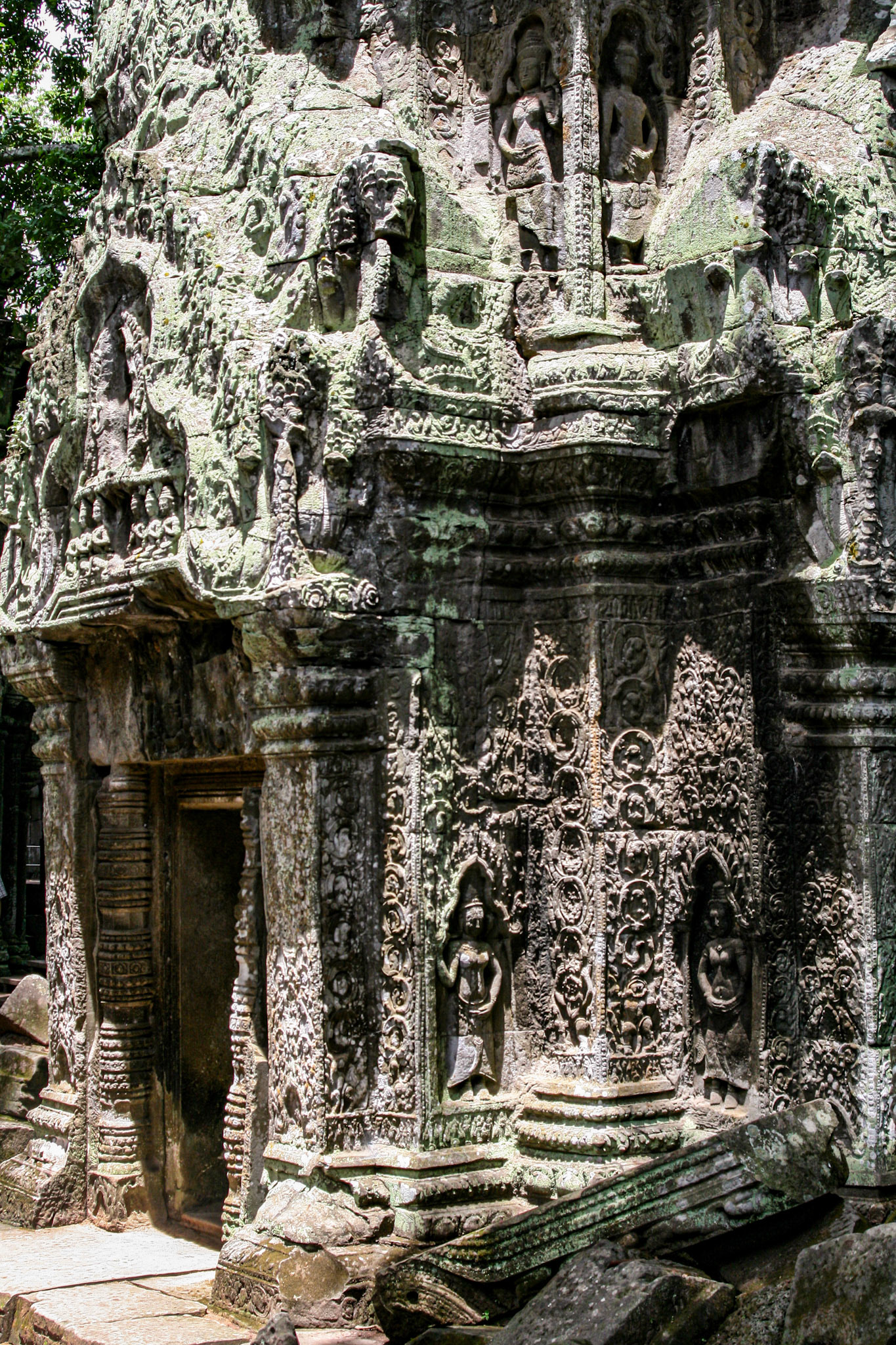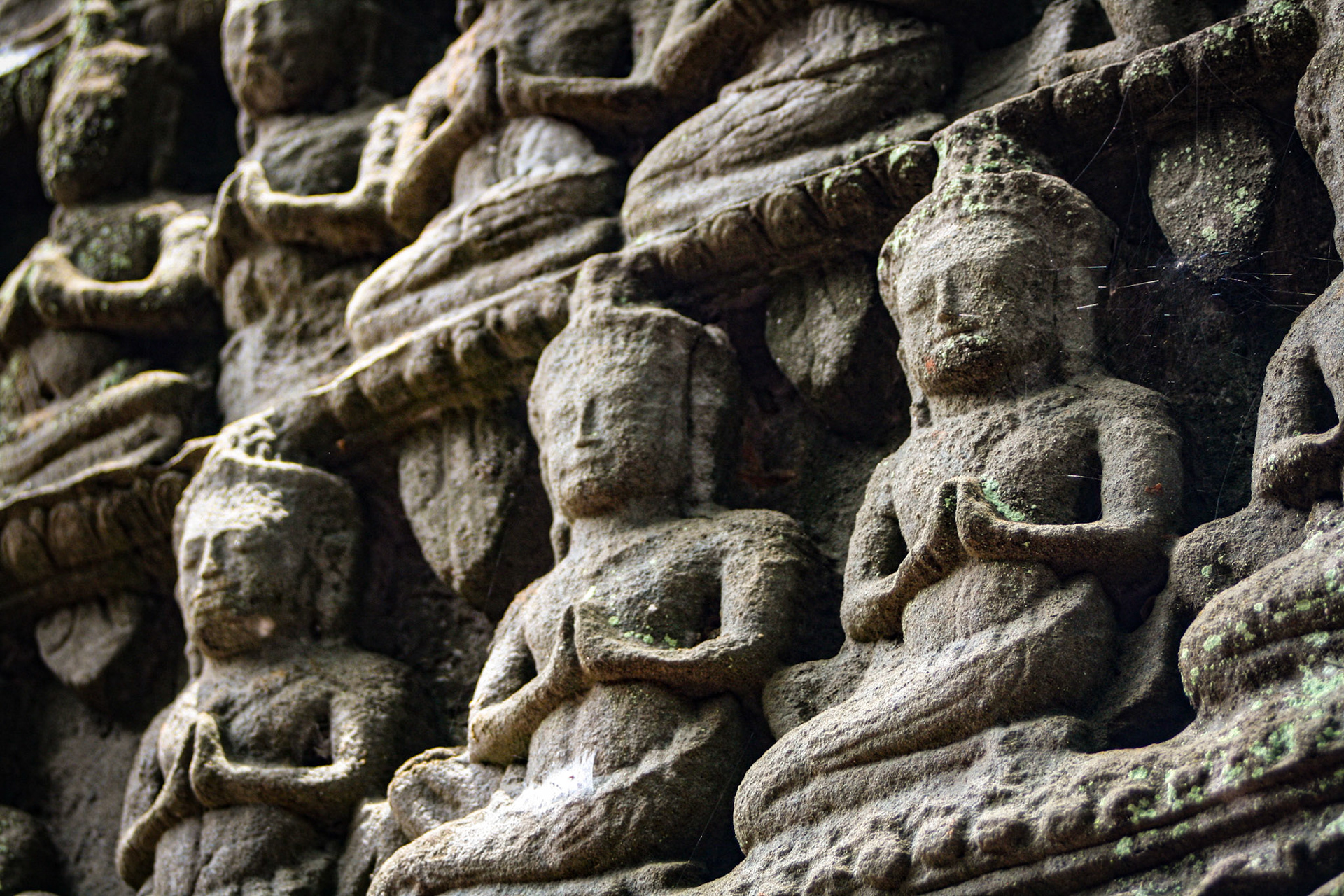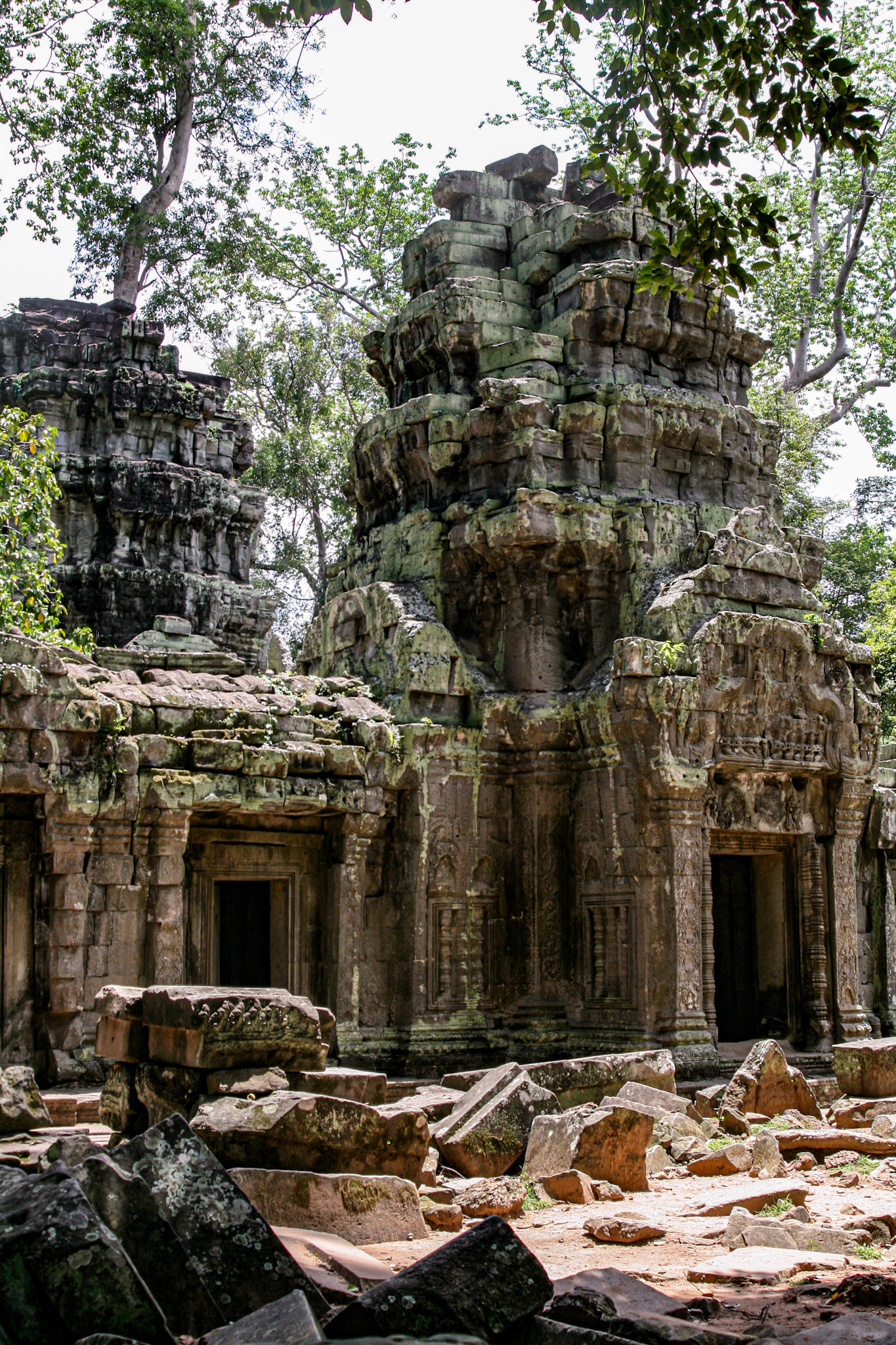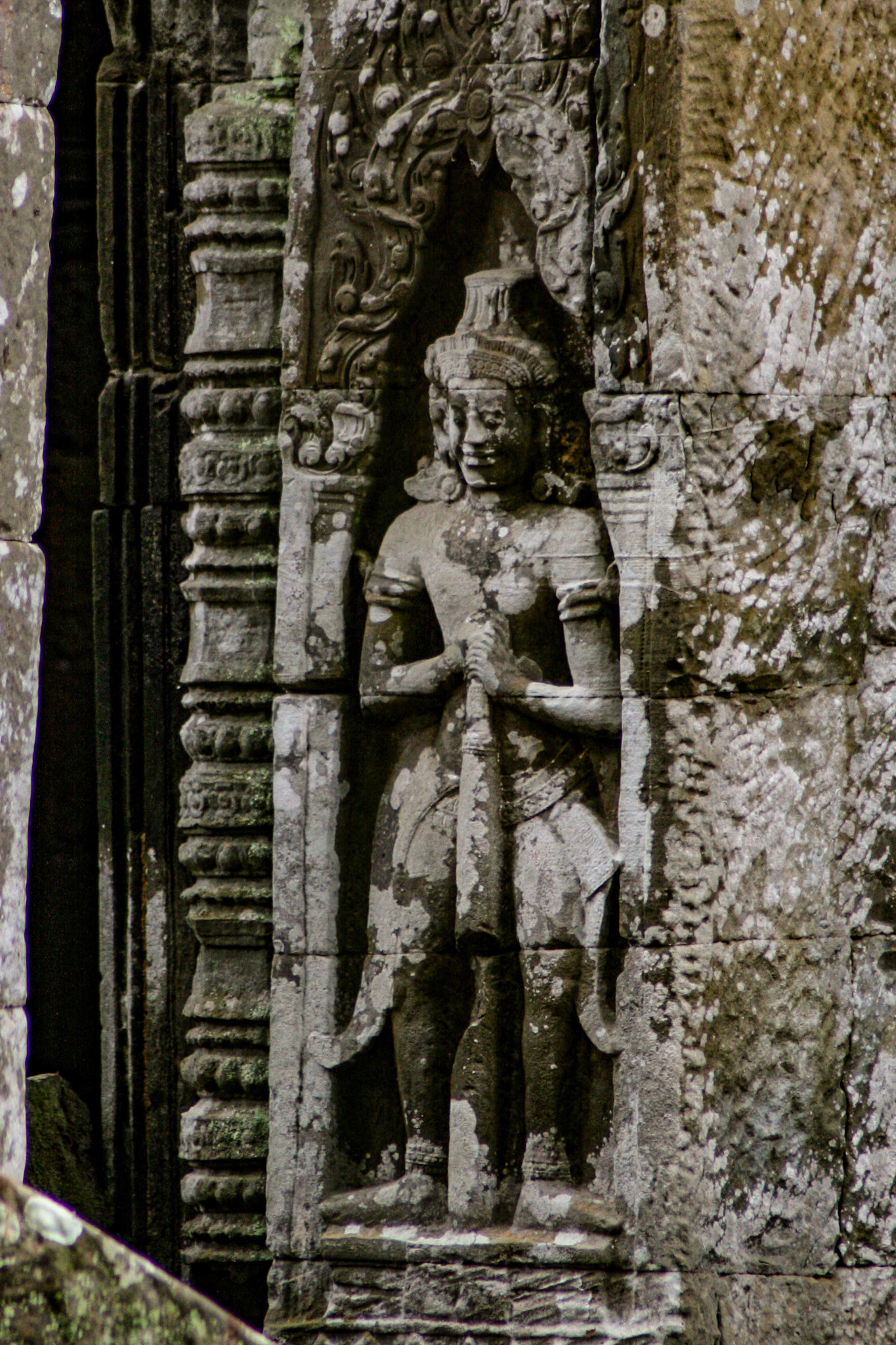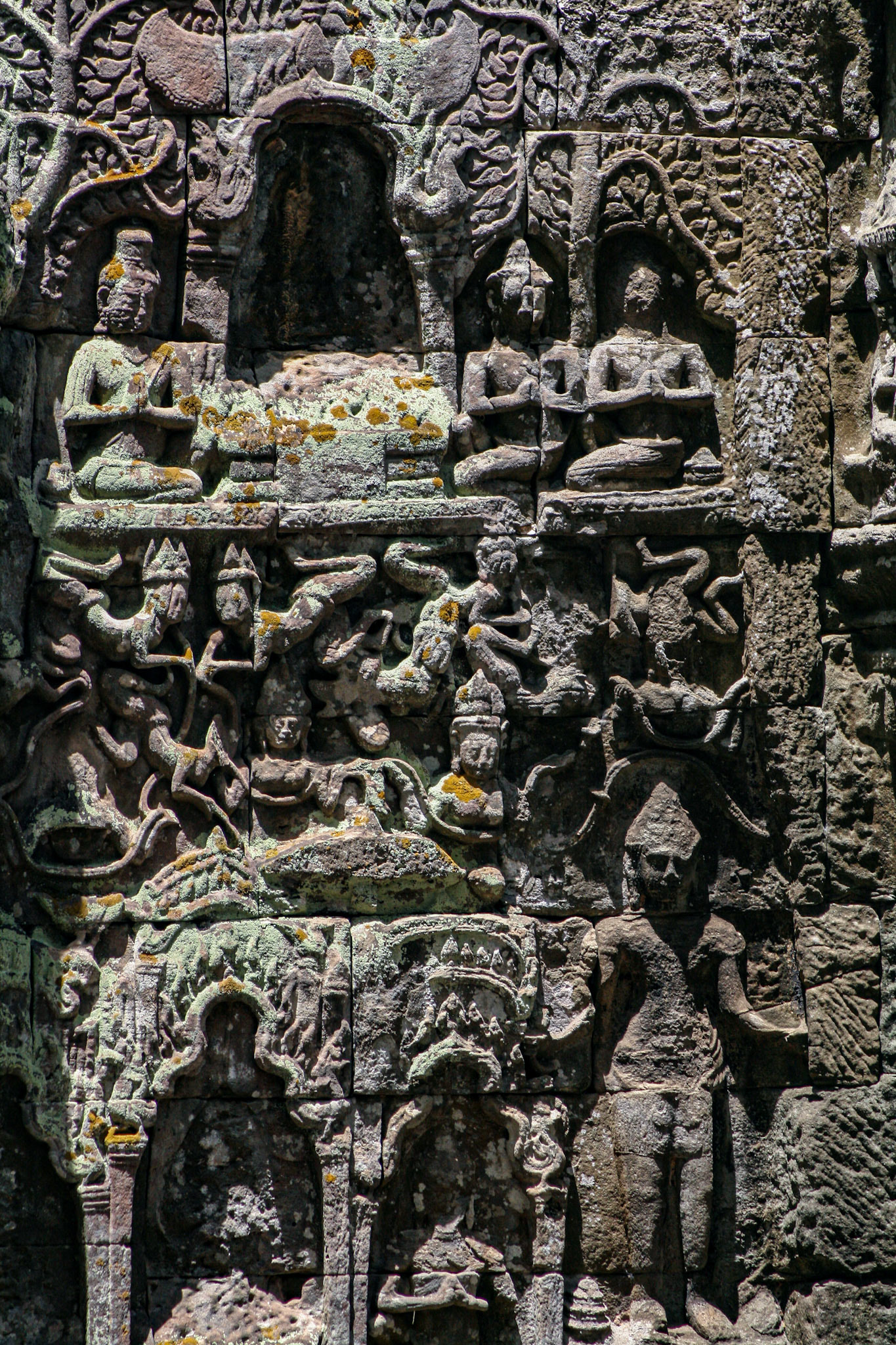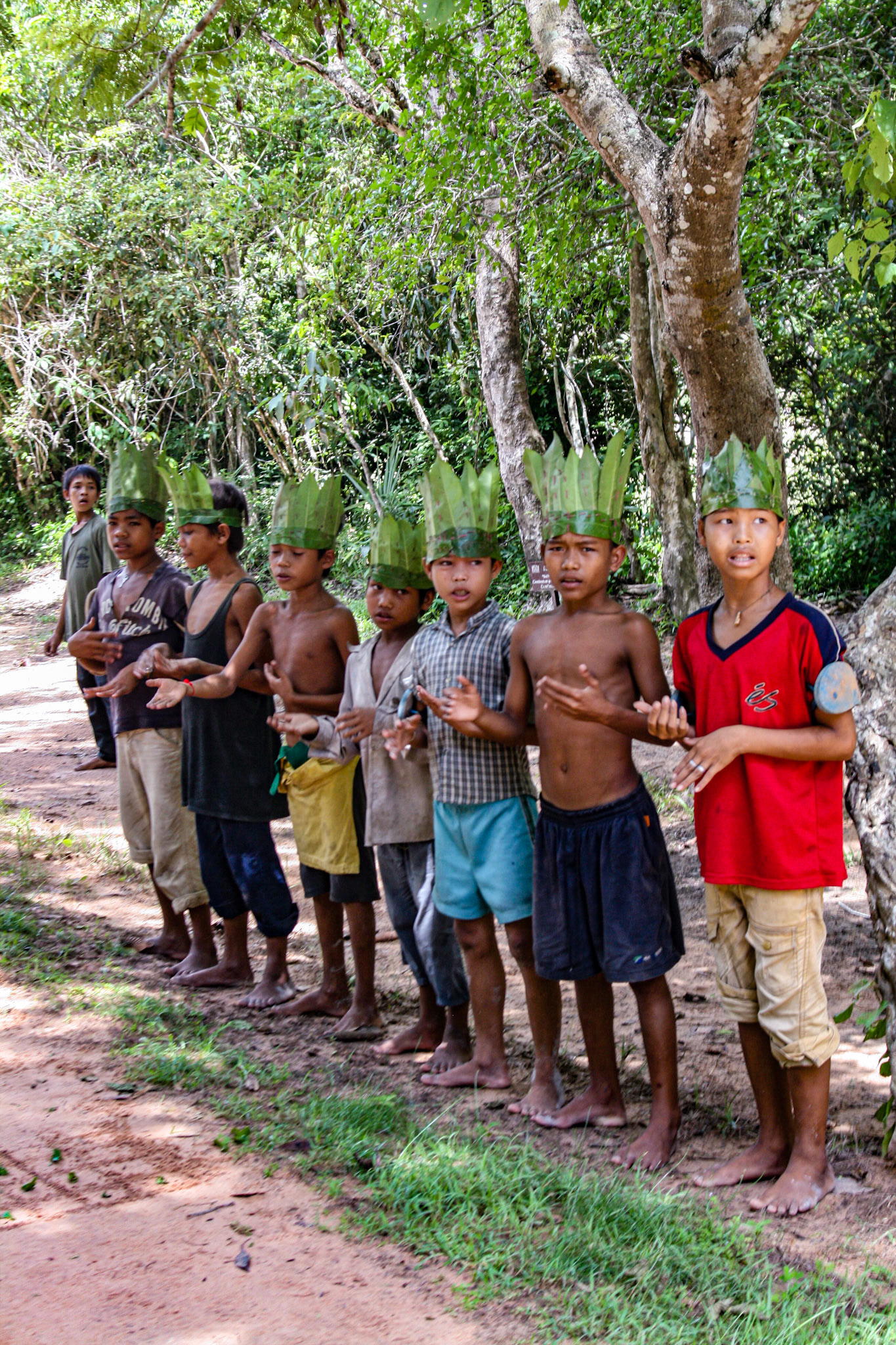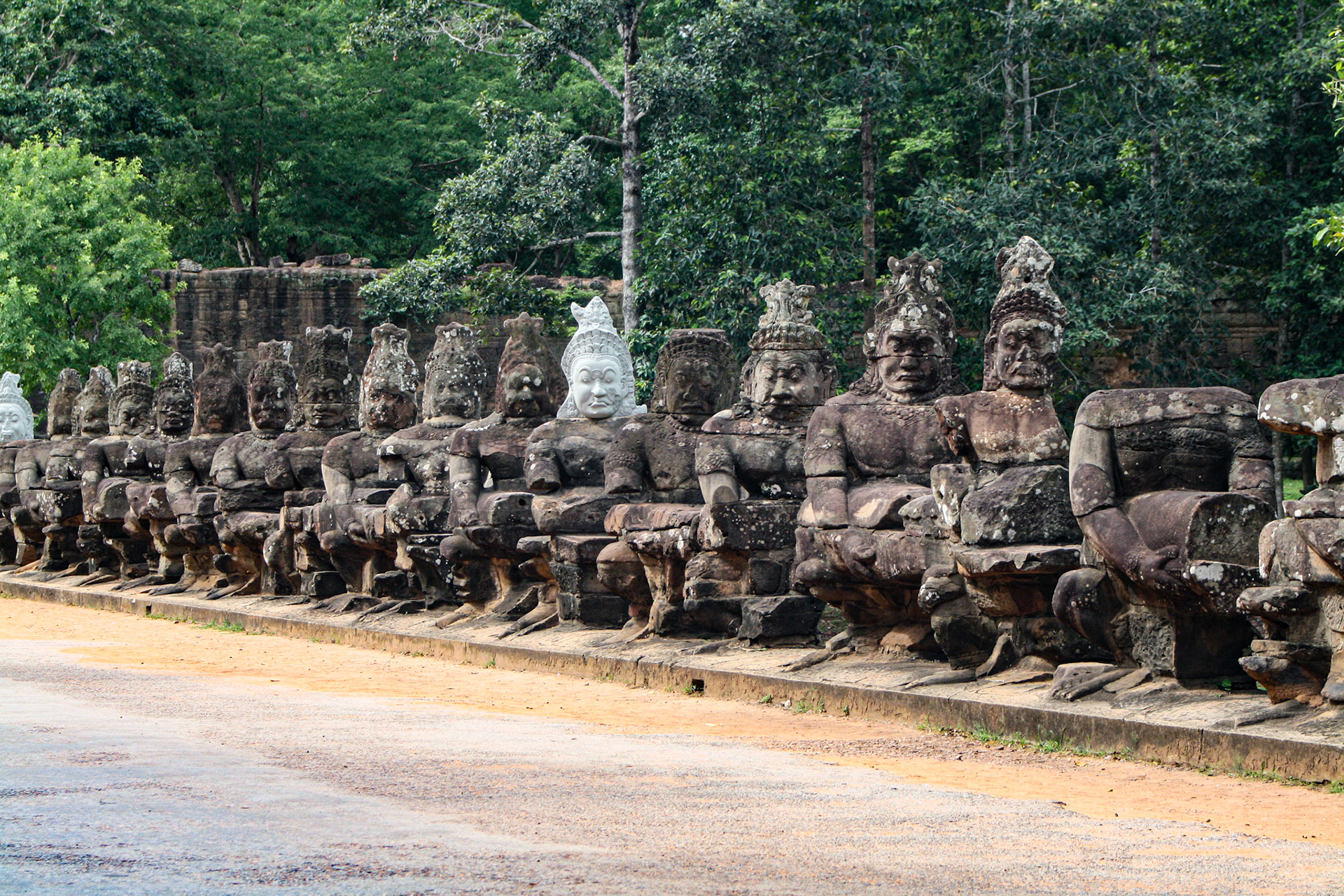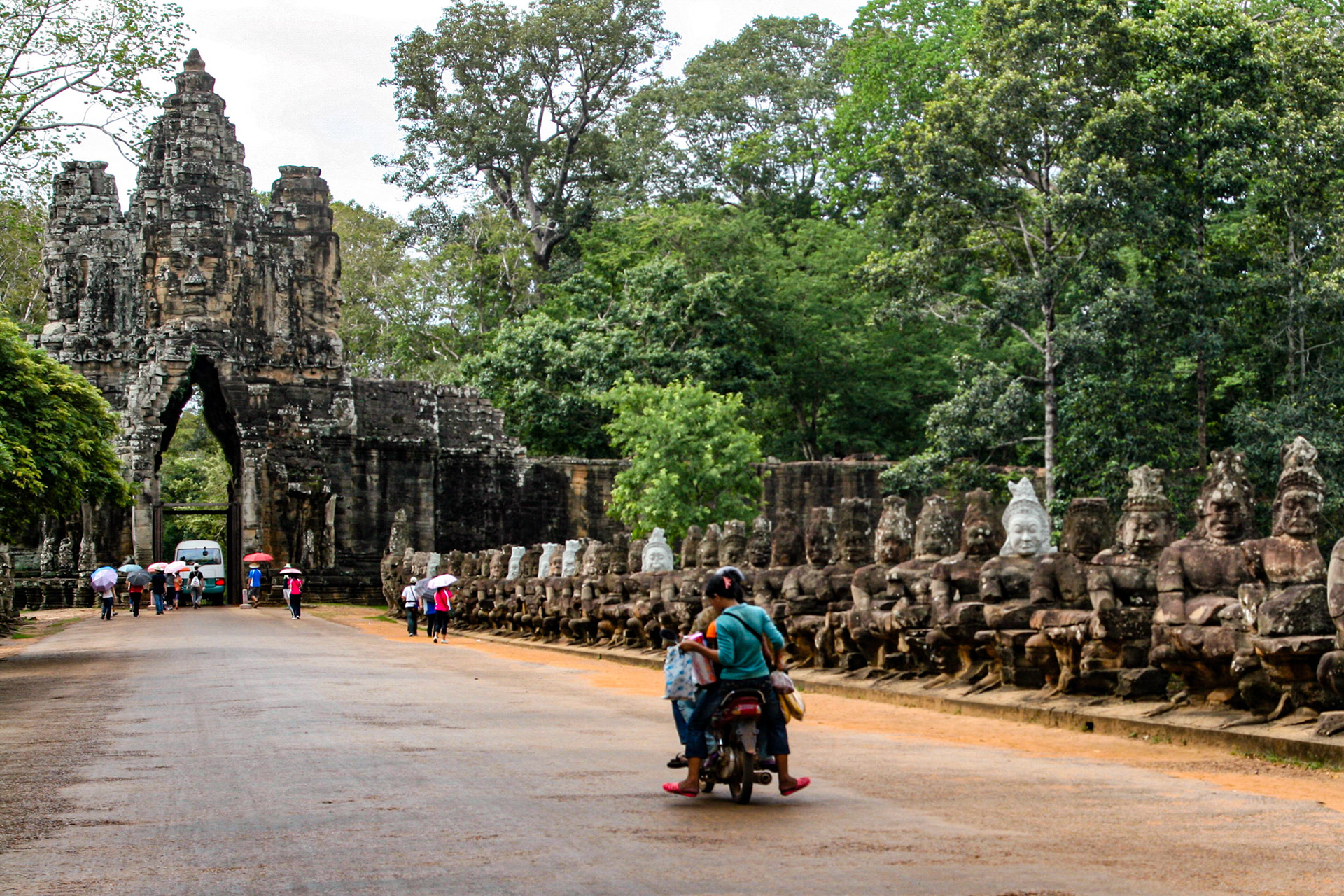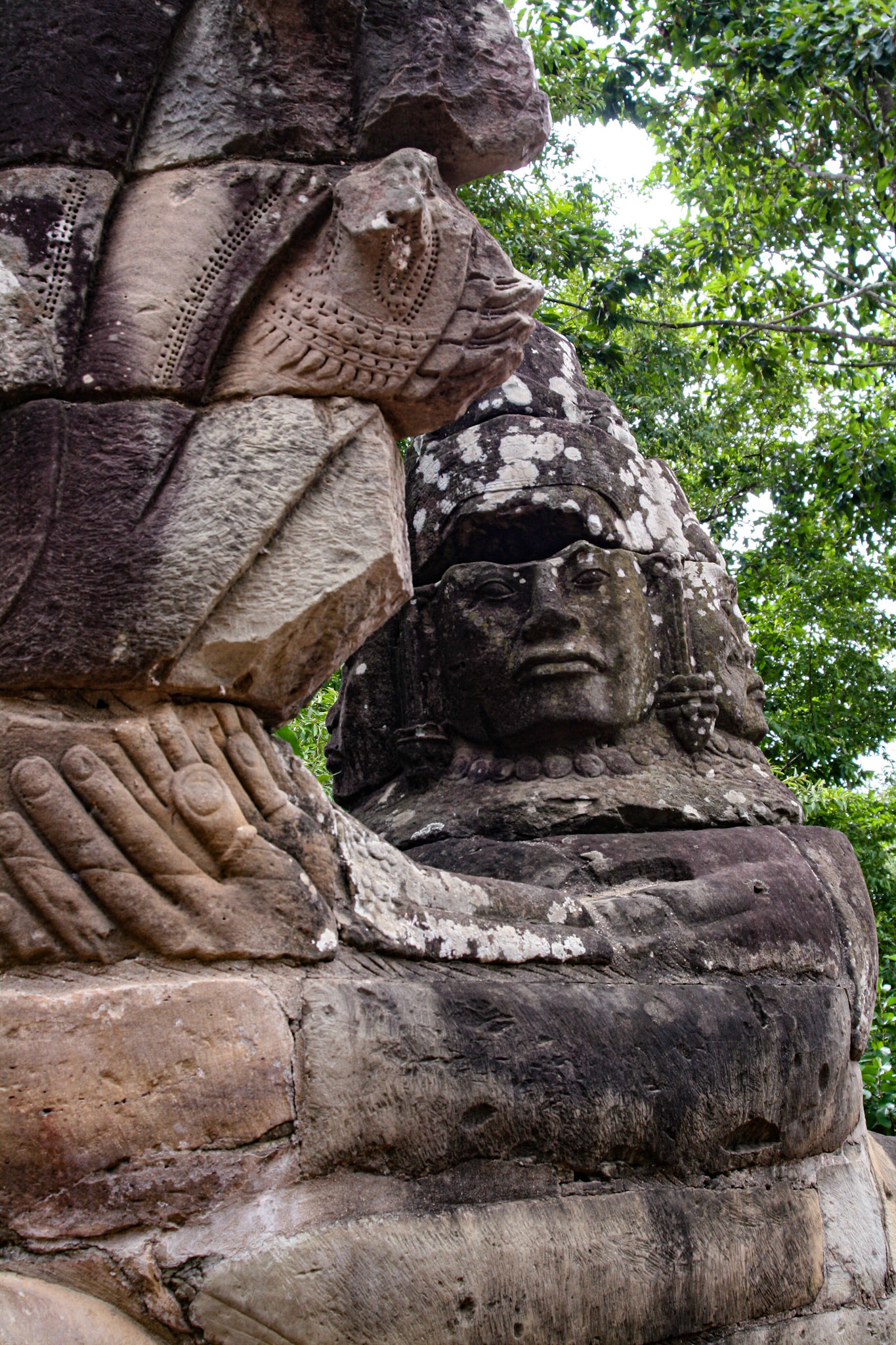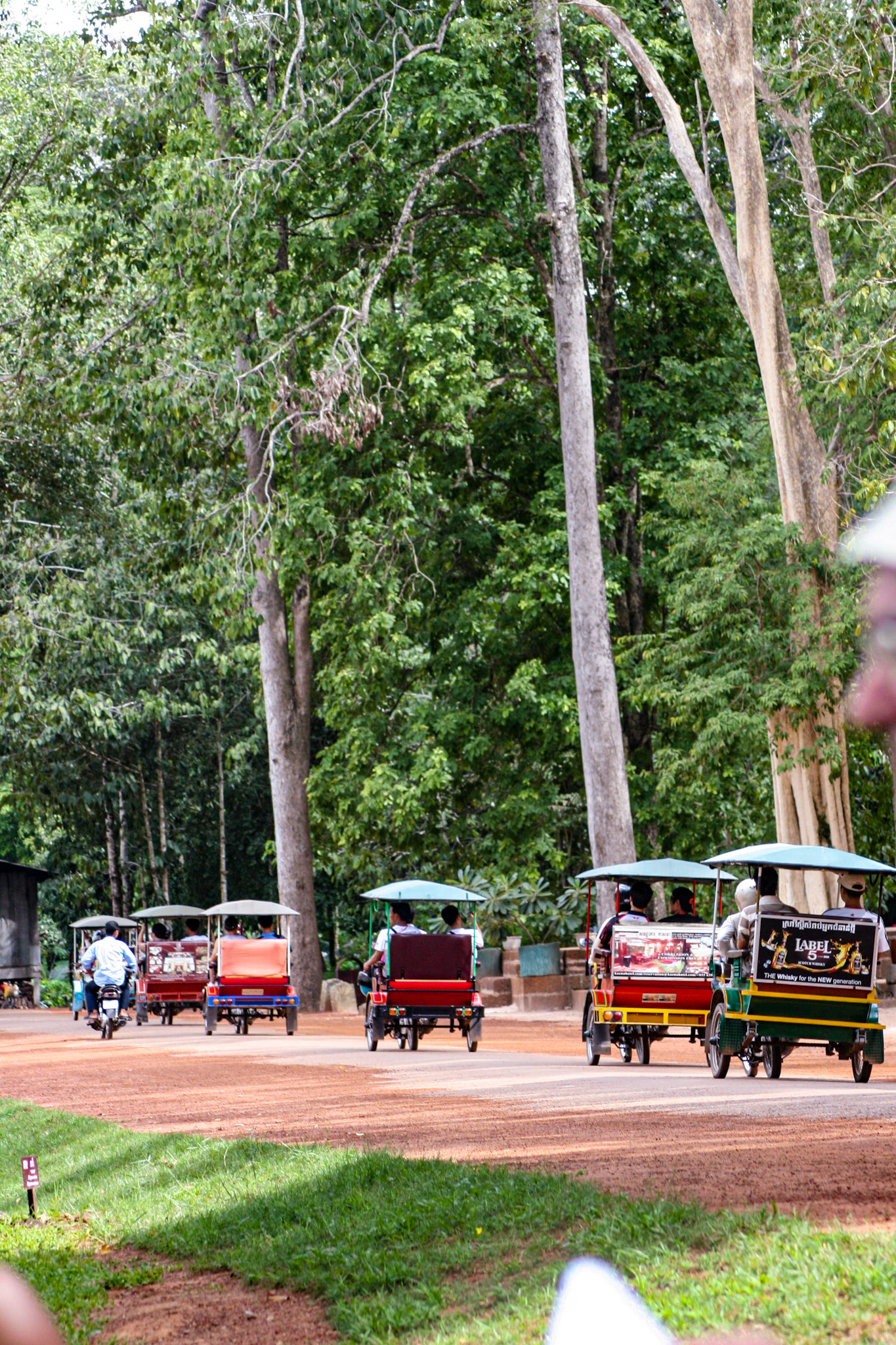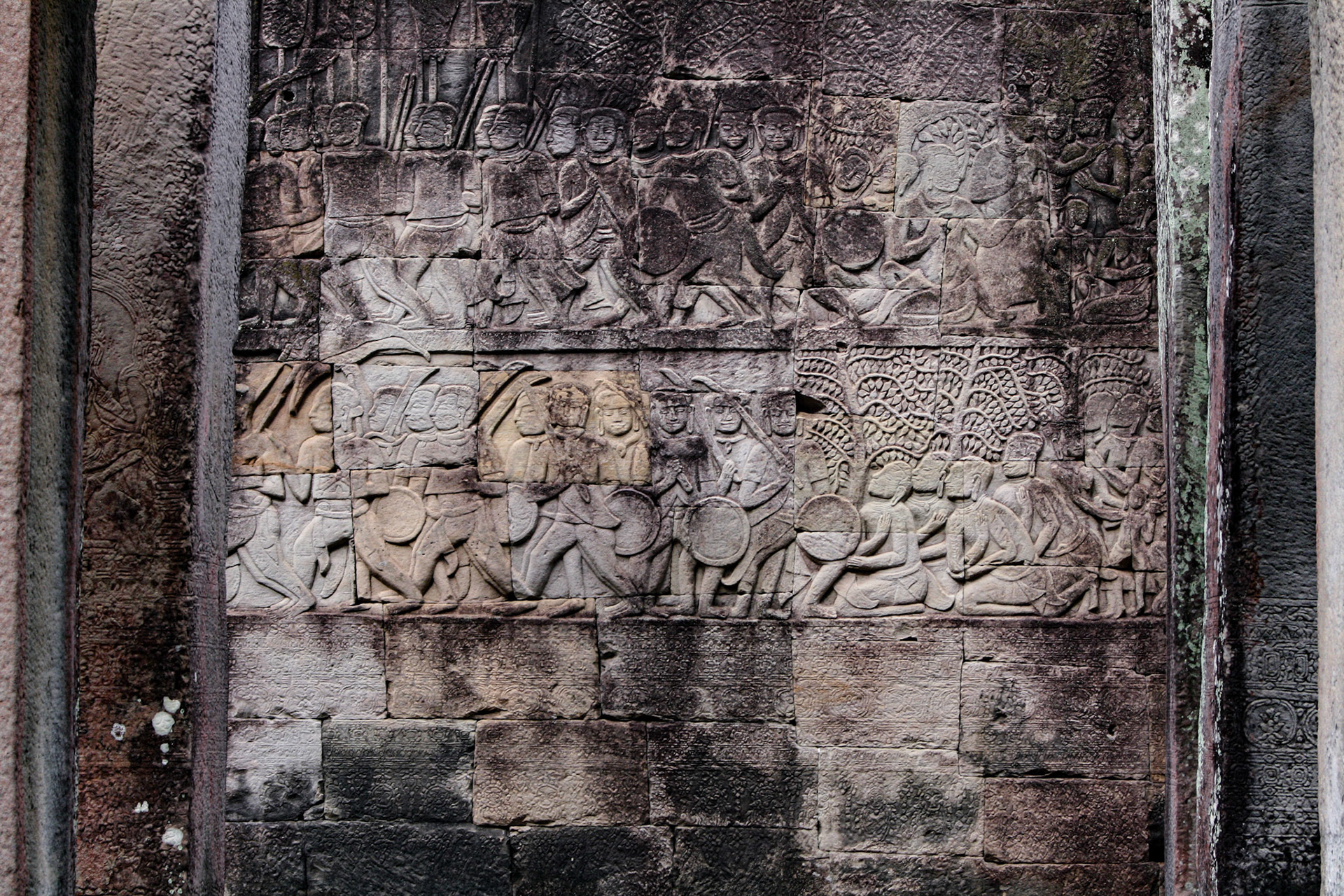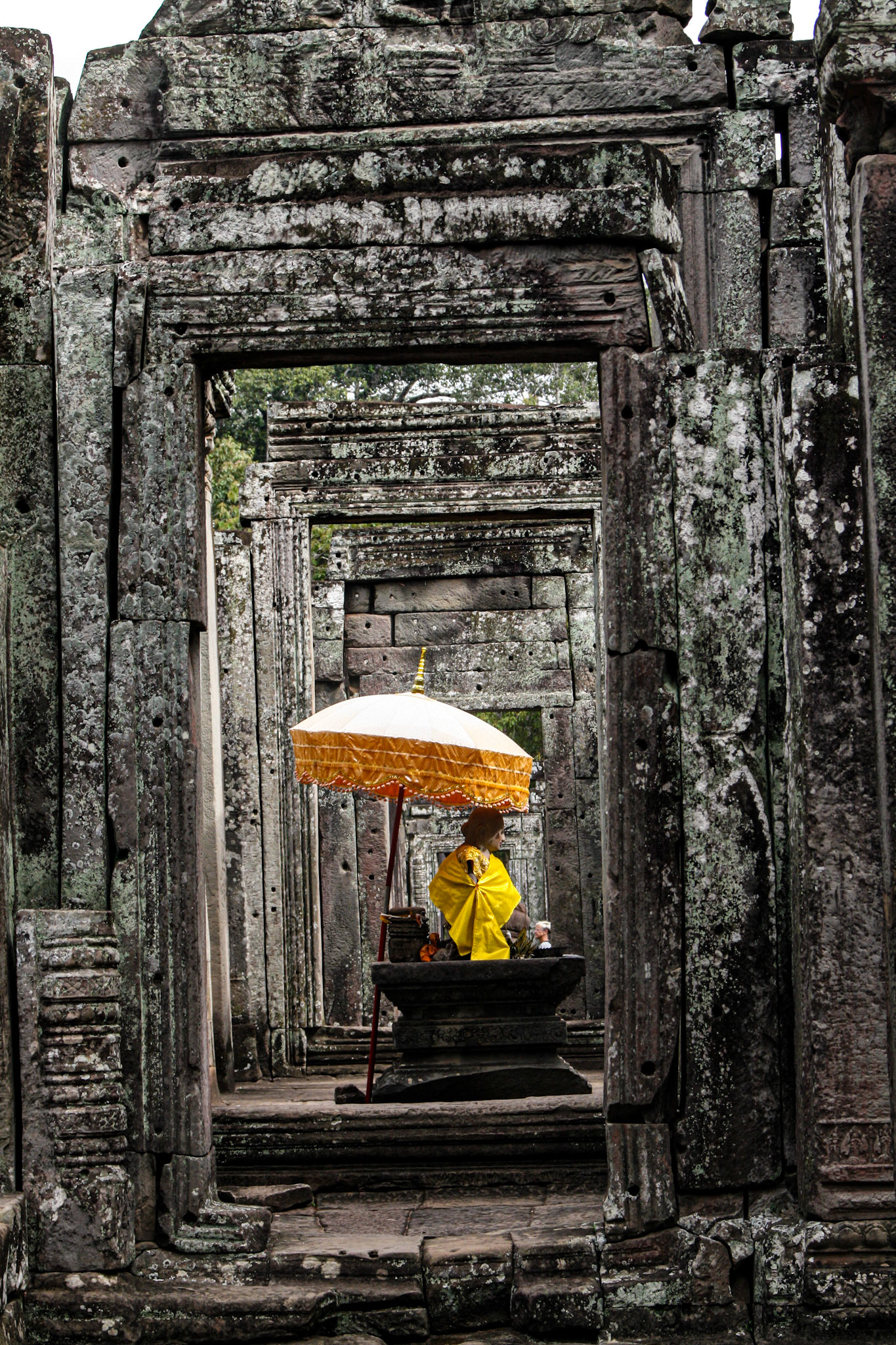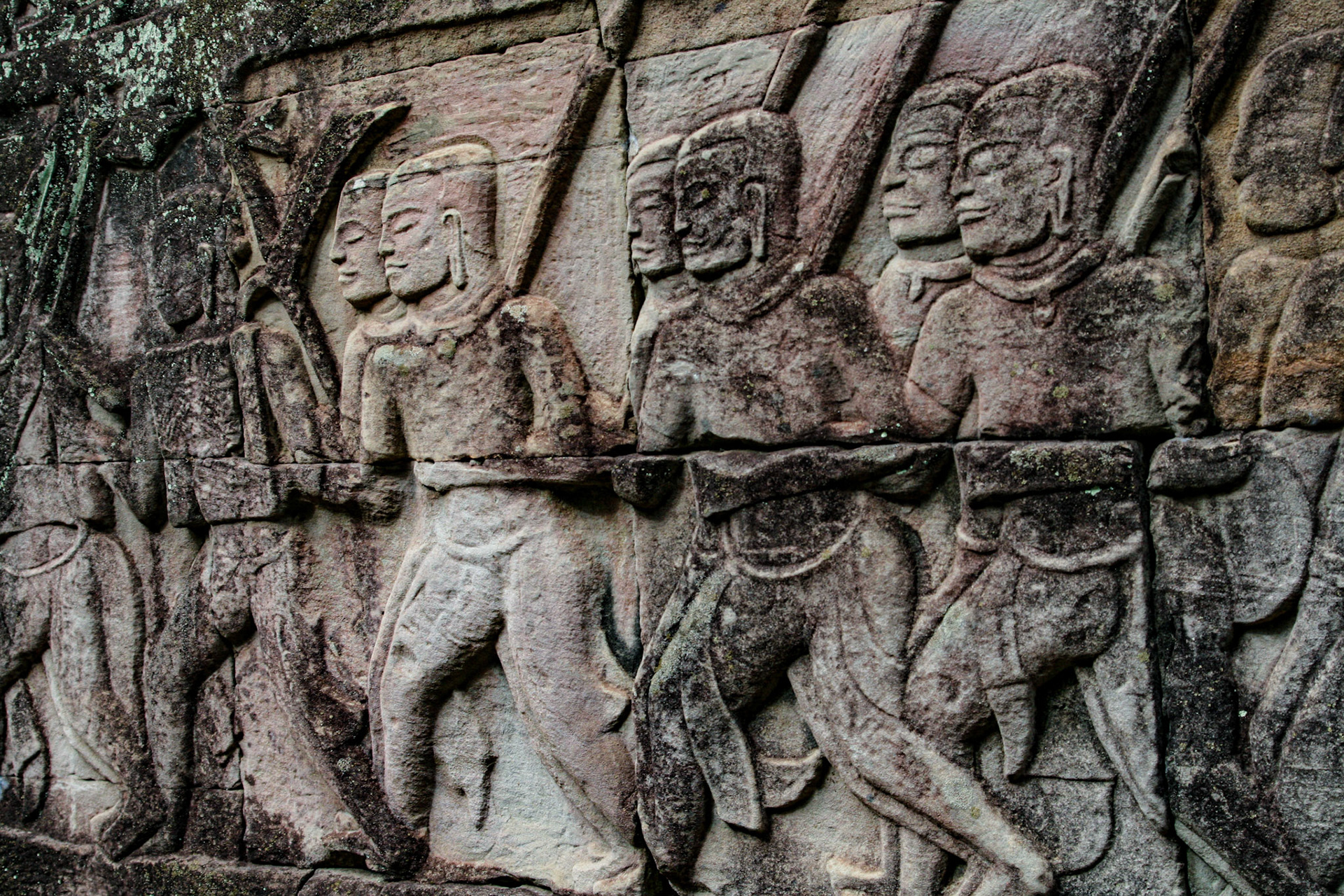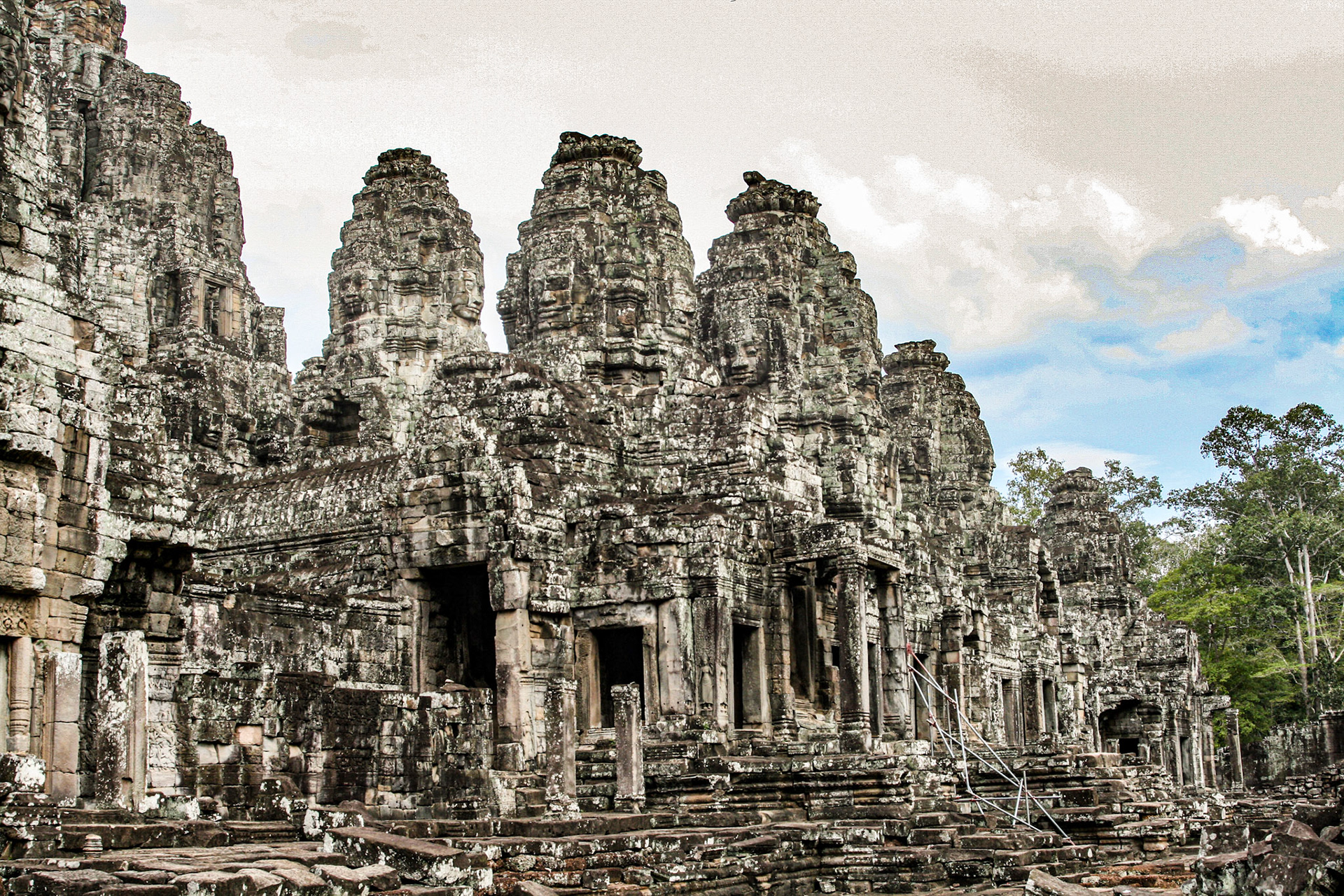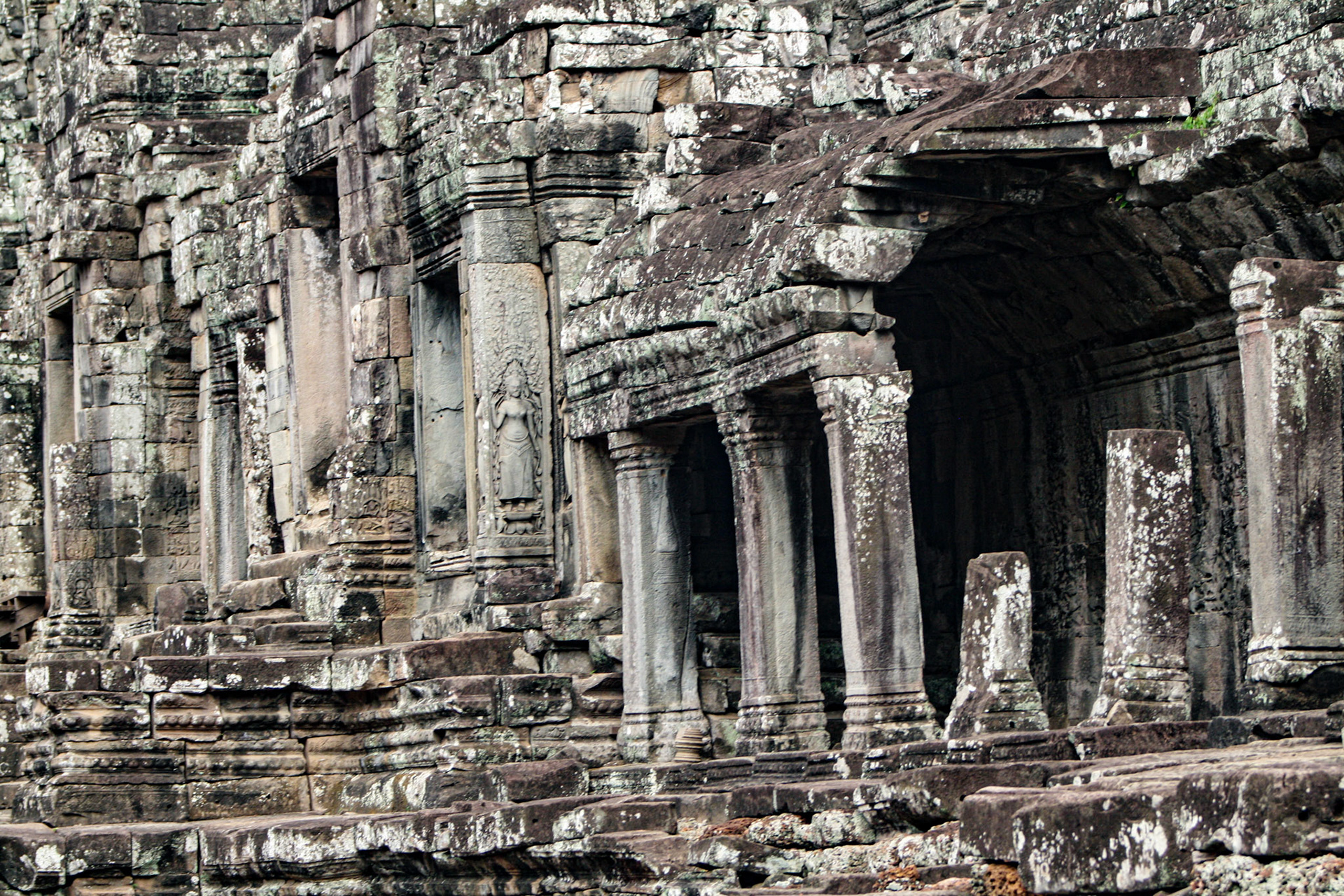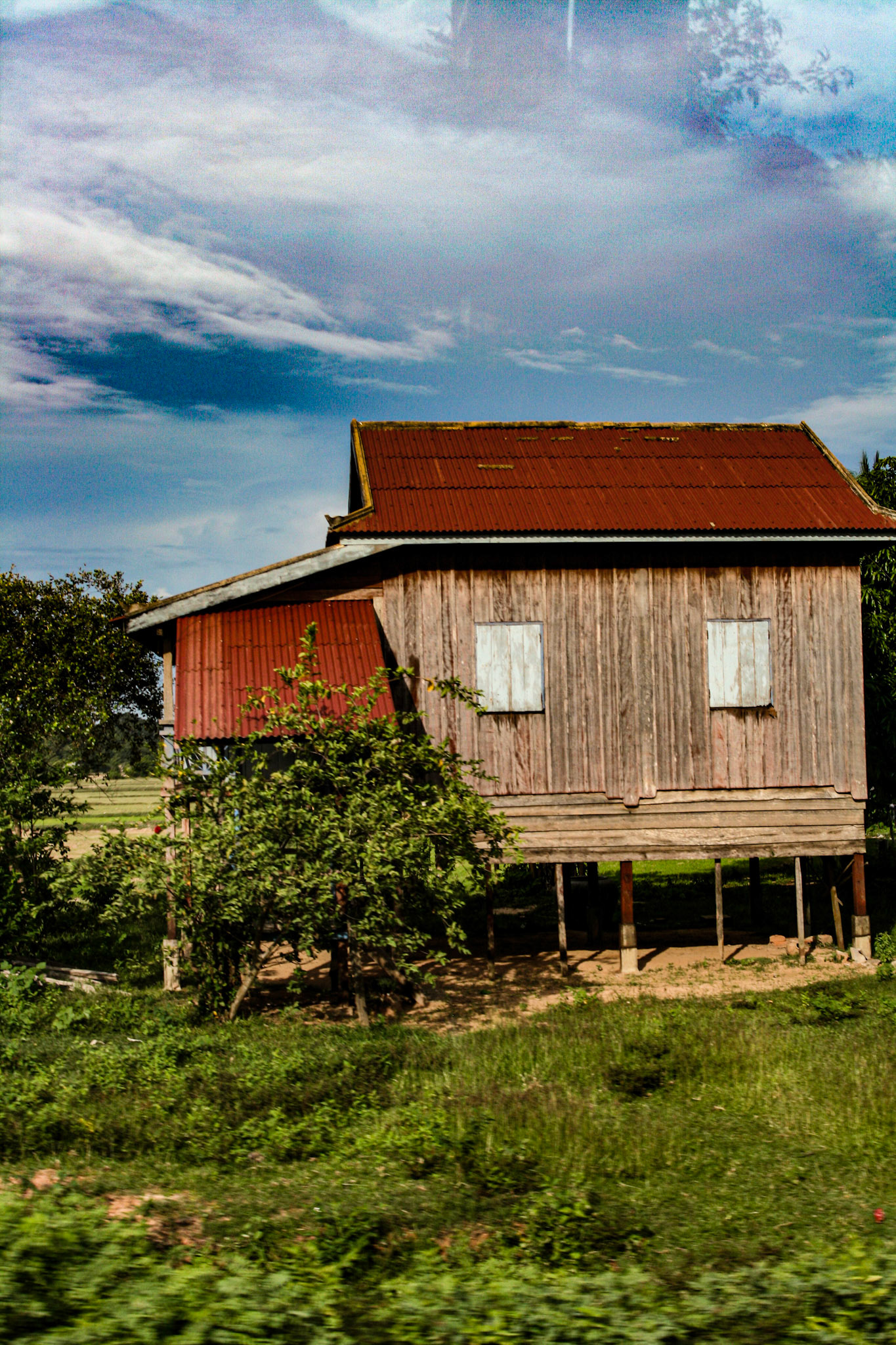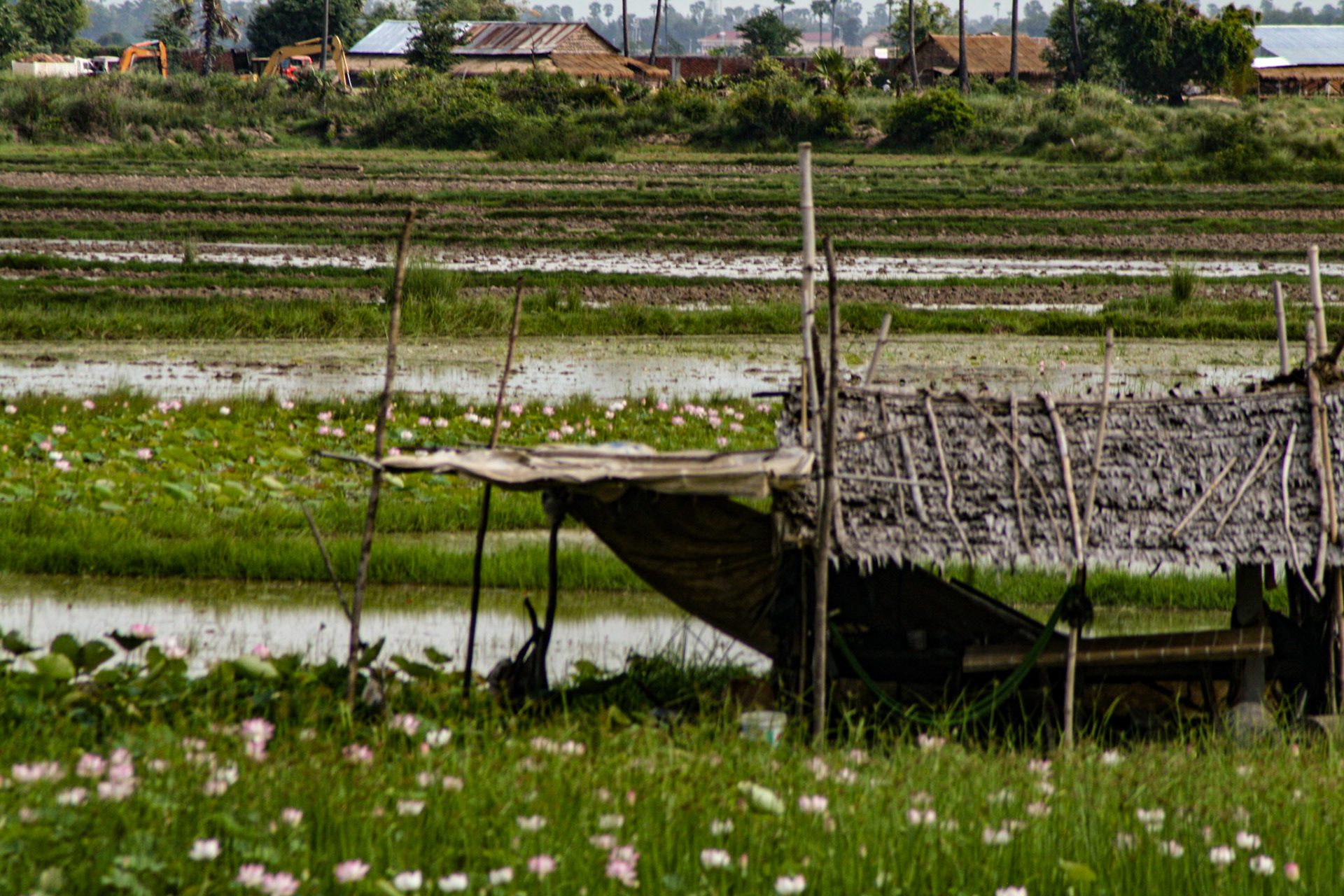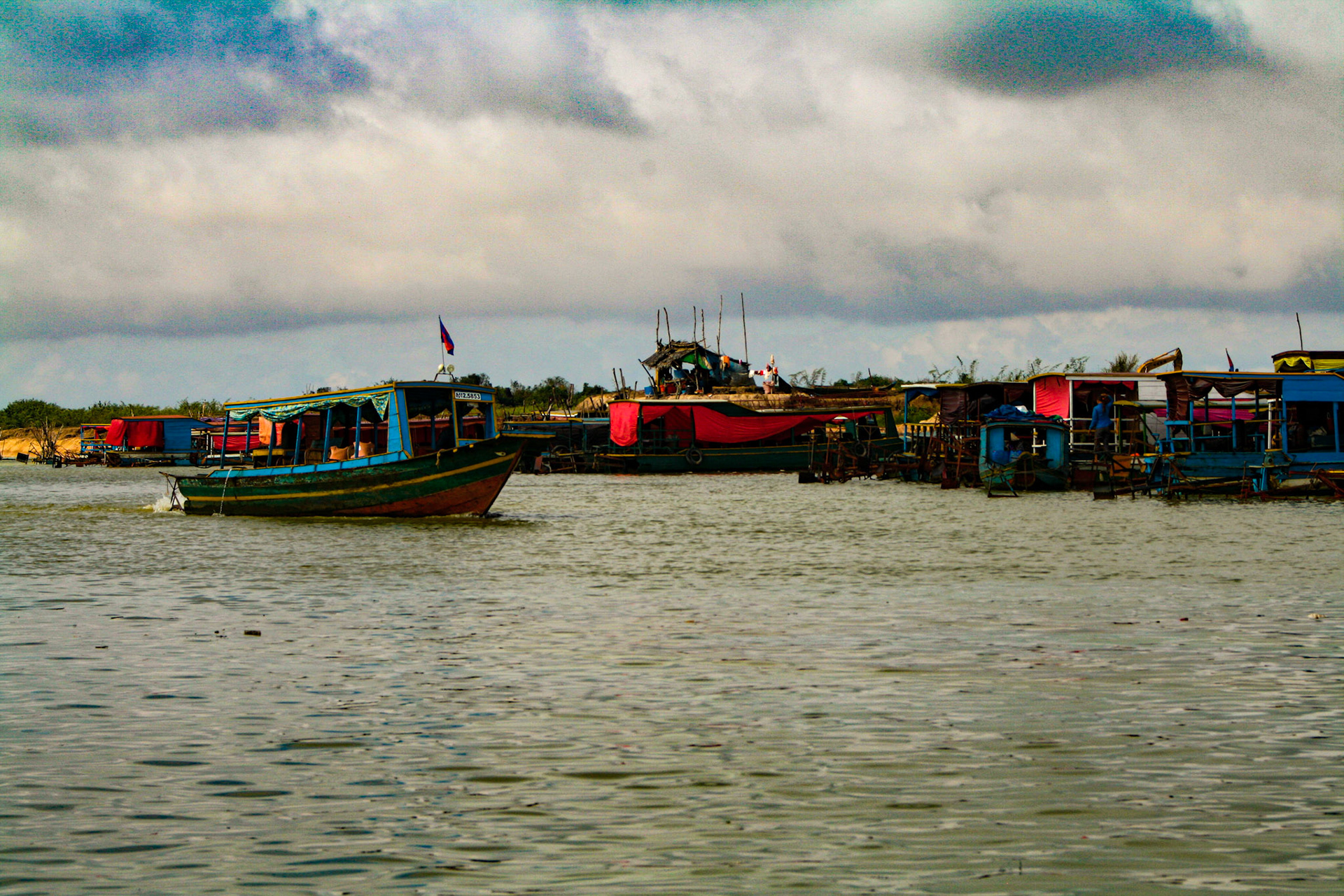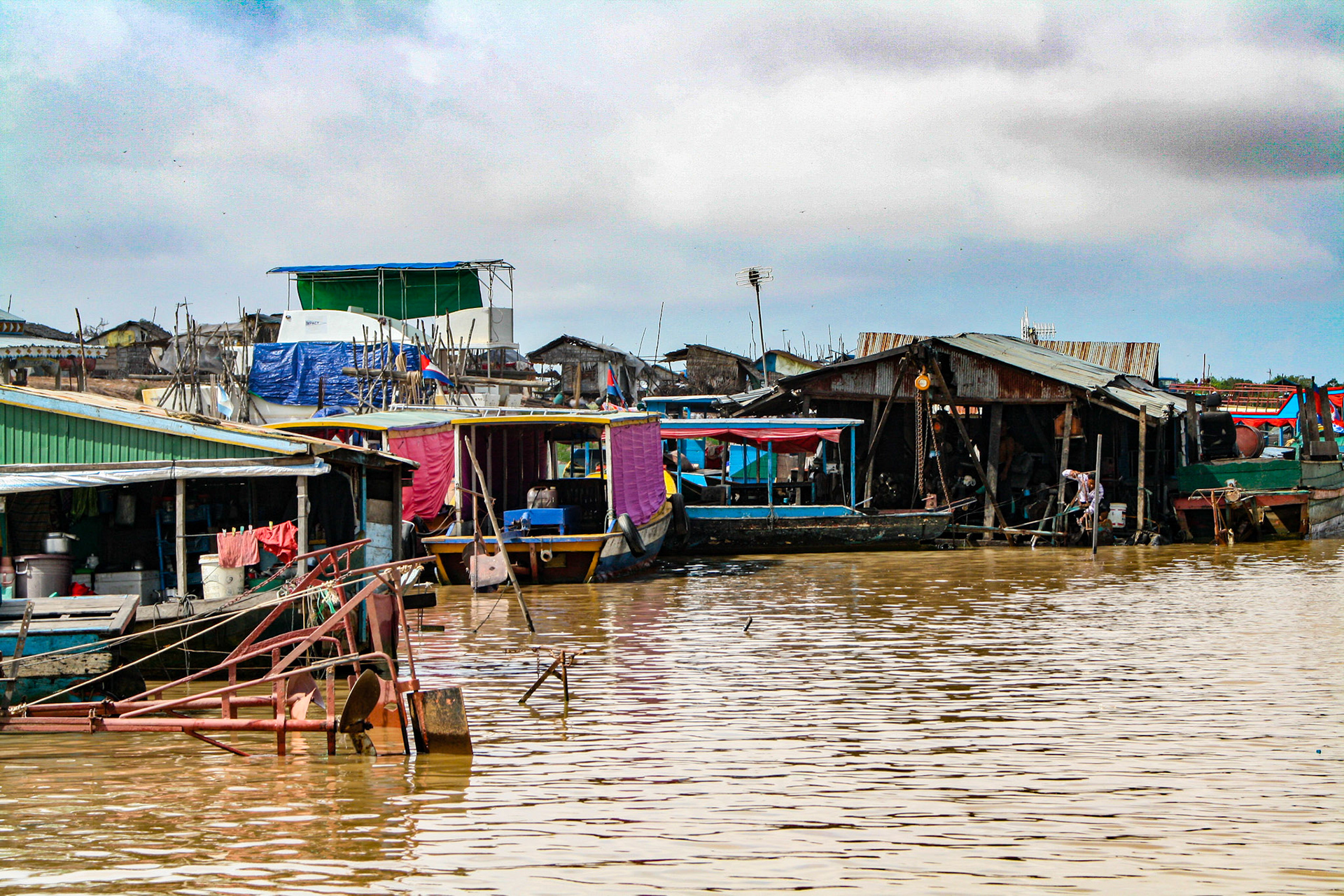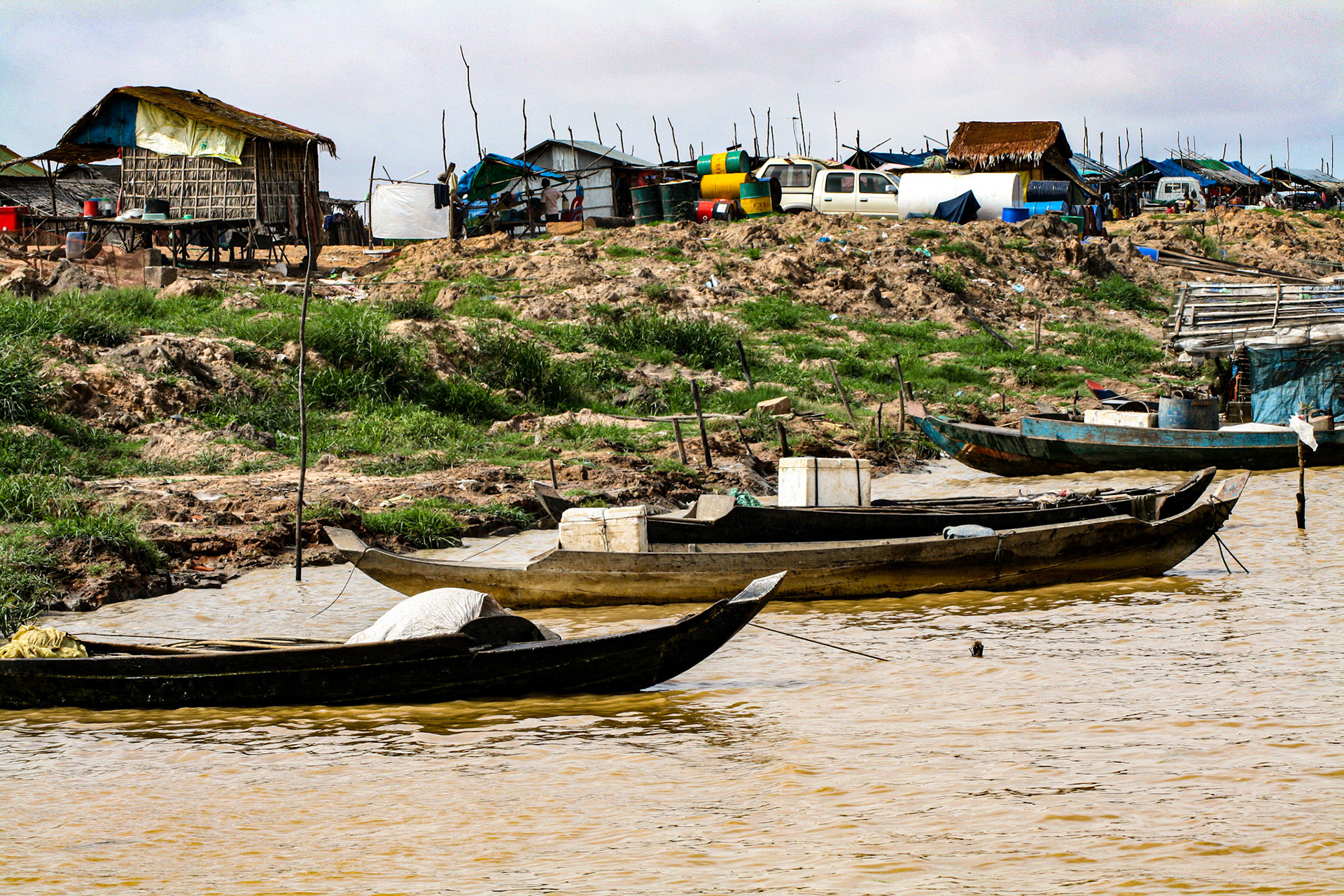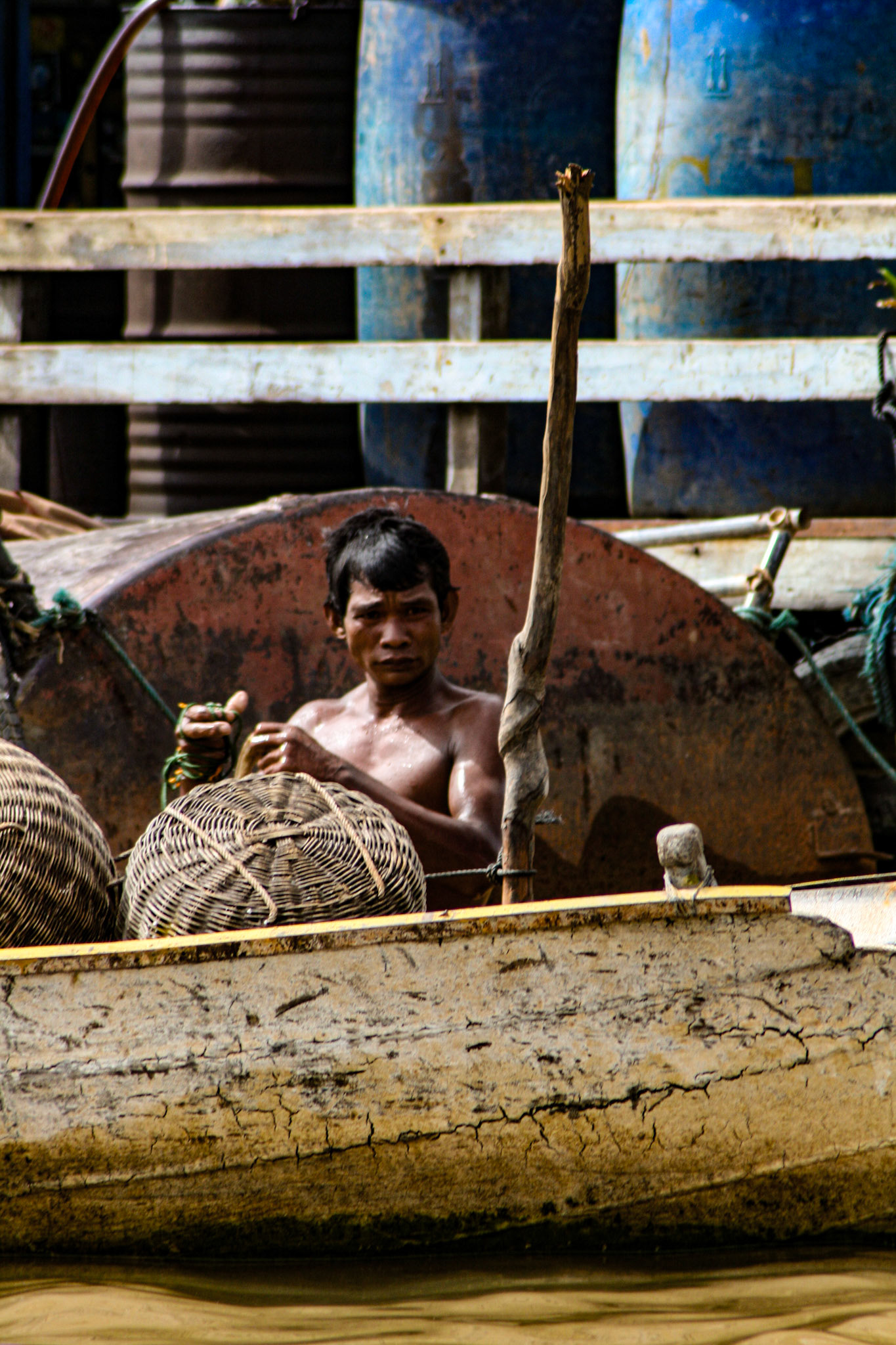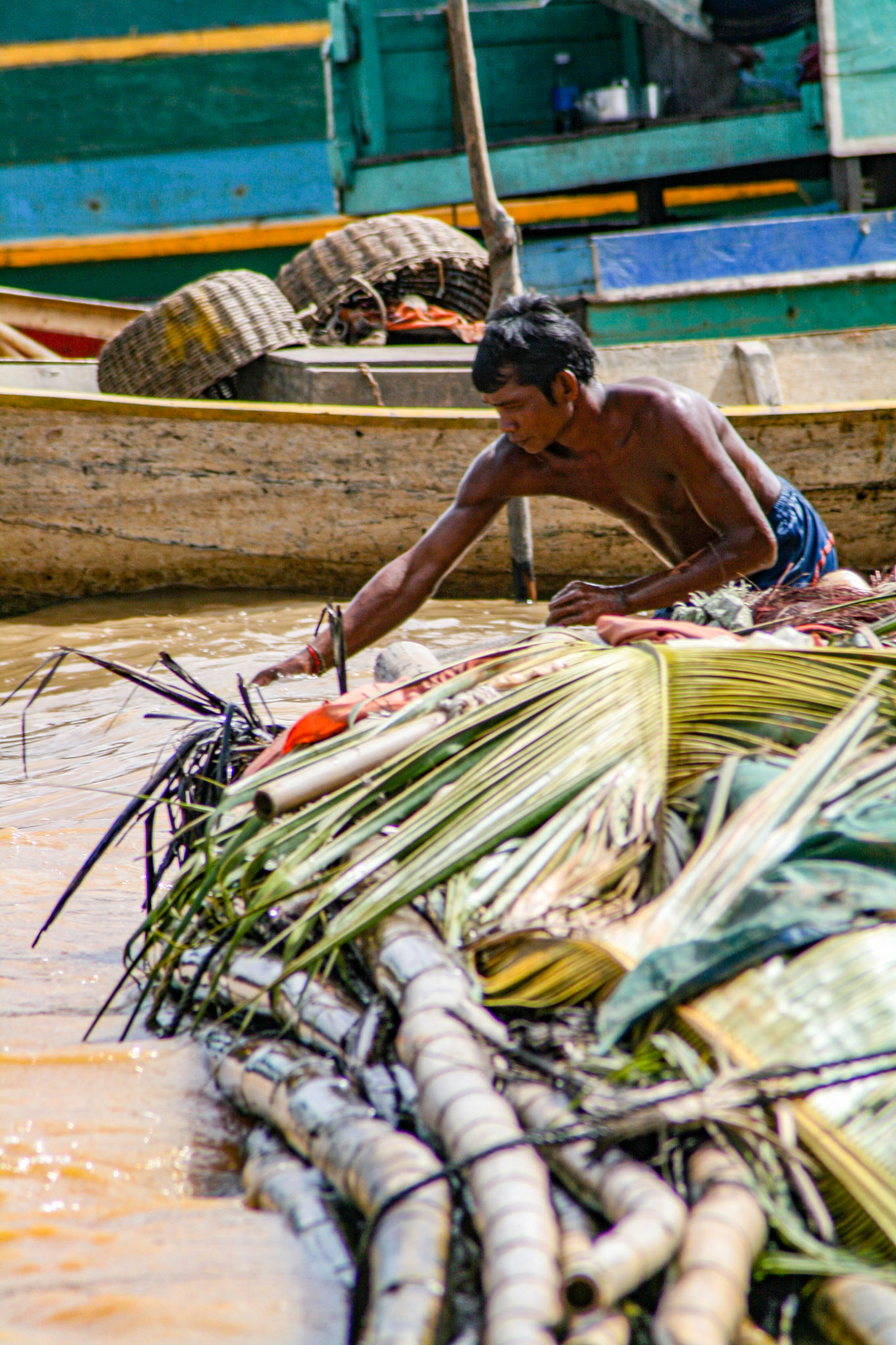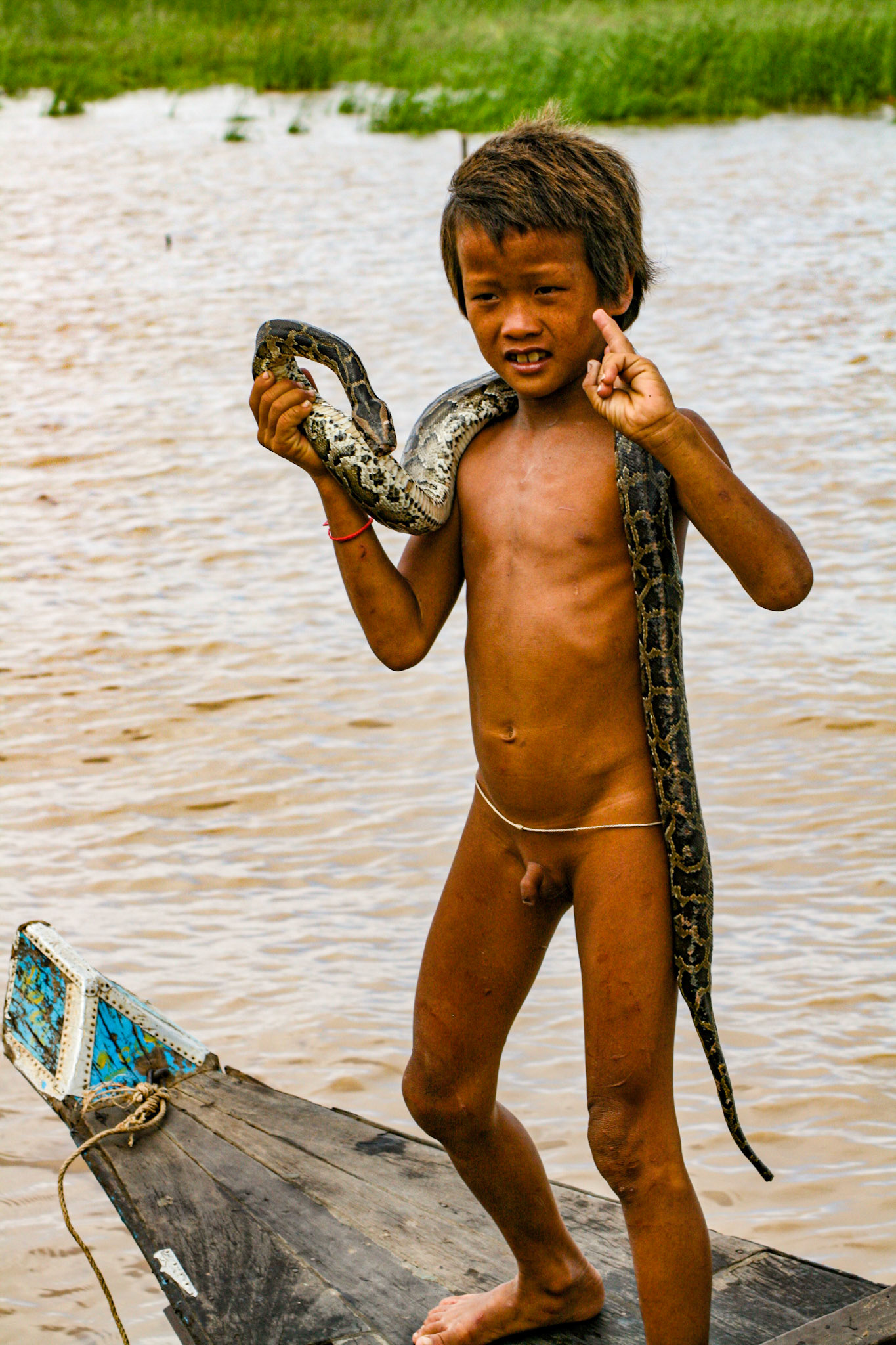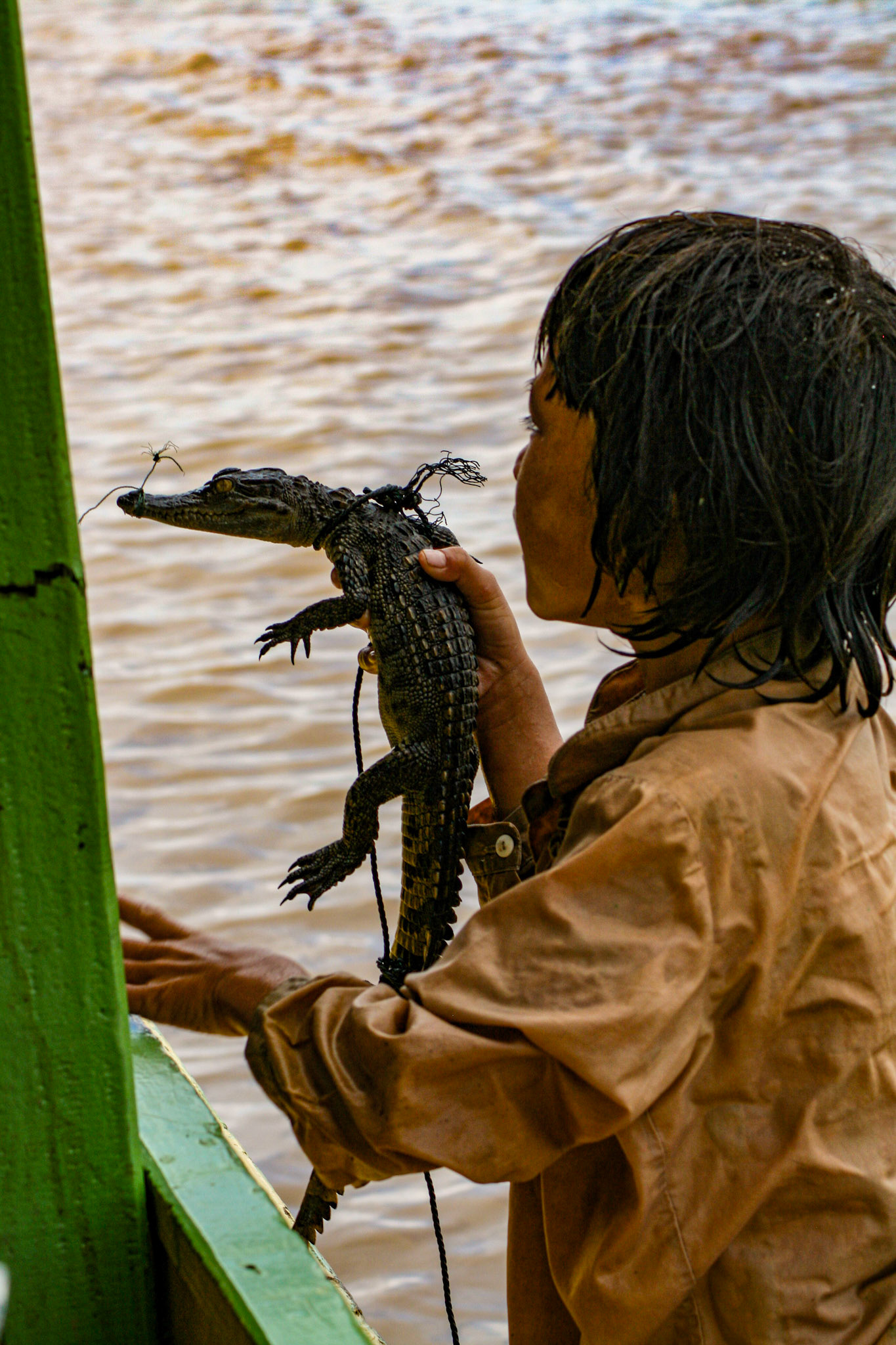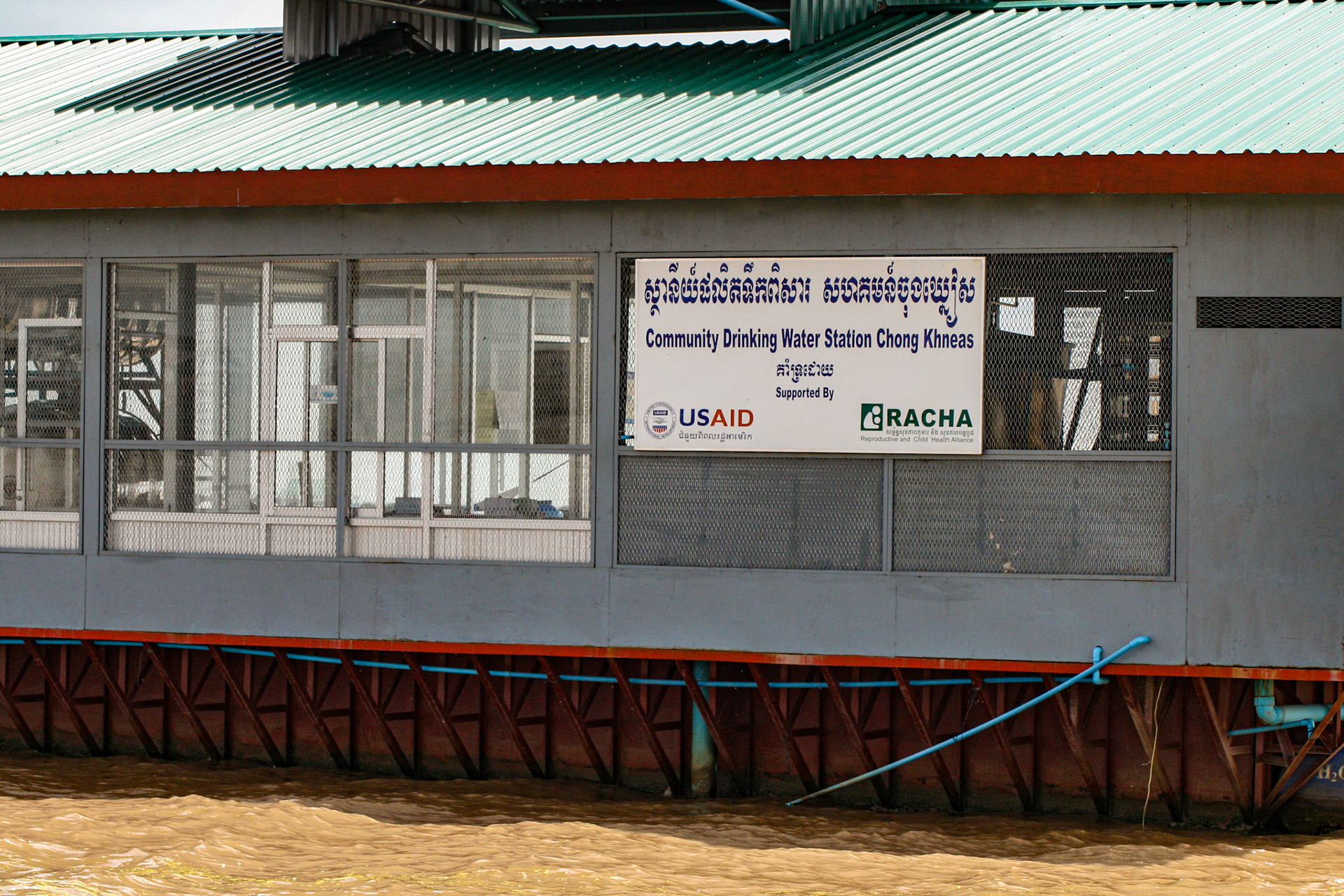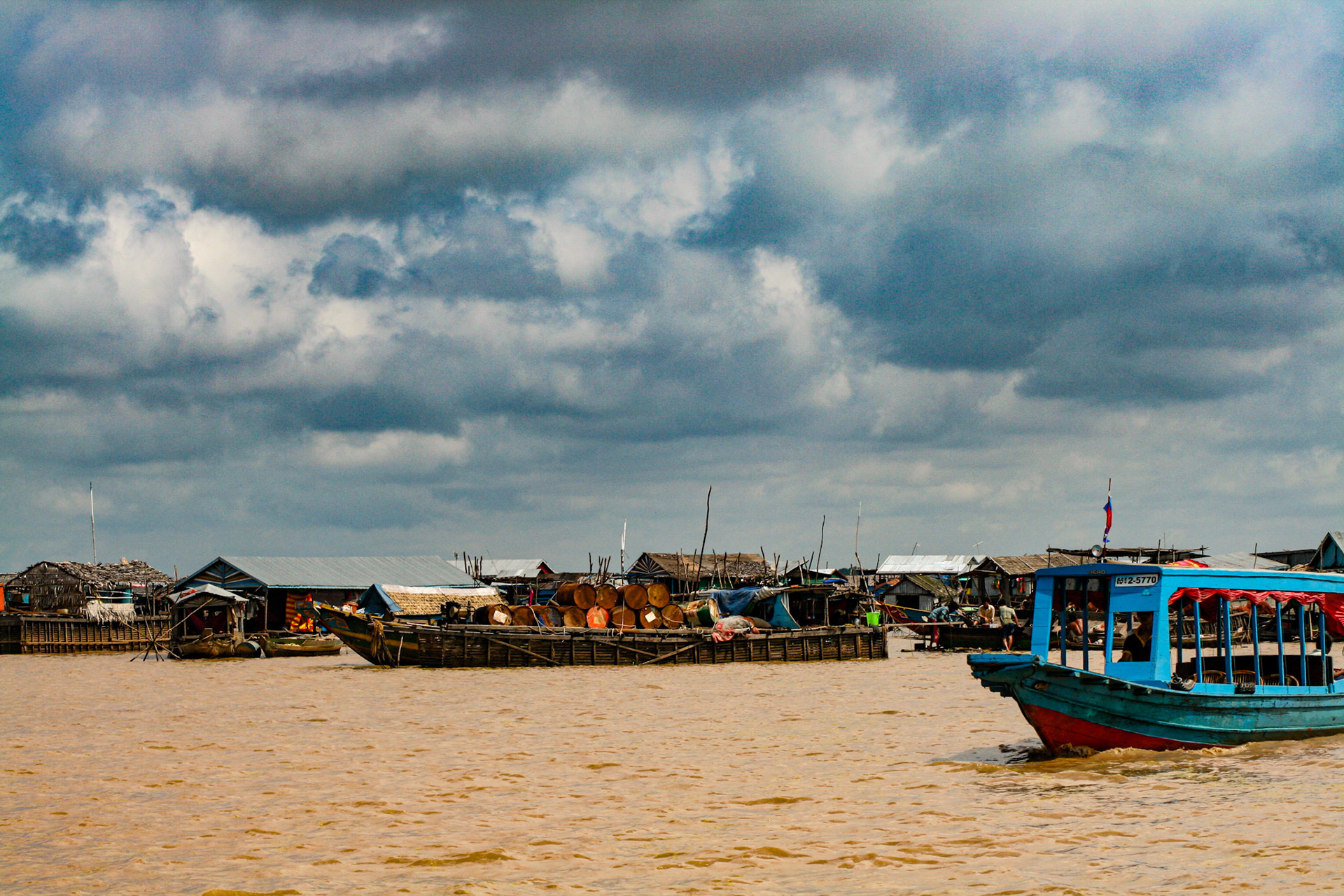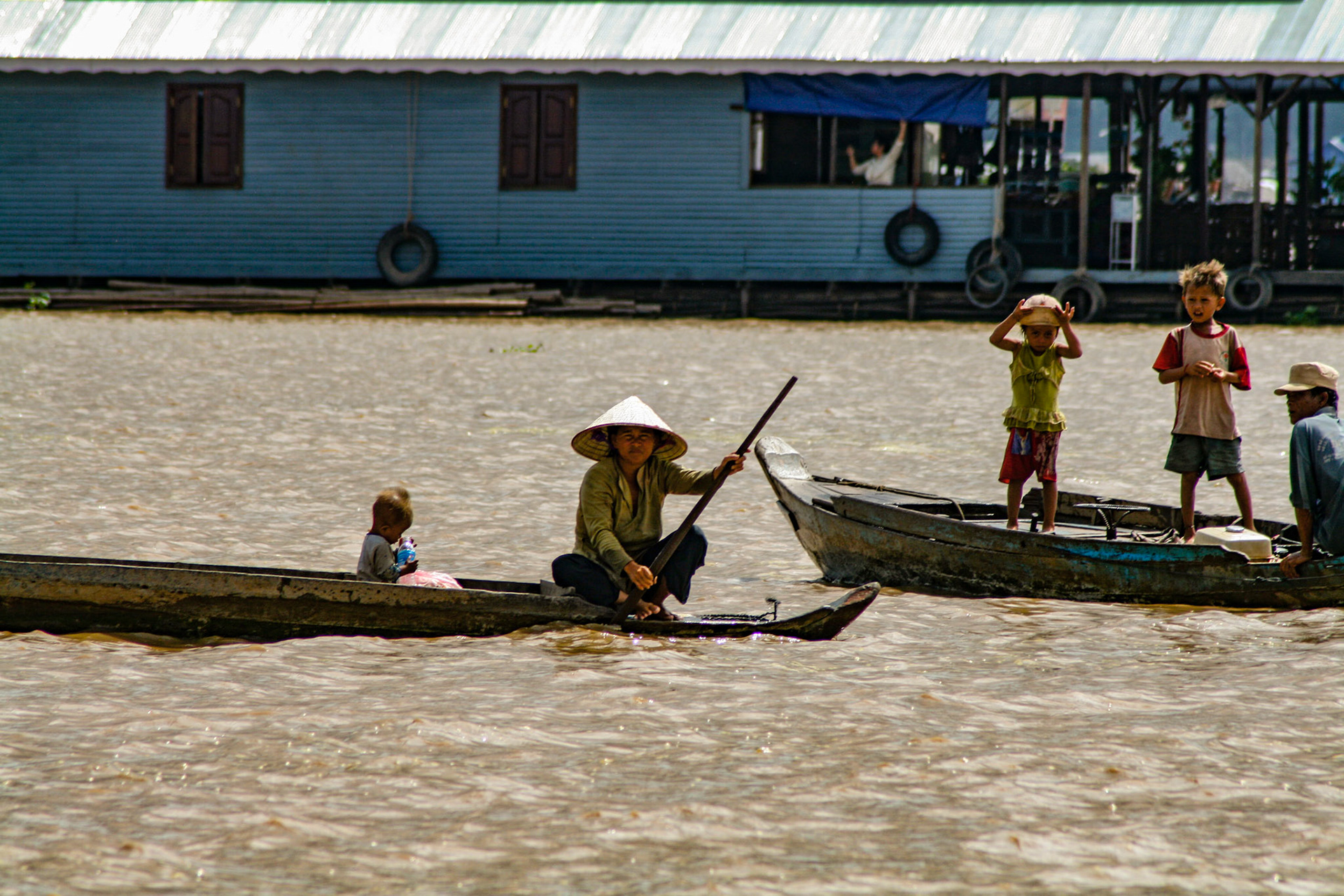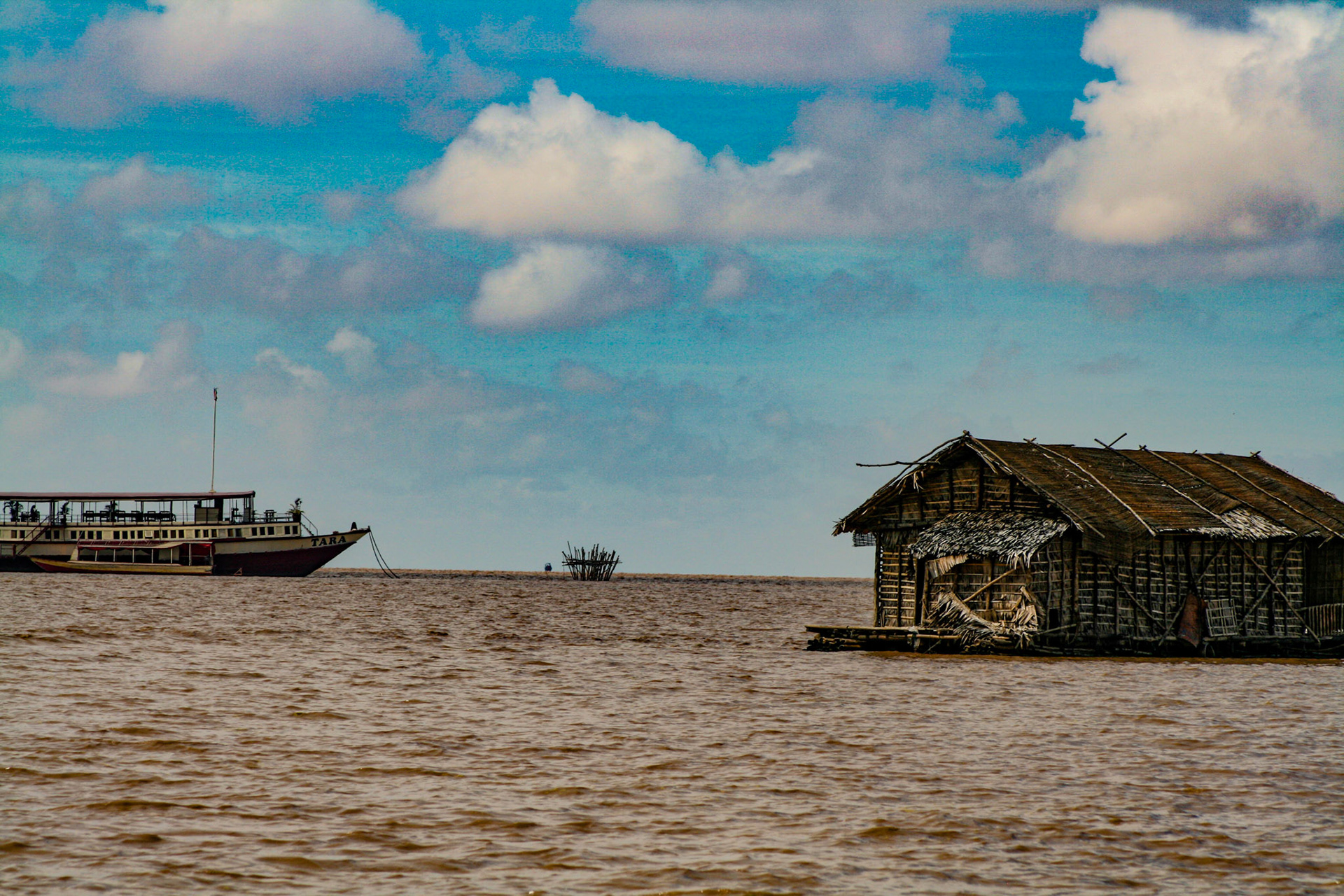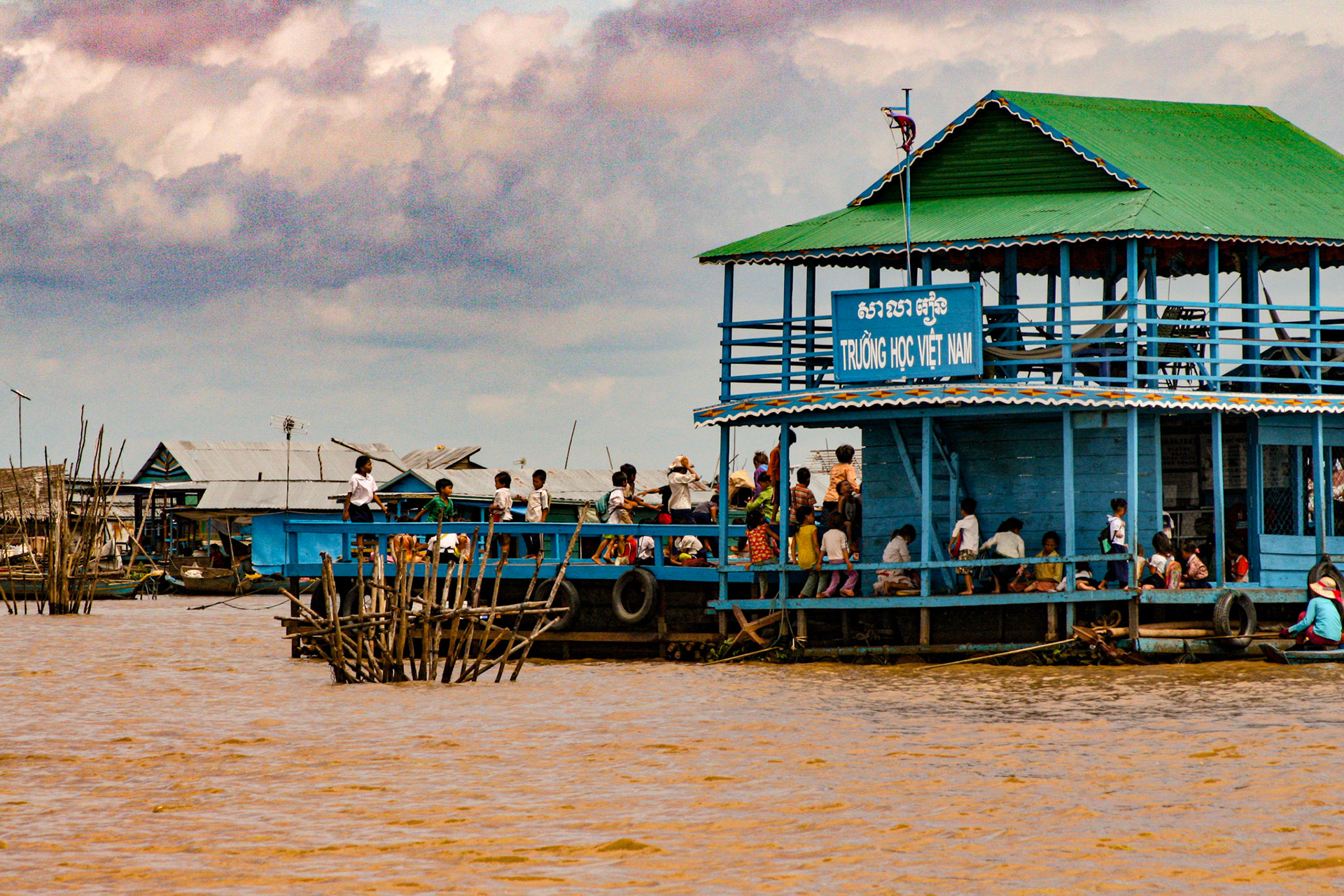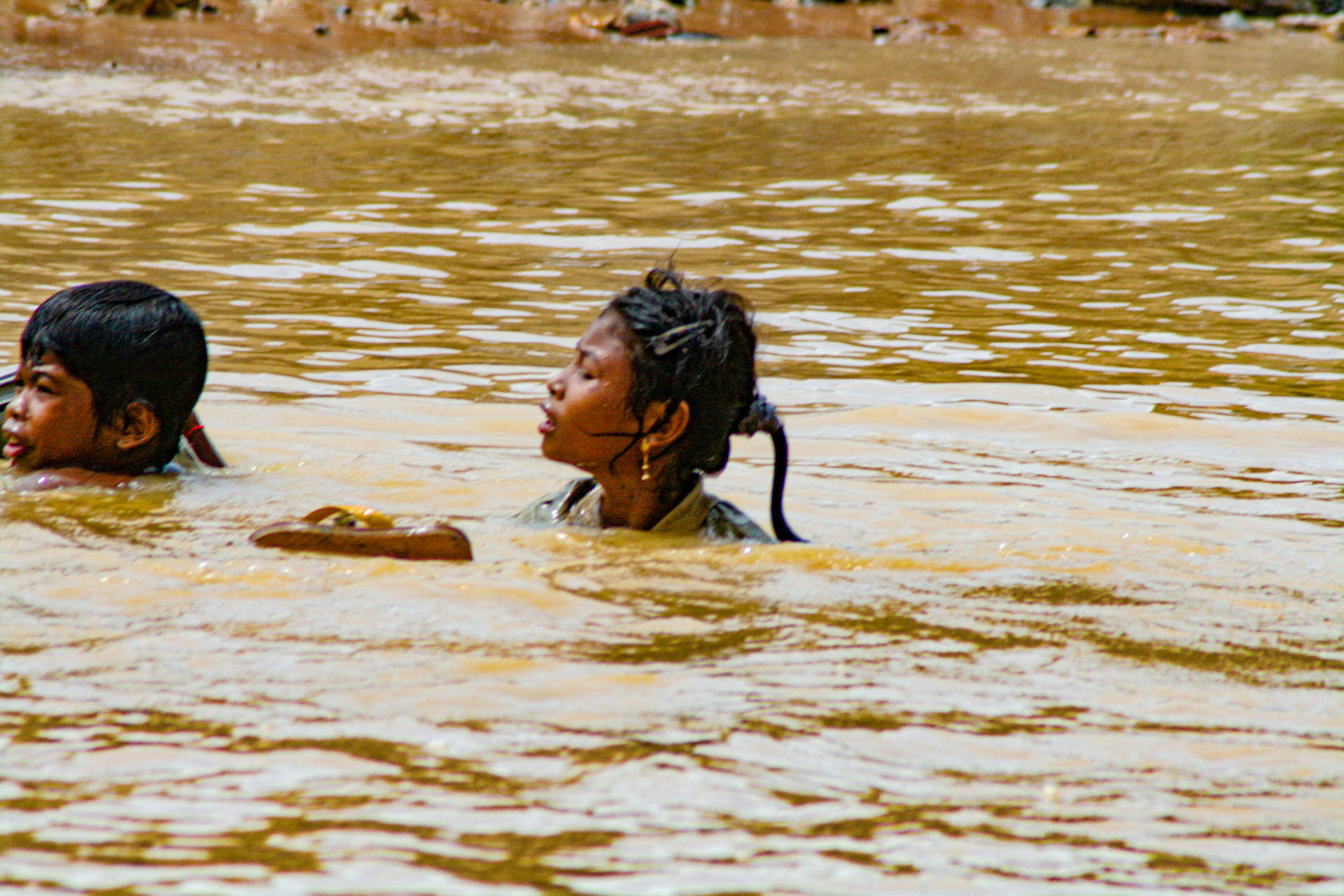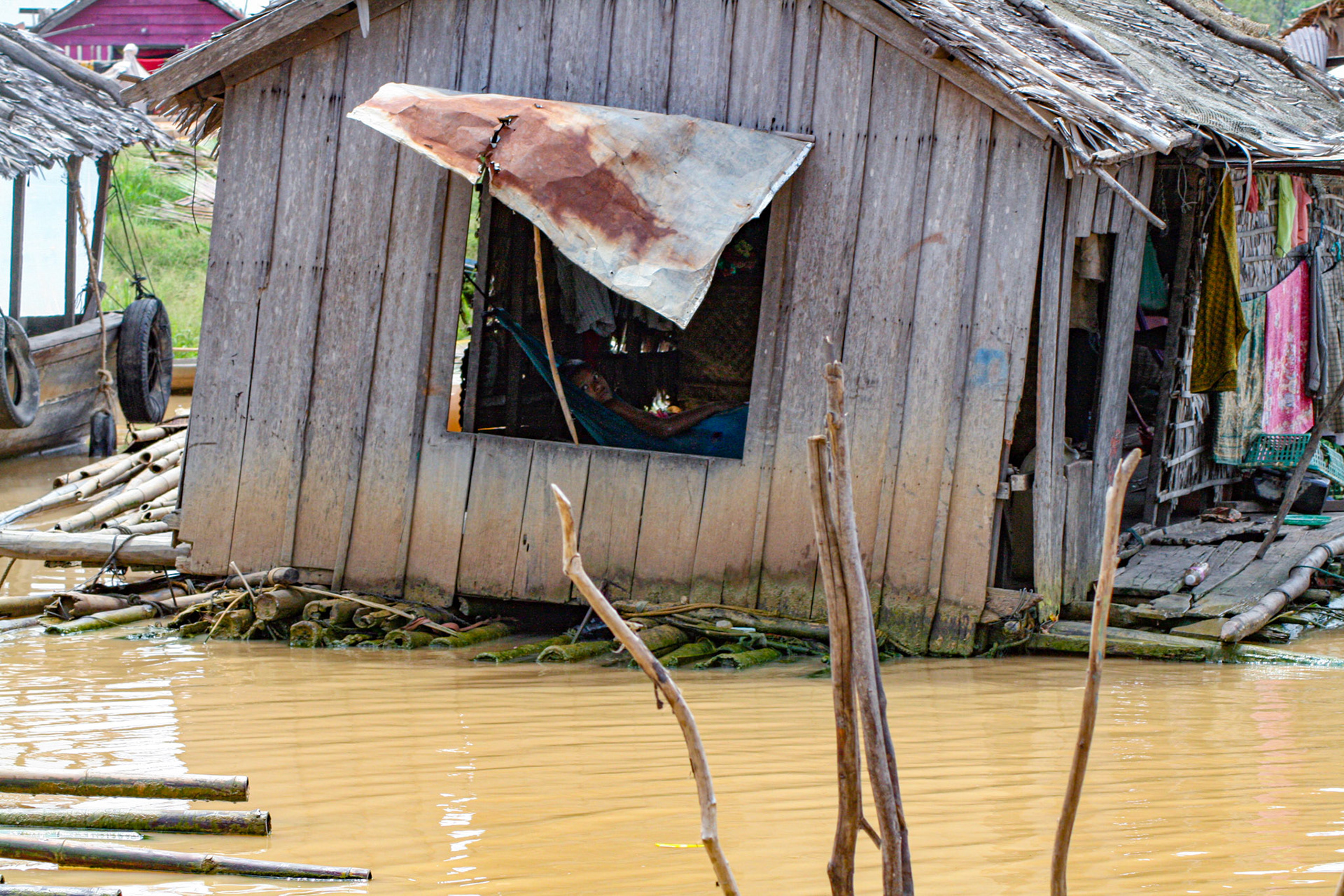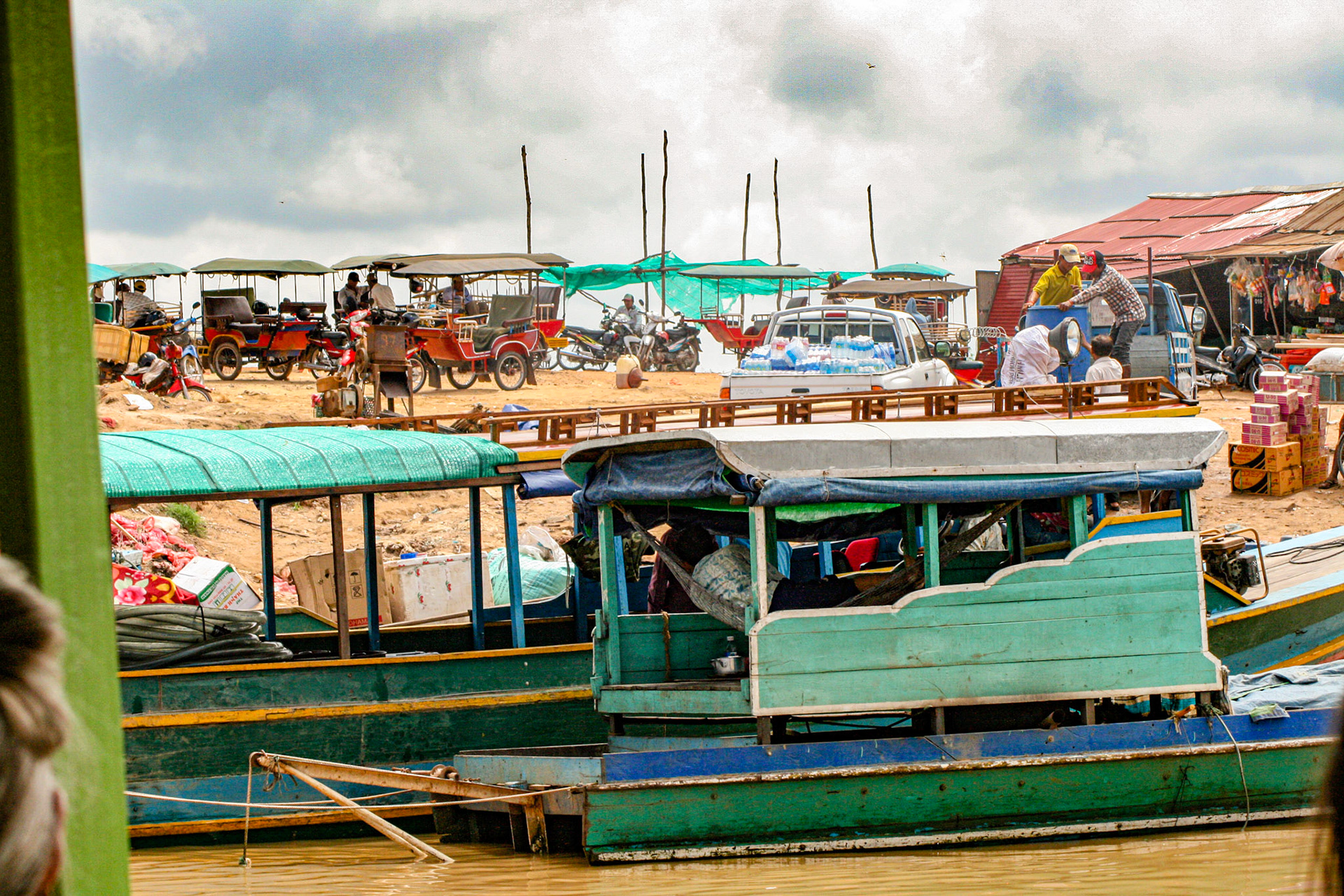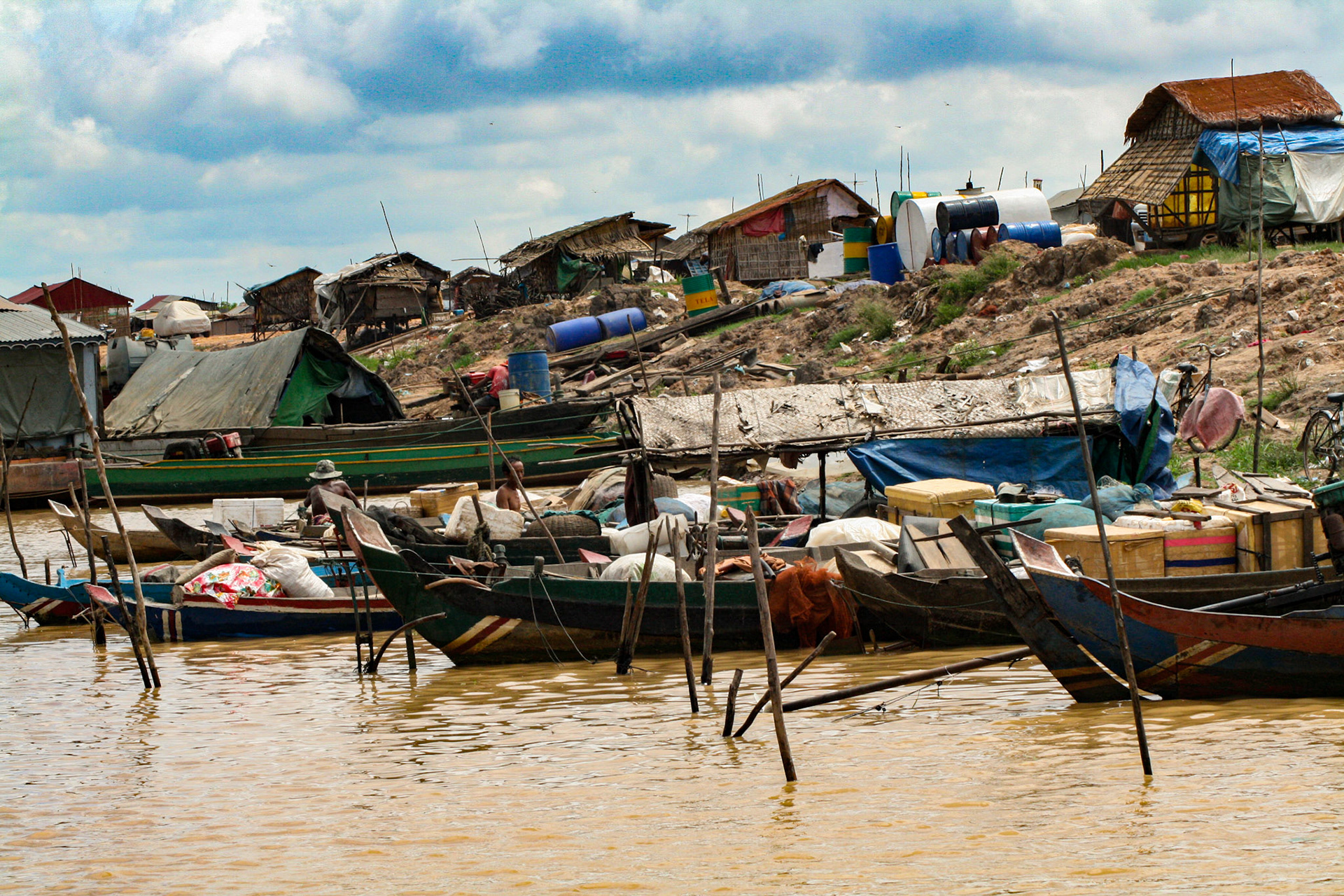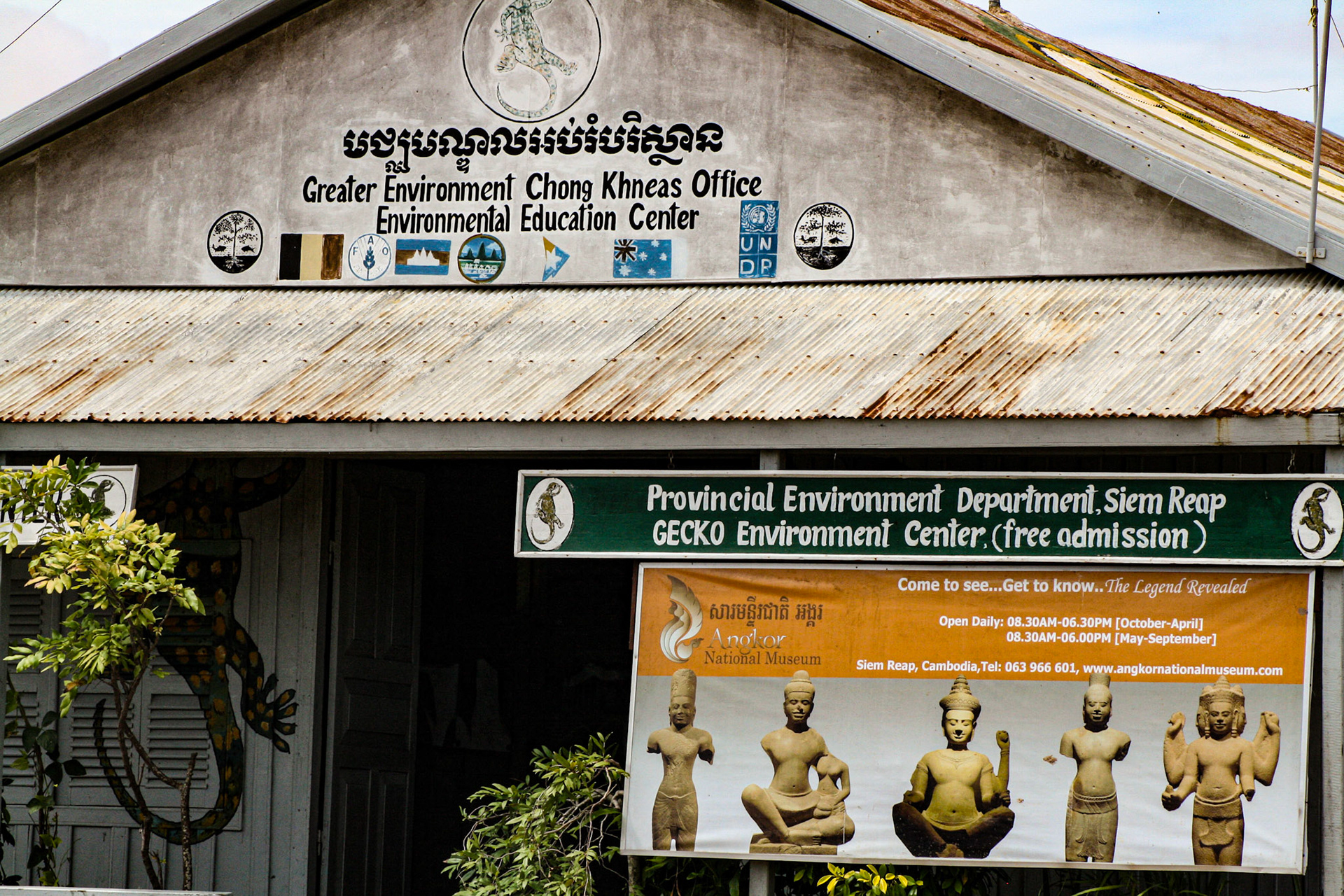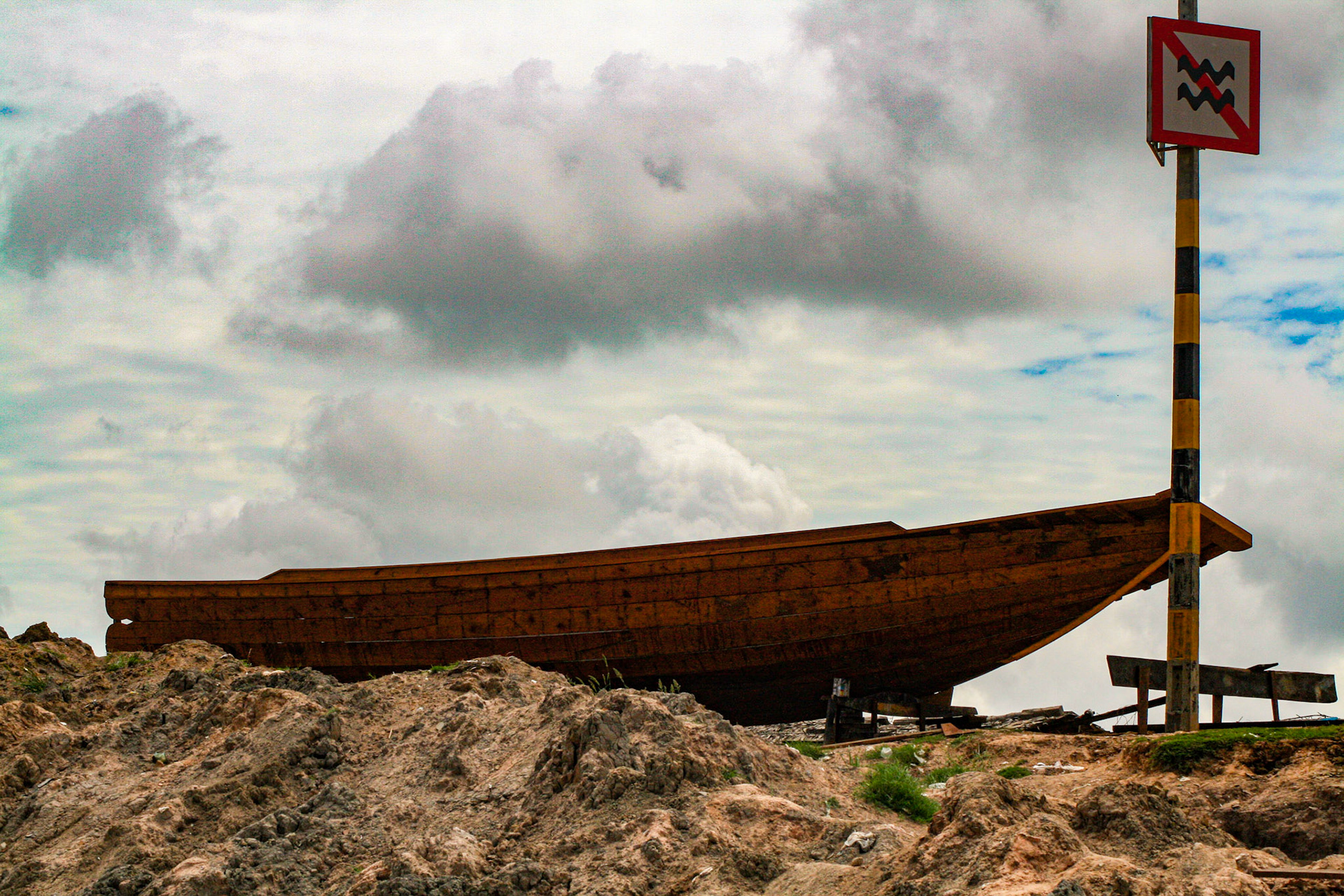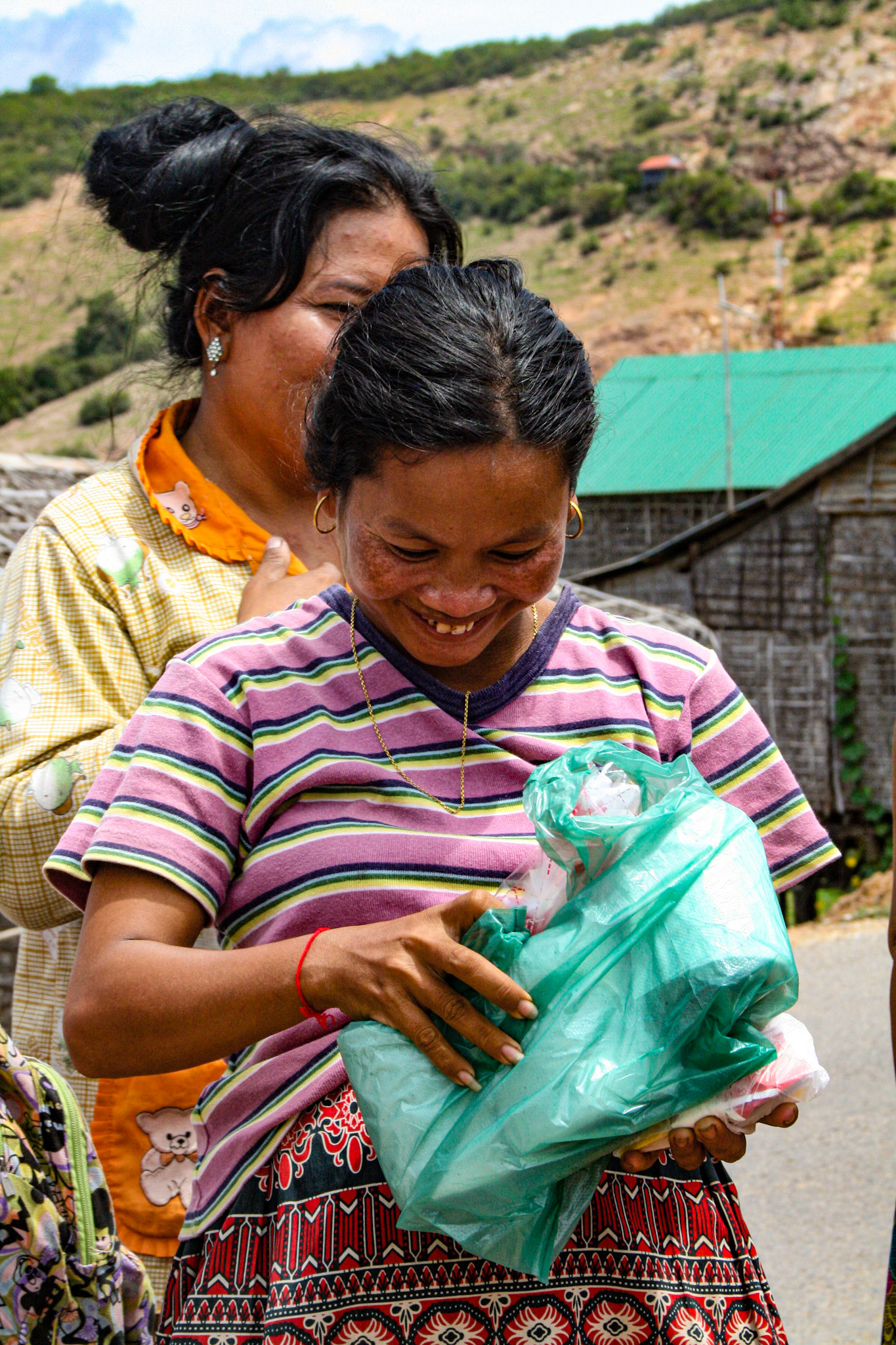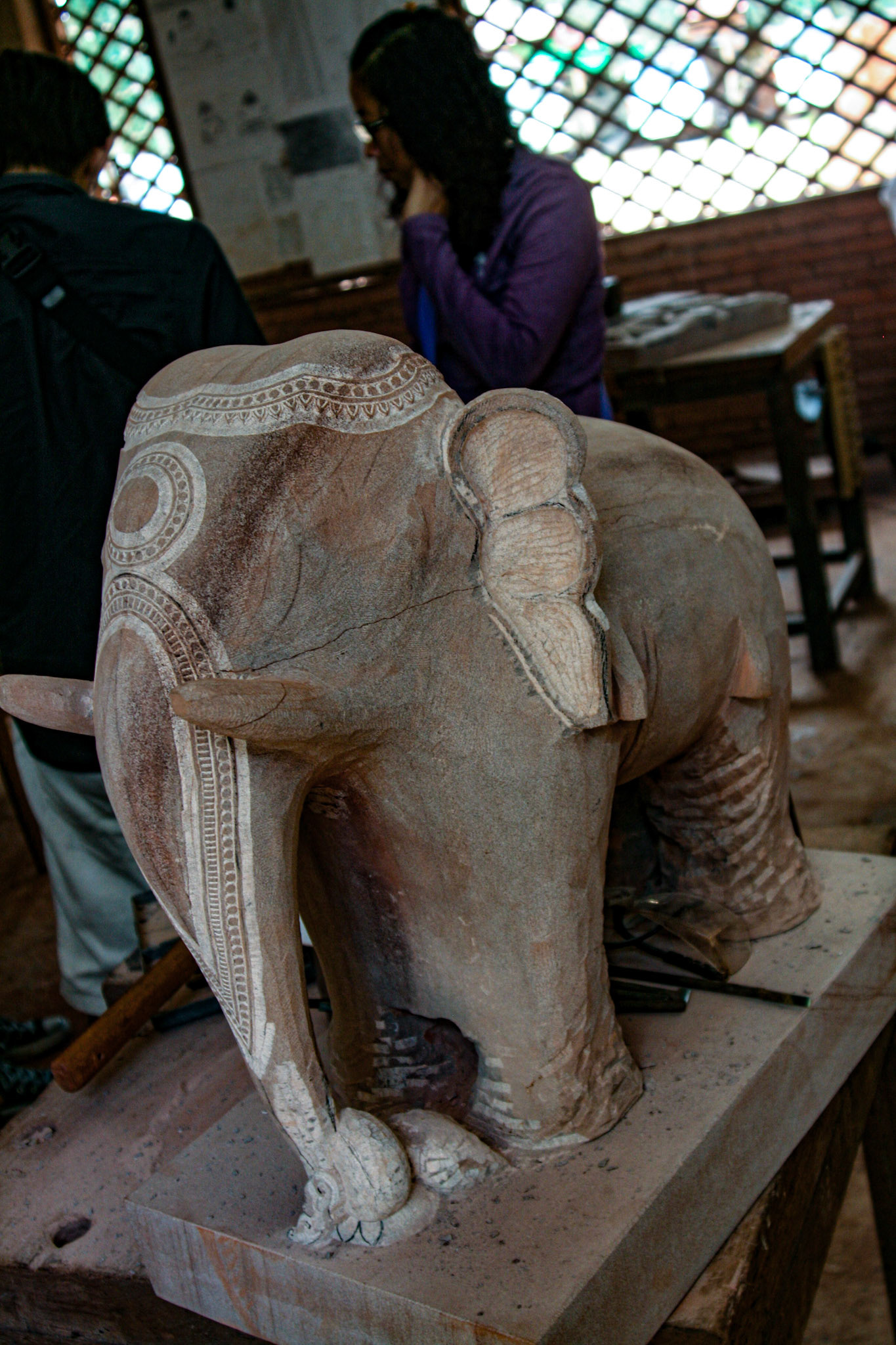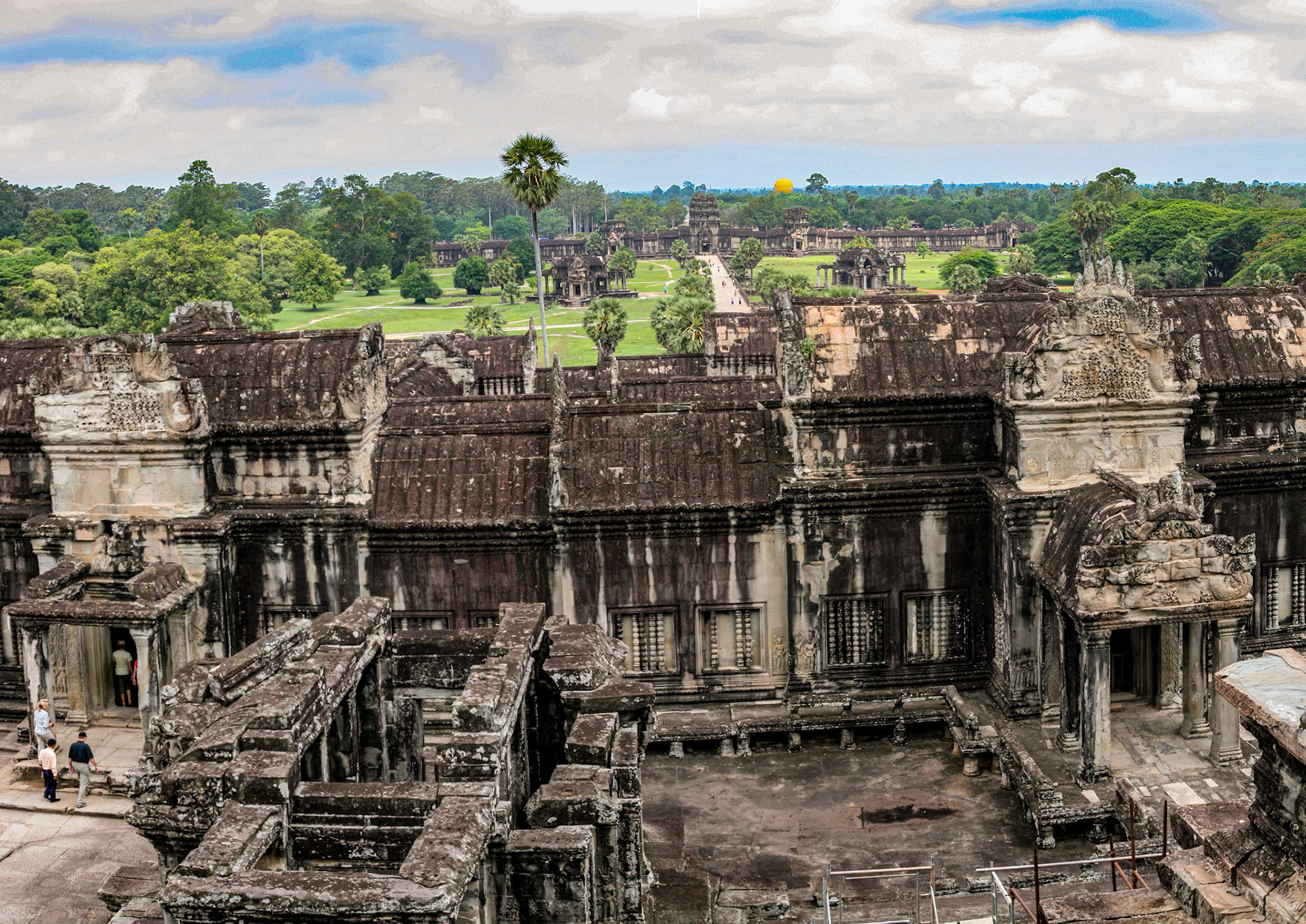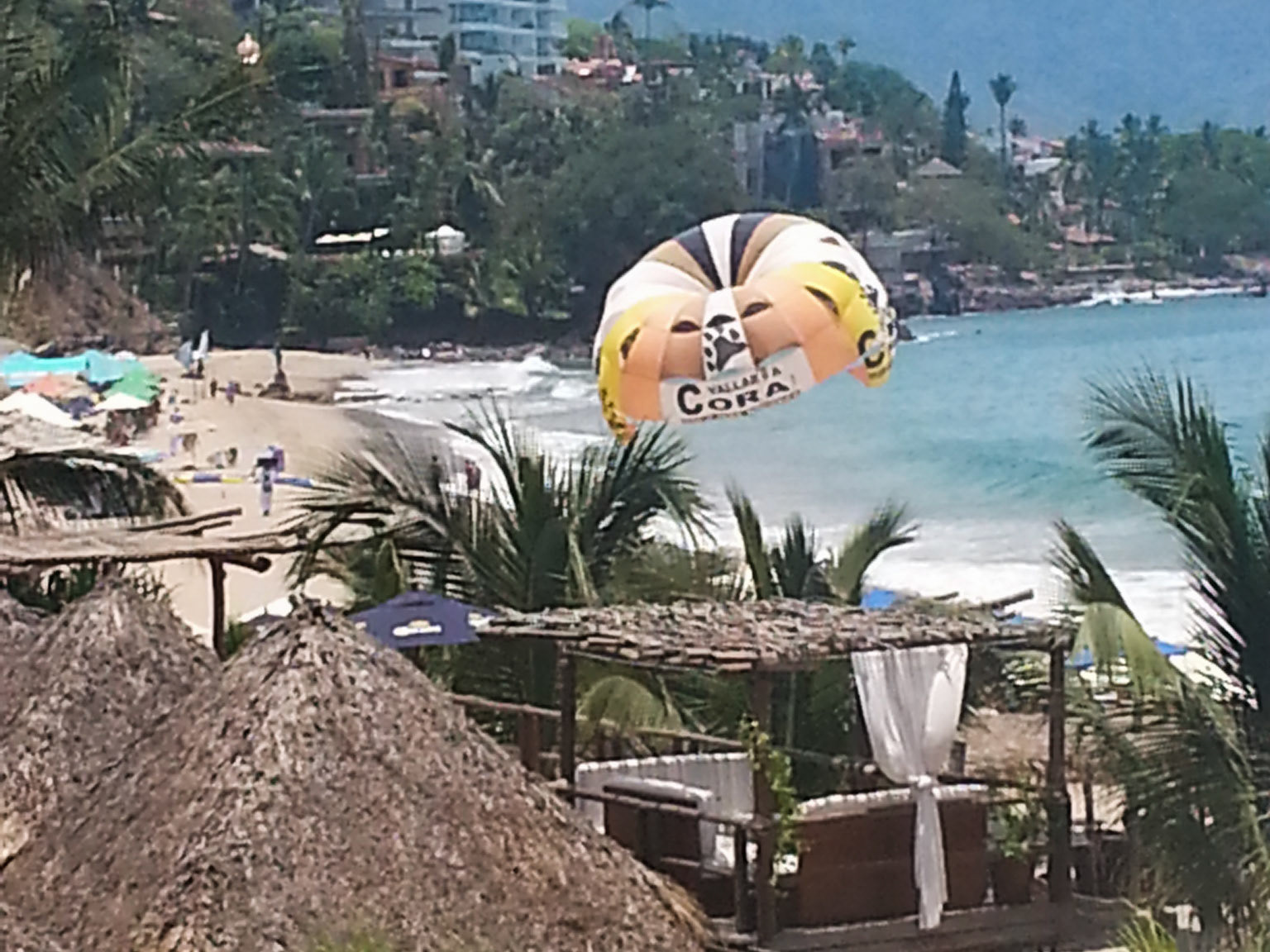
Angkor Wat meaning "Temple City" is a temple complex in Cambodia and is the largest religious monument in the world on a site measuring 162.6 hectares (1,626,000 m2; 402 acres). Breaking from Shaiva tradition of previous kings, Angkor Wat was dedicated to Vishnu for the Khmer Empire.

The first great temple mountain was the Bakong, a five-level pyramid dedicated in 881 by King Indravarman I. The structure of Bakong took shape of stepped pyramid, popularly identified as temple mountain of early Khmer temple architecture.

As the best-preserved temple at the site, Angkor Wat is the only one to have remained a significant religious center since its foundation. The temple is at the top of the high classical style of Khmer architecture. It is one of the most important pilgrimage sites for Buddhists in Cambodia and around the world, having played a major role in converting Cambodia into a Buddhist nation. It has become a symbol of Cambodia, appearing on its national flag, and is the country's main tourist attraction.

Bas-reliefs are individual figures, groups of figures, or entire scenes cut into stone walls, not as drawings but as sculpted images projecting from a background.

Ancient Khmer bas relief frieze of the Hindu gods. Wall of Angkor Wat temple.

Bas relief detail. Angkor Wat, Cambodia

Bas-reliefs are individual figures, groups of figures, or entire scenes cut into stone walls, not as drawings but as sculpted images projecting from a background.

Bas-reliefs are individual figures, groups of figures, or entire scenes cut into stone walls, not as drawings but as sculpted images projecting from a background.

Bas-reliefs are individual figures, groups of figures, or entire scenes cut into stone walls, not as drawings but as sculpted images projecting from a background.

The first great temple mountain was the Bakong, a five-level pyramid dedicated in 881 by King Indravarman I. The structure of Bakong took shape of stepped pyramid, popularly identified as temple mountain of early Khmer temple architecture.

The first great temple mountain was the Bakong, a five-level pyramid dedicated in 881 by King Indravarman I. The structure of Bakong took shape of stepped pyramid, popularly identified as temple mountain of early Khmer temple architecture.

Angkor Wat Eastern wall.

Angkor Wat Eastern wall.

Sam Luna makes the steep climb up into the temple at Angkor Wat. Bakan - The Principal Sanctuary of Angkor Wat. The summit of Angkor Wat's central temple, the highest of temple's three galleries and the uppermost point of world's largest religious complex.

Angkor Wat meaning "Temple City" is a temple complex in Cambodia and is the largest religious monument in the world on a site measuring 162.6 hectares (1,626,000 m2; 402 acres).

Buddhism proliferated in the Cambodian region during the 13th century. Gradually, it became the dominant religion of Cambodia and Angkor Wat, along with other Hindu monuments, were repurposed for Buddhist worship. Buddhist iconography was added alongside the existing Hindu symbols and sculptures of Buddha were erected. The temple continues to be used for Buddhist worship to this day.

Buddhism proliferated in the Cambodian region during the 13th century. Gradually, it became the dominant religion of Cambodia and Angkor Wat, along with other Hindu monuments, were repurposed for Buddhist worship. Buddhist iconography was added alongside the existing Hindu symbols and sculptures of Buddha were erected. The temple continues to be used for Buddhist worship to this day.

Apsara of Angkor Wat, Khmer Temple, Siem Reap, Cambodia.

A corner tower of Angkor Wat

Angkor Wat is constructed with about 5 million tons of sandstone, likely obtained from a quarry 25 miles away with the help of 6000 elephants.

Angkor Wat meaning "Temple City" is a temple complex in Cambodia and is the largest religious monument in the world on a site measuring 162.6 hectares (1,626,000 m2; 402 acres).

People below are dwarfed when standing at the uppermost part of the monument.

Steps leading to Bakan - The Principal Sanctuary of Angkor Wat. The summit of Angkor Wat's central temple, the highest of temple's three galleries and the uppermost point of world's largest religious complex.

Bas-reliefs are individual figures, groups of figures, or entire scenes cut into stone walls, not as drawings but as sculpted images projecting from a background.

Bas-reliefs are individual figures, groups of figures, or entire scenes cut into stone walls, not as drawings but as sculpted images projecting from a background.

Dome over the central shrine of Angkor Wat

Angkor Wat is constructed with about 5 million tons of sandstone, likely obtained from a quarry 25 miles away with the help of 6000 elephants.

Buddhism proliferated in the Cambodian region during the 13th century. Gradually, it became the dominant religion of Cambodia and Angkor Wat, along with other Hindu monuments, were repurposed for Buddhist worship. Buddhist iconography was added alongside the existing Hindu symbols and sculptures of Buddha were erected. The temple continues to be used for Buddhist worship to this day.

Buddhism proliferated in the Cambodian region during the 13th century. Gradually, it became the dominant religion of Cambodia and Angkor Wat, along with other Hindu monuments, were repurposed for Buddhist worship. Buddhist iconography was added alongside the existing Hindu symbols and sculptures of Buddha were erected. The temple continues to be used for Buddhist worship to this day.

Buddhism proliferated in the Cambodian region during the 13th century. Gradually, it became the dominant religion of Cambodia and Angkor Wat, along with other Hindu monuments, were repurposed for Buddhist worship. Buddhist iconography was added alongside the existing Hindu symbols and sculptures of Buddha were erected. The temple continues to be used for Buddhist worship to this day.

Ancient Tamil at Angkor Wat

Vintage style artwork of Khmer on brown stone pillars and ceilings, Inside the temple of Angkor Wat, Siem Reap, Cambodia

Bas reliefs detail.

The galleries of narrative bas-reliefs at Angkor Wat are a masterpiece of the Khmer period that feature several important mythological events such as scenes from the Ramayana, the Mahabharat, and the Churning of the Ocean of Milk, as well as some historical occurrences from the life of Suryavarman II.

The galleries of narrative bas-reliefs at Angkor Wat are a masterpiece of the Khmer period that feature several important mythological events such as scenes from the Ramayana, the Mahabharat, and the Churning of the Ocean of Milk, as well as some historical occurrences from the life of Suryavarman II.

The galleries of narrative bas-reliefs at Angkor Wat are a masterpiece of the Khmer period that feature several important mythological events such as scenes from the Ramayana, the Mahabharat, and the Churning of the Ocean of Milk, as well as some historical occurrences from the life of Suryavarman II.

Bas reliefs detail.

Bas reliefs detail.

Bas reliefs detail.

Khmer design elements usually entail sculptures of nagas (snakes) and lions flanking the various causeway entrances, well-turned window balusters, and intricately carved surfaces

Khmer design elements usually entail sculptures of nagas (snakes) and lions flanking the various causeway entrances, well-turned window balusters, and intricately carved surfaces

The dominant scheme for the construction of state temples in the Angkorian period was that of the Temple Mountain, an architectural representation of Mount Meru, the home of the gods in Hinduism. Enclosures represented the mountain chains surrounding Mount Meru, while a moat represented the ocean. The temple itself took shape as a pyramid of several levels, and the home of the gods was represented by the elevated sanctuary at the center of the temple.

Sam Luna poses in front of Angkor Wat.

To this day, Angkor Wat is a place of worship. It is not uncommon to see Buddhist monks walking the grounds.

Khmer design elements usually entail sculptures of nagas (snakes) and lions flanking the various causeway entrances, well-turned window balusters, and intricately carved surfaces

Locals playing a game with small stones.

Local music group plays as we exit the temple.

Ta Prohm Temple

Ta Prohm Temple

Ta Prohm Temple - Discovered deeply overgrown by jungle vegetation, some of the roots and trees have been left as they were found to maintain a picturesque “appearance of neglect.”

Ta Prohm - next to Angkor Wat - is one of the largest structures of the Angkor ruins complex. The buildings occupy an area of 650,000 square meters (about twice the area of a large shopping mall).

Ta Prohm is a popular attraction of the Angkor temple complex because the archaeologists left it in the state as Henri Mouhot and Frenchhis expedition companions found him in the depths of the primeval forest at the very beginning of the 1860s.

Stone pillar window in the jungle temple of Ta Prohm, Angkor complex.

Statue of Buddha in Ta Prohm temple, Cambodia.

The jungle temple of Ta Prohm near Angkor Wat in Cambodia

Bas relief above carved stone entrance at Ta Prohm temple.

Bas relief detail.

Ta Prohm Temple Tower

Bas relief above carved stone entrance at Ta Prohm temple.

Ta Prohm is a popular attraction of the Angkor temple complex because the archaeologists left it in the state as Henri Mouhot and Frenchhis expedition companions found him in the depths of the primeval forest at the very beginning of the 1860s.

Ta Prohm Temple - Discovered deeply overgrown by jungle vegetation, some of the roots and trees have been left as they were found to maintain a picturesque “appearance of neglect.”

Now claimed by the jungle, Ta Prohm was constructed in the late 12th and early 13th centuries CE. The complex is popular with tourists due to the site's appearance in the movie Tomb Raider.

Ta Prohm - next to Angkor Wat - is one of the largest structures of the Angkor ruins complex. The buildings occupy an area of 650,000 square meters (about twice the area of a large shopping mall).

Ta Prohm does not have as many narrative bas-reliefs as Angkor Wat or Angkor Thom, but some depictions of scenes from Buddhist mythology do remain. The temple also features stone reliefs of devatas (minor female deities), meditating monks or ascetics, and dvarapalas or temple guardians.

Ta Prohm Temple - Discovered deeply overgrown by jungle vegetation, some of the roots and trees have been left as they were found to maintain a picturesque “appearance of neglect.”

There are extraordinary structures, built with corbel-vaulted roofs capable of supporting heavy stone coverings.

There are extraordinary structures, built with corbel-vaulted roofs capable of supporting heavy stone coverings.

There are extraordinary structures, built with corbel-vaulted roofs capable of supporting heavy stone coverings.

Ta Prohm does not have as many narrative bas-reliefs as Angkor Wat or Angkor Thom, but some depictions of scenes from Buddhist mythology do remain. The temple also features stone reliefs of devatas (minor female deities), meditating monks or ascetics, and dvarapalas or temple guardians.

Ta Prohm Temple - Discovered deeply overgrown by jungle vegetation, some of the roots and trees have been left as they were found to maintain a picturesque “appearance of neglect.”

Ta Prohm does not have as many narrative bas-reliefs as Angkor Wat or Angkor Thom, but some depictions of scenes from Buddhist mythology do remain. The temple also features stone reliefs of devatas (minor female deities), meditating monks or ascetics, and dvarapalas or temple guardians.

A local boy watches the world go by.

Ta Prohm does not have as many narrative bas-reliefs as Angkor Wat or Angkor Thom, but some depictions of scenes from Buddhist mythology do remain. The temple also features stone reliefs of devatas (minor female deities), meditating monks or ascetics, and dvarapalas or temple guardians.

Ancient bas relief sculpture in Ta Prohm, Siem Reap, Cambodia.

Ta Prohm does not have as many narrative bas-reliefs as Angkor Wat or Angkor Thom, but some depictions of scenes from Buddhist mythology do remain. The temple also features stone reliefs of devatas (minor female deities), meditating monks or ascetics, and dvarapalas or temple guardians.

Ta Prohm does not have as many narrative bas-reliefs as Angkor Wat or Angkor Thom, but some depictions of scenes from Buddhist mythology do remain. The temple also features stone reliefs of devatas (minor female deities), meditating monks or ascetics, and dvarapalas or temple guardians.

Ta Prohm does not have as many narrative bas-reliefs as Angkor Wat or Angkor Thom, but some depictions of scenes from Buddhist mythology do remain. The temple also features stone reliefs of devatas (minor female deities), meditating monks or ascetics, and dvarapalas or temple guardians.

Ancient bas relief sculpture in Ta Prohm, Siem Reap, Cambodia.

Ancient bas relief sculpture in Ta Prohm, Siem Reap, Cambodia.

Rogue entertainers share a quick "performance" before being chased off by the guards!

Tuk-tuk driver takes a nap while waiting for the next fare.

Tuk-tuks--so-called because of the sound they make traveling down the streets--are a very common scooter-powered form of "cab" ride.

Ancient statues of gods at the South Gate of UNESCO s World Heritage Site of Angkor Thom, Siem Reap, Cambodia.

Angkor Thom (meaning "Great City"), alternatively Nokor Thom located in present-day Cambodia, was the last and most enduring capital city of the Khmer Empire. It was established in the late twelfth century by King Jayavarman VII.

Ancient statues of gods at the South Gate of UNESCO s World Heritage Site of Angkor Thom, Siem Reap, Cambodia.

Ancient statues of gods at the South Gate of UNESCO s World Heritage Site of Angkor Thom, Siem Reap, Cambodia.

Ancient statues of gods at the South Gate of UNESCO s World Heritage Site of Angkor Thom, Siem Reap, Cambodia.

Angkor Thom Temple view, Siem reap, Cambodia

Angkor Thom Temple view, Siem reap, Cambodia

Angkor Thom Temple view, detail. Siem reap, Cambodia

Angkor Thom Temple view, detail. Siem reap, Cambodia

At the center of the city is Jayavarman's state temple, the Bayon, with the other major sites clustered around the Victory Square immediately to the north.

At the center of the city is Jayavarman's state temple, the Bayon, with the other major sites clustered around the Victory Square immediately to the north.

At the center of the city is Jayavarman's state temple, the Bayon, with the other major sites clustered around the Victory Square immediately to the north.

Not an uncommon sight in Cambodia.

At the center of the city is Jayavarman's state temple, the Bayon, with the other major sites clustered around the Victory Square immediately to the north.

At the center of the city is Jayavarman's state temple, the Bayon, with the other major sites clustered around the Victory Square immediately to the north.

The Bayon is a richly decorated Khmer temple related to Buddhism at Angkor in Cambodia. Built in the late 12th or early 13th century as the state temple of the King Jayavarman VII), the Bayon stands at the center of Jayavarman's capital, Angkor Thom.

The Bayon is a richly decorated Khmer temple related to Buddhism at Angkor in Cambodia. Built in the late 12th or early 13th century as the state temple of the King Jayavarman VII), the Bayon stands at the center of Jayavarman's capital, Angkor Thom.

Bas relief sculpture at Angkor Thom, Siem reap, Cambodia

Bas relief sculpture at Angkor Thom, Siem reap, Cambodia

Army of archers with arrows and bows, bas-relief inside 12th century Bayon temple, Angkor Thom of Cambodia.

Army of archers with arrows and bows, bas-relief inside 12th century Bayon temple, Angkor Thom of Cambodia.

The Bayon's most distinctive feature is the multitude of serene and smiling stone faces on the many towers which jut out from the upper terrace and cluster around its central peak.

The Bayon's most distinctive feature is the multitude of serene and smiling stone faces on the many towers which jut out from the upper terrace and cluster around its central peak.

The Bayon's most distinctive feature is the multitude of serene and smiling stone faces on the many towers which jut out from the upper terrace and cluster around its central peak.

The Bayon's most distinctive feature is the multitude of serene and smiling stone faces on the many towers which jut out from the upper terrace and cluster around its central peak.

The Bayon's most distinctive feature is the multitude of serene and smiling stone faces on the many towers which jut out from the upper terrace and cluster around its central peak.

The Bayon's most distinctive feature is the multitude of serene and smiling stone faces on the many towers which jut out from the upper terrace and cluster around its central peak.

Buddha worship spot within the temple.

The Bayon's most distinctive feature is the multitude of serene and smiling stone faces on the many towers which jut out from the upper terrace and cluster around its central peak.

The Bayon's most distinctive feature is the multitude of serene and smiling stone faces on the many towers which jut out from the upper terrace and cluster around its central peak.

Buddha worship site within the temple.

Bas relief detail.

Bas relief detail.

Dancing Apsara Ladies Stone Carving

Dancing Apsara Ladies Stone Carving

Dancing Apsara Ladies Stone Carving

Dancing Apsara Ladies Stone Carving

The ICA tour group stops for a pose in front of Bayon Temple.

During the rainy season Lake Tonlé Sap's width increases from about 22 miles (35 km) to 65 miles (105 km). At low water it is little more than a reed-infested swamp, with channels for fishing craft.

Tonlé Sap ('Fresh River' or commonly translated as 'Great Lake') is a lake in the northwest of Cambodia. It belongs to the Mekong River system. It is the largest freshwater lake in Southeast Asia and one of the most diverse and productive ecosystems in the world, designated as a Biosphere Reserve by UNESCO in 1997 due to its high biodiversity.

Tonlé Sap ('Fresh River' or commonly translated as 'Great Lake') is a lake in the northwest of Cambodia. It belongs to the Mekong River system. It is the largest freshwater lake in Southeast Asia and one of the most diverse and productive ecosystems in the world, designated as a Biosphere Reserve by UNESCO in 1997 due to its high biodiversity.

Two youngsters serve as "first mates" to our tour guide.

Tonlé Sap Lake, the largest freshwater body in Southeast Asia, supports a large carp-breeding and carp-harvesting industry, with numerous floating fishing villages inhabited largely by ethnic Vietnamese.

Tonlé Sap Lake, the largest freshwater body in Southeast Asia, supports a large carp-breeding and carp-harvesting industry, with numerous floating fishing villages inhabited largely by ethnic Vietnamese.

Tonlé Sap Lake, the largest freshwater body in Southeast Asia, supports a large carp-breeding and carp-harvesting industry, with numerous floating fishing villages inhabited largely by ethnic Vietnamese.

Tonlé Sap Lake, the largest freshwater body in Southeast Asia, supports a large carp-breeding and carp-harvesting industry, with numerous floating fishing villages inhabited largely by ethnic Vietnamese.

Tonlé Sap Lake, the largest freshwater body in Southeast Asia, supports a large carp-breeding and carp-harvesting industry, with numerous floating fishing villages inhabited largely by ethnic Vietnamese.

Tonlé Sap Lake, the largest freshwater body in Southeast Asia, supports a large carp-breeding and carp-harvesting industry, with numerous floating fishing villages inhabited largely by ethnic Vietnamese.

Tonlé Sap Lake, the largest freshwater body in Southeast Asia, supports a large carp-breeding and carp-harvesting industry, with numerous floating fishing villages inhabited largely by ethnic Vietnamese.

Tonlé Sap Lake, the largest freshwater body in Southeast Asia, supports a large carp-breeding and carp-harvesting industry, with numerous floating fishing villages inhabited largely by ethnic Vietnamese.

During the June-to-November monsoonal regime, the swollen Mekong reverses the southeastward flow of the Sab River, which increases Tonle Sap’s area from about 1,050 square miles (2,700 square km) to about 4,000 square miles (10,360 square km); its depth also increases from 3–10 feet (0.9–3 m) to 30–45 feet (9–14 m), permitting vessels with 9 feet (3 m) of draft to navigate it up through the various tributaries.

Approximately 1.2 million people who live in the Tonle Sap Lake area account for about 60% of Cambodia's annual freshwater catch of over 400,000 tons. This accounts for 60% of the country's population's protein intake. Most fish are eaten fresh, and fermented fish paste, Prahoc, is usually marinated from the least popular fish or leftover fish that cannot be sold fresh. - SIEM REAP samluna.com

Approximately 1.2 million people who live in the Tonle Sap Lake area account for about 60% of Cambodia's annual freshwater catch of over 400,000 tons. This accounts for 60% of the country's population's protein intake. Most fish are eaten fresh, and fermented fish paste, Prahoc, is usually marinated from the least popular fish or leftover fish that cannot be sold fresh. - SIEM REAP samluna.com

Approximately 1.2 million people who live in the Tonle Sap Lake area account for about 60% of Cambodia's annual freshwater catch of over 400,000 tons. This accounts for 60% of the country's population's protein intake. Most fish are eaten fresh, and fermented fish paste, Prahoc, is usually marinated from the least popular fish or leftover fish that cannot be sold fresh. - SIEM REAP samluna.com

Approximately 1.2 million people who live in the Tonle Sap Lake area account for about 60% of Cambodia's annual freshwater catch of over 400,000 tons. This accounts for 60% of the country's population's protein intake. Most fish are eaten fresh, and fermented fish paste, Prahoc, is usually marinated from the least popular fish or leftover fish that cannot be sold fresh. - SIEM REAP samluna.com

Approximately 1.2 million people who live in the Tonle Sap Lake area account for about 60% of Cambodia's annual freshwater catch of over 400,000 tons. This accounts for 60% of the country's population's protein intake. Most fish are eaten fresh, and fermented fish paste, Prahoc, is usually marinated from the least popular fish or leftover fish that cannot be sold fresh. - SIEM REAP samluna.com

Approximately 1.2 million people who live in the Tonle Sap Lake area account for about 60% of Cambodia's annual freshwater catch of over 400,000 tons. This accounts for 60% of the country's population's protein intake. Most fish are eaten fresh, and fermented fish paste, Prahoc, is usually marinated from the least popular fish or leftover fish that cannot be sold fresh. - SIEM REAP samluna.com

Approximately 1.2 million people who live in the Tonle Sap Lake area account for about 60% of Cambodia's annual freshwater catch of over 400,000 tons. This accounts for 60% of the country's population's protein intake. Most fish are eaten fresh, and fermented fish paste, Prahoc, is usually marinated from the least popular fish or leftover fish that cannot be sold fresh. - SIEM REAP samluna.com

Approximately 1.2 million people who live in the Tonle Sap Lake area account for about 60% of Cambodia's annual freshwater catch of over 400,000 tons. This accounts for 60% of the country's population's protein intake. Most fish are eaten fresh, and fermented fish paste, Prahoc, is usually marinated from the least popular fish or leftover fish that cannot be sold fresh. - SIEM REAP samluna.com

Approximately 1.2 million people who live in the Tonle Sap Lake area account for about 60% of Cambodia's annual freshwater catch of over 400,000 tons. This accounts for 60% of the country's population's protein intake. Most fish are eaten fresh, and fermented fish paste, Prahoc, is usually marinated from the least popular fish or leftover fish that cannot be sold fresh. - SIEM REAP samluna.com

Approximately 1.2 million people who live in the Tonle Sap Lake area account for about 60% of Cambodia's annual freshwater catch of over 400,000 tons. This accounts for 60% of the country's population's protein intake. Most fish are eaten fresh, and fermented fish paste, Prahoc, is usually marinated from the least popular fish or leftover fish that cannot be sold fresh. - SIEM REAP samluna.com

The locals have sometimes taken to bringing their young children up to the tourist boats to beg for coins. Some show off the biodiversity of the region—much to the chagrin of some tourists!

The locals have sometimes taken to bringing their young children up to the tourist boats to beg for coins. Some show off the biodiversity of the region—much to the chagrin of some tourists!

The locals have sometimes taken to bringing their young children up to the tourist boats to beg for coins. Some show off the biodiversity of the region—much to the chagrin of some tourists!

The locals have sometimes taken to bringing their young children up to the tourist boats to beg for coins. Some show off the biodiversity of the region—much to the chagrin of some tourists!

The locals have sometimes taken to bringing their young children up to the tourist boats to beg for coins. Some show off the biodiversity of the region—much to the chagrin of some tourists!

The locals have sometimes taken to bringing their young children up to the tourist boats to beg for coins. Some show off the biodiversity of the region—much to the chagrin of some tourists!

The locals have sometimes taken to bringing their young children up to the tourist boats to beg for coins. Some show off the biodiversity of the region—much to the chagrin of some tourists!

The lake, the largest freshwater body in Southeast Asia, supports a large carp-breeding and carp-harvesting industry, with numerous floating fishing villages inhabited largely by ethnic Vietnamese. The fermented and salted fish are staples of the Cambodian diet.

A floating school on Tonle Sap Lake

A floating school on Tonle Sap Lake

A floating school on Tonle Sap Lake

A floating school on Tonle Sap Lake

A floating school on Tonle Sap Lake

Tonlé Sap Lake, the largest freshwater body in Southeast Asia, supports a large carp-breeding and carp-harvesting industry, with numerous floating fishing villages inhabited largely by ethnic Vietnamese. The fermented and salted fish are staples of the Cambodian diet.

Tonlé Sap Lake, the largest freshwater body in Southeast Asia, supports a large carp-breeding and carp-harvesting industry, with numerous floating fishing villages inhabited largely by ethnic Vietnamese. The fermented and salted fish are staples of the Cambodian diet.

Tonlé Sap Lake, the largest freshwater body in Southeast Asia, supports a large carp-breeding and carp-harvesting industry, with numerous floating fishing villages inhabited largely by ethnic Vietnamese. The fermented and salted fish are staples of the Cambodian diet.

Tonlé Sap Lake, the largest freshwater body in Southeast Asia, supports a large carp-breeding and carp-harvesting industry, with numerous floating fishing villages inhabited largely by ethnic Vietnamese. The fermented and salted fish are staples of the Cambodian diet.

Tonlé Sap Lake, the largest freshwater body in Southeast Asia, supports a large carp-breeding and carp-harvesting industry, with numerous floating fishing villages inhabited largely by ethnic Vietnamese. The fermented and salted fish are staples of the Cambodian diet.

Tonlé Sap Lake, the largest freshwater body in Southeast Asia, supports a large carp-breeding and carp-harvesting industry, with numerous floating fishing villages inhabited largely by ethnic Vietnamese. The fermented and salted fish are staples of the Cambodian diet.

Tonlé Sap Lake, the largest freshwater body in Southeast Asia, supports a large carp-breeding and carp-harvesting industry, with numerous floating fishing villages inhabited largely by ethnic Vietnamese. The fermented and salted fish are staples of the Cambodian diet.

Tonlé Sap Lake, the largest freshwater body in Southeast Asia, supports a large carp-breeding and carp-harvesting industry, with numerous floating fishing villages inhabited largely by ethnic Vietnamese.

Tonlé Sap Lake, the largest freshwater body in Southeast Asia, supports a large carp-breeding and carp-harvesting industry, with numerous floating fishing villages inhabited largely by ethnic Vietnamese.

Tonlé Sap Lake, the largest freshwater body in Southeast Asia, supports a large carp-breeding and carp-harvesting industry, with numerous floating fishing villages inhabited largely by ethnic Vietnamese.

During the June-to-November monsoonal regime, the swollen Mekong reverses the southeastward flow of the Sab River, which increases Tonle Sap’s area from about 1,050 square miles (2,700 square km) to about 4,000 square miles (10,360 square km); its depth also increases from 3–10 feet (0.9–3 m) to 30–45 feet (9–14 m), permitting vessels with 9 feet (3 m) of draft to navigate it up through the various tributaries.

Approximately 1.2 million people who live in the Tonle Sap Lake area account for about 60% of Cambodia's annual freshwater catch of over 400,000 tons. This accounts for 60% of the country's population's protein intake. Most fish are eaten fresh, and fermented fish paste, Prahoc, is usually marinated from the least popular fish or leftover fish that cannot be sold fresh. - SIEM REAP samluna.com

Approximately 1.2 million people who live in the Tonle Sap Lake area account for about 60% of Cambodia's annual freshwater catch of over 400,000 tons. This accounts for 60% of the country's population's protein intake. Most fish are eaten fresh, and fermented fish paste, Prahoc, is usually marinated from the least popular fish or leftover fish that cannot be sold fresh. - SIEM REAP samluna.com

During the June-to-November monsoonal regime, the swollen Mekong reverses the southeastward flow of the Sab River, which increases Tonle Sap’s area from about 1,050 square miles (2,700 square km) to about 4,000 square miles (10,360 square km); its depth also increases from 3–10 feet (0.9–3 m) to 30–45 feet (9–14 m), permitting vessels with 9 feet (3 m) of draft to navigate it up through the various tributaries.

Tonlé Sap Lake, the largest freshwater body in Southeast Asia, supports a large carp-breeding and carp-harvesting industry, with numerous floating fishing villages inhabited largely by ethnic Vietnamese.

Approximately 1.2 million people who live in the Tonle Sap Lake area account for about 60% of Cambodia's annual freshwater catch of over 400,000 tons. This accounts for 60% of the country's population's protein intake. Most fish are eaten fresh, and fermented fish paste, Prahoc, is usually marinated from the least popular fish or leftover fish that cannot be sold fresh. - SIEM REAP samluna.com

The locals have sometimes taken to bringing their young children up to the tourist boats to beg for coins. Some show off the biodiversity of the region—much to the chagrin of some tourists!

The lake, the largest freshwater body in Southeast Asia, supports a large carp-breeding and carp-harvesting industry, with numerous floating fishing villages inhabited largely by ethnic Vietnamese. The fermented and salted fish are staples of the Cambodian diet.

The lake, the largest freshwater body in Southeast Asia, supports a large carp-breeding and carp-harvesting industry, with numerous floating fishing villages inhabited largely by ethnic Vietnamese. The fermented and salted fish are staples of the Cambodian diet.

The lake, the largest freshwater body in Southeast Asia, supports a large carp-breeding and carp-harvesting industry, with numerous floating fishing villages inhabited largely by ethnic Vietnamese. The fermented and salted fish are staples of the Cambodian diet.

The lake, the largest freshwater body in Southeast Asia, supports a large carp-breeding and carp-harvesting industry, with numerous floating fishing villages inhabited largely by ethnic Vietnamese. The fermented and salted fish are staples of the Cambodian diet.

Our tour guide delivers varied and sundry gifts to some local villagers. Clothes, hygiene products, paper goods and other small items are among some of the items he collects for each time he visits.

Our tour guide delivers varied and sundry gifts to some local villagers. Clothes, hygiene products, paper goods and other small items are among some of the items he collects for each time he visits.

Our tour guide delivers varied and sundry gifts to some local villagers. Clothes, hygiene products, paper goods and other small items are among some of the items he collects for each time he visits.

Our tour guide delivers varied and sundry gifts to some local villagers. Clothes, hygiene products, paper goods and other small items are among some of the items he collects for each time he visits.

Our tour guide delivers varied and sundry gifts to some local villagers. Clothes, hygiene products, paper goods and other small items are among some of the items he collects for each time he visits.

Our tour guide delivers varied and sundry gifts to some local villagers. Clothes, hygiene products, paper goods and other small items are among some of the items he collects for each time he visits.

Our tour guide delivers varied and sundry gifts to some local villagers. Clothes, hygiene products, paper goods and other small items are among some of the items he collects for each time he visits.

Our tour guide delivers varied and sundry gifts to some local villagers. Clothes, hygiene products, paper goods and other small items are among some of the items he collects for each time he visits.

A field of pink lotus flowers.

A field of pink lotus flowers.

Hand-made wooden arts craft factory.

Hand-made wooden arts craft factory.

Hand-made wooden arts craft factory.

Hand-made wooden arts craft factory.

Hand-made wooden arts craft factory.

Hand-made wooden arts craft factory.

Hand-made wooden arts craft factory.

Hand-made wooden arts craft factory.

Hand-made wooden arts craft factory.

Hand-made wooden arts craft factory.

Hand-made wooden arts craft factory.

Hand-made wooden arts craft factory.

Hand-made wooden arts craft factory.

Hand-made wooden arts craft factory.

Hand-made wooden arts craft factory.

Hand-made wooden arts craft factory.

Hand-made wooden arts craft factory.

Hand-made wooden arts craft factory.

Hand-made wooden arts craft factory.

Remnants of the Khmer Rouge atrocities.

The Khmer Rouge regime murdered hundreds of thousands of their perceived political opponents, and its racist emphasis on national purity resulted in the genocide of Cambodian minorities.

Summary executions and torture were carried out by Khmer Rouge cadres against perceived subversive elements, or during genocidal purges of its own ranks between 1975 and 1978.

Ultimately, the Cambodian genocide led to the deaths of 1.5 to 2 million people, around 25% of Cambodia's population at the hands of the Khmer Rouge.

The site is now a Buddhist enclave.

A silk worm factory.

A silk worm factory.

A silk worm factory.

A silk worm factory.

A silk worm factory.

A silk worm factory.

A silk worm factory. Caring for the larvae.

A silk worm factory. Preparing for cocoon stage.

A silk worm factory. Silk worm cocoons. Harvesting the cocoons.

A silk worm factory.

A silk worm factory. Extracting the thread from the cocoons.

A silk worm factory.

A silk worm factory. Extracting the thread from the cocoons.

A silk worm factory.
